inbox and environment news: Issue 595
August 20 - 26, 2023: Issue 595
The Powerful Owl Project: It’s Fledging Time!
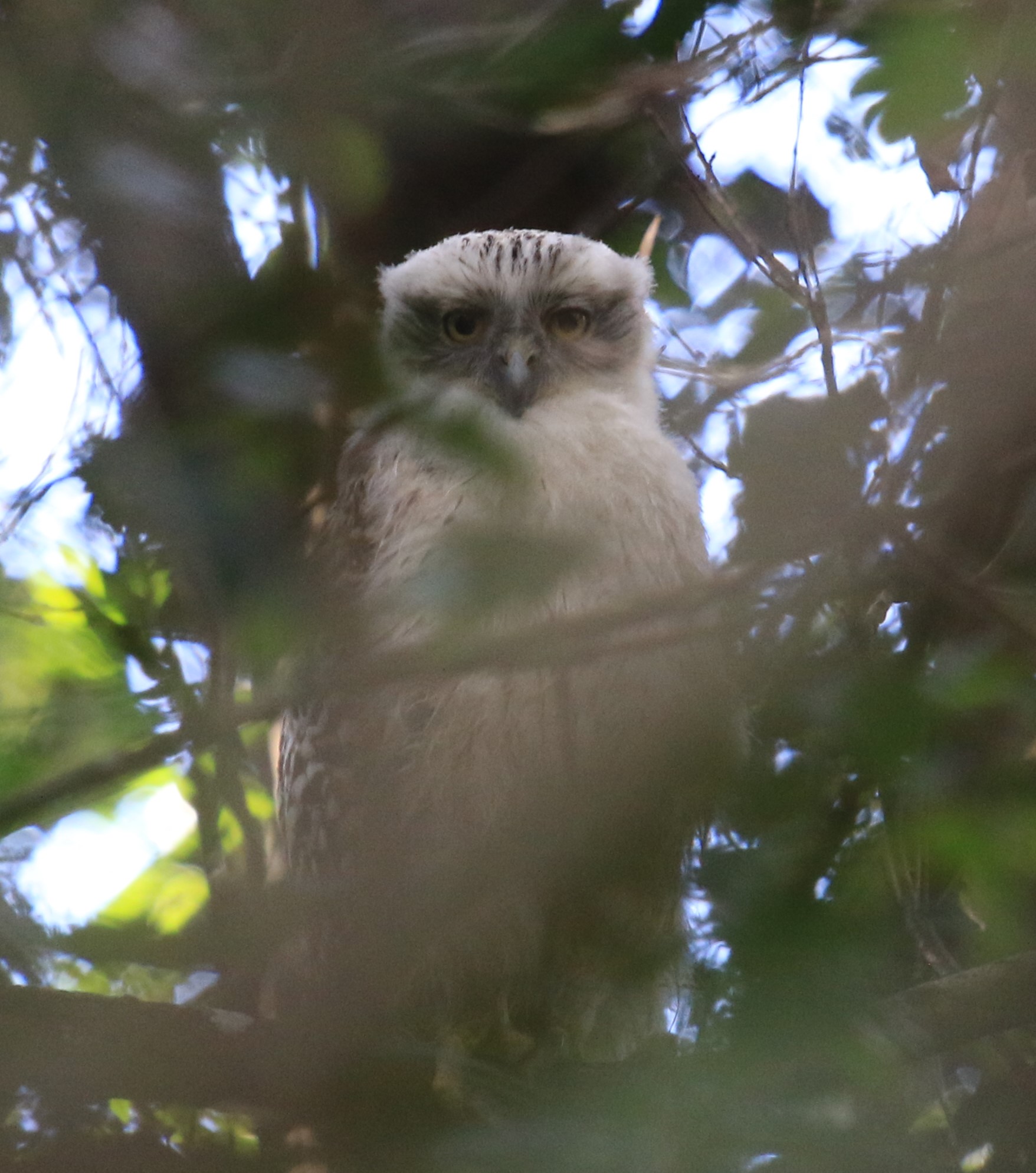
Mona Vale Road (East) Upgrade: Fauna Bridge Supports Installed
- safely install the fauna bridge supports
- minimise traffic disruptions
- reduce safety risks to workers and motorists.
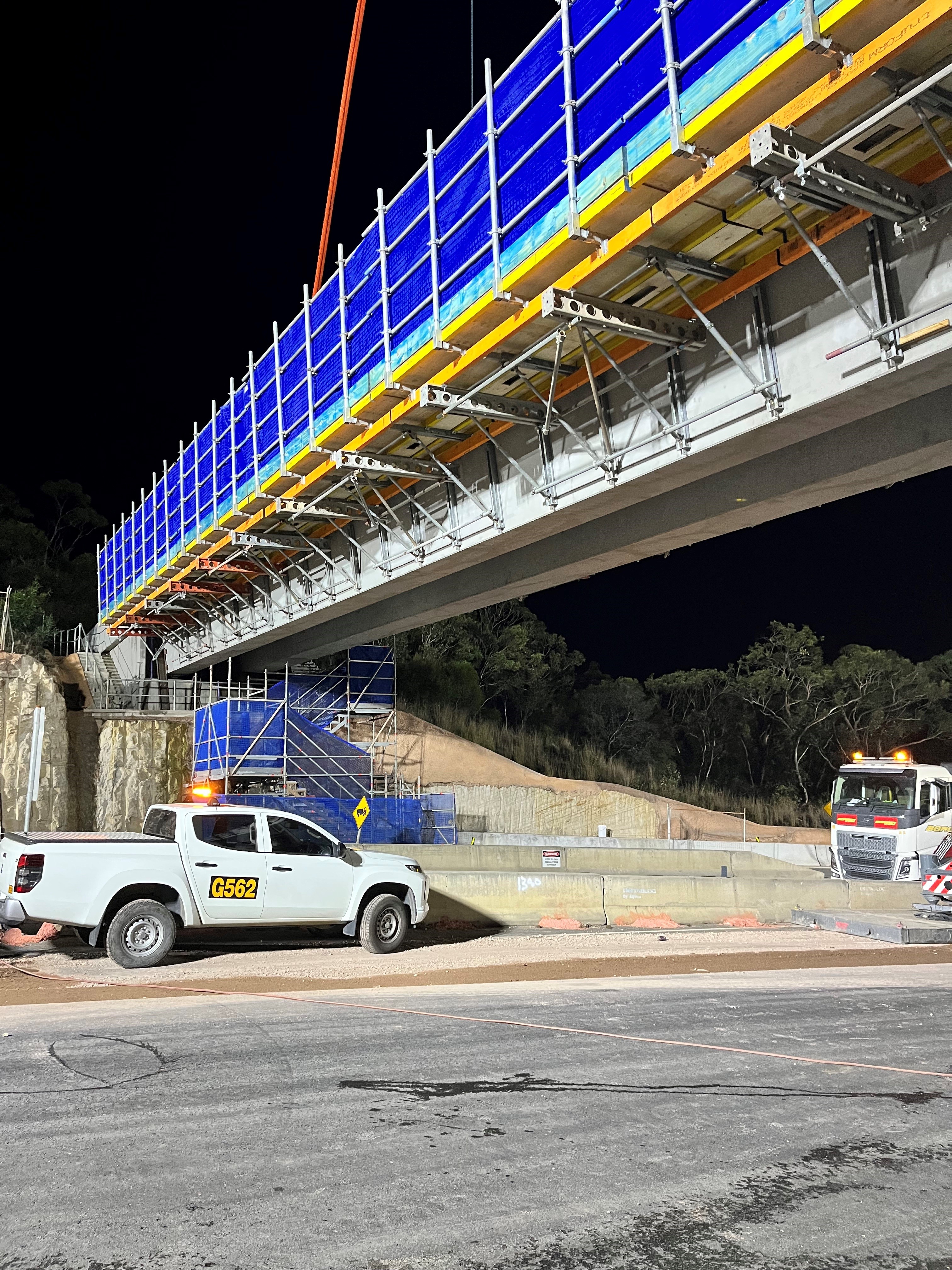
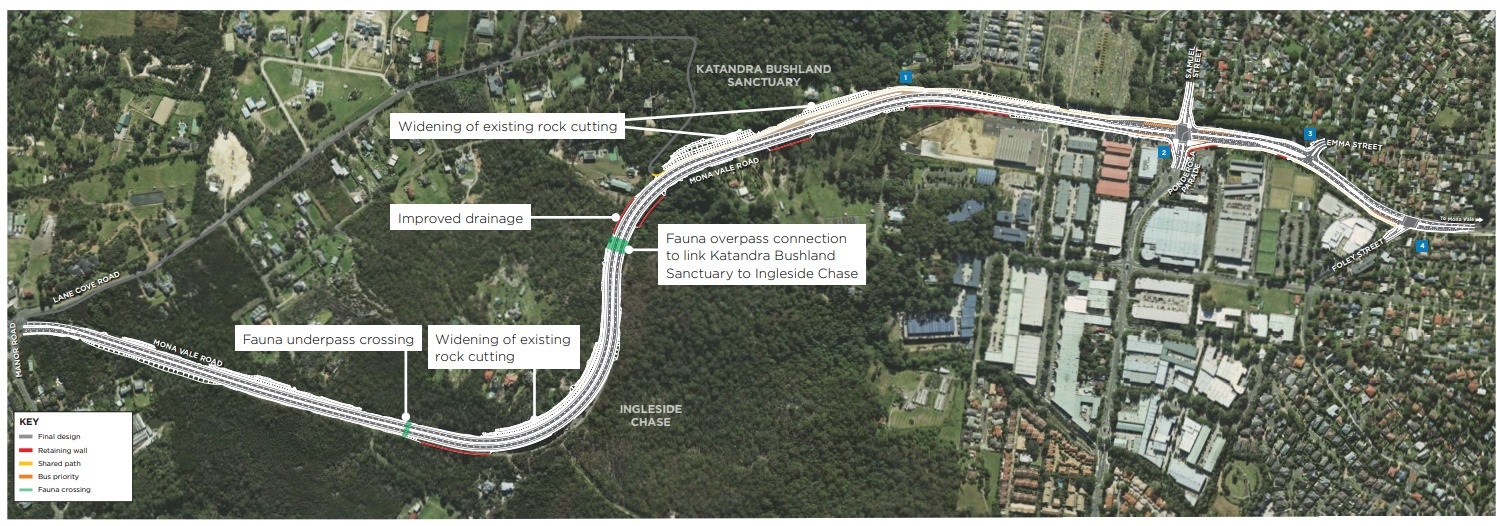
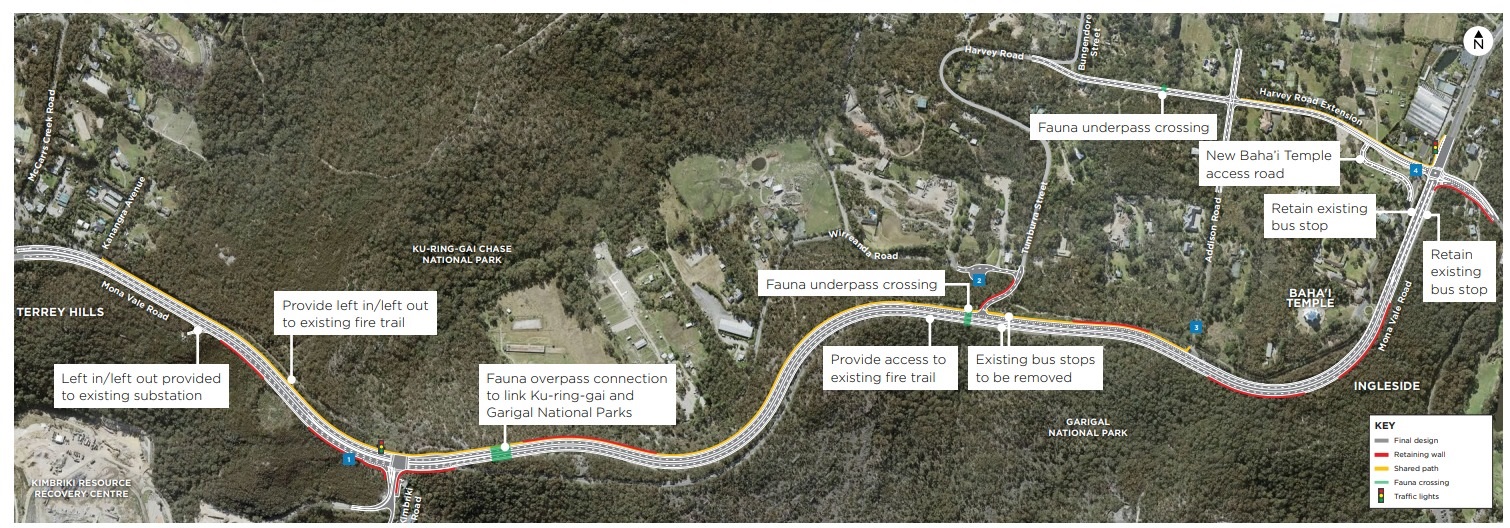

Photo: David Palmer, Jacqui Marlow and Marita Macrae celebrate the June 2019 announcement of a fauna bridge to be built over Mona Vale Rd East.
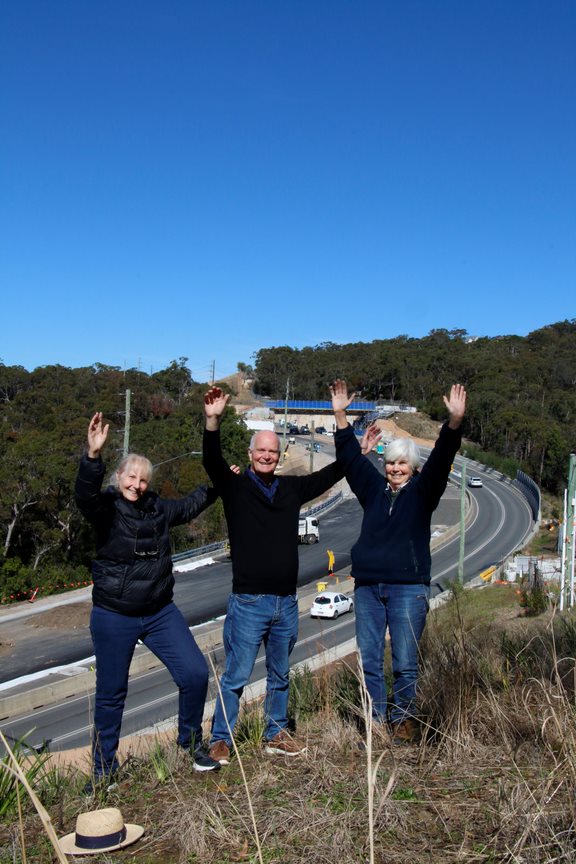
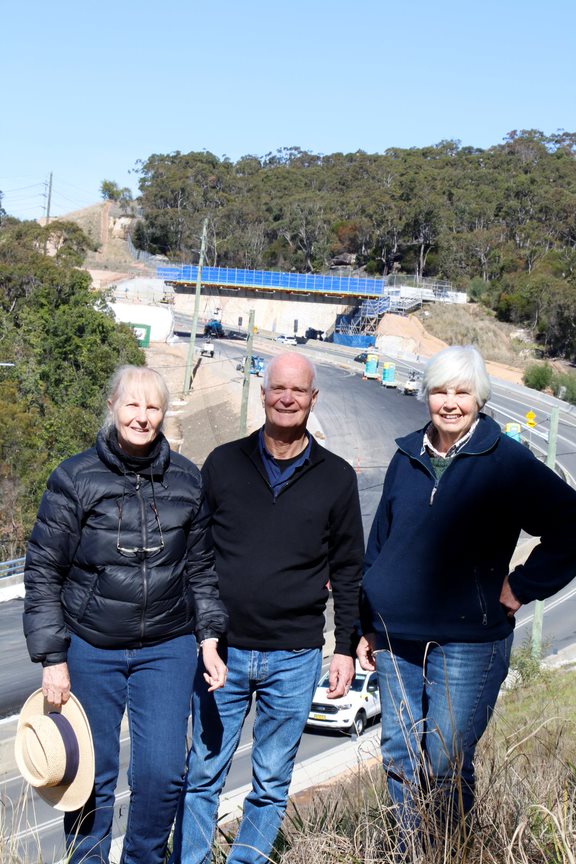
Photo: August 19 2023 - Jacqui Marlow, David Palmer and Marita Macrae celebrate the installation of the MVR East Upgrade fauna bridge supports.
The Wildlife Roadkill Prevention Association aims to reduce the roadkill of native animals on the Northern Beaches of Sydney, Australia. In 2005, the association was formed to address wildlife roadkill and raise awareness of broader conservation issues for our area.
The Pittwater Natural Heritage Association was formed to act to protect and preserve the Pittwater areas major and most valuable asset - its natural heritage.
Pittwater Natural Heritage Association seeks to raise awareness and provide information and advice to members on issues such as:
Native Tree Canopy
Identification of trees local to your particular area. What to plant to replace dead or dying trees, and how to care for trees. The characteristic form of the native tree canopy is a major contributor to Pittwater's sense of place.
"Bush Friendly" Gardens
Selecting plants for your garden that will live in harmony with nearby bushland and provide habitat for native animals and birds.
Building and Landscaping
Promoting practices which preserve and protect the visual qualities of the landform, preserve soil stability and prevent erosion of steep slopes and siltation of waterways.
Weed Infestation
Information on noxious and environmental weeds, weed identification and methods of control and eradication.
Living with Wildlife
Maintaining habitat and wildlife corridors for our rich and diverse native fauna. Understanding the impacts of introduced birds and animals and uncontrolled domestic pets.
Keeping our Waterways Healthy
Using and enjoying our waterways and estuaries whilst maintaining appropriate water quality and habitat for aquatic creatures. Caring for the streams, wetlands, saltmarsh and mangrove systems that are an integral part of our waterways.
Rock Platforms, Beaches and Dunes
Protecting and preserving the plant and animal communities on rock platforms. Restoration and regeneration of dune systems and maintenance of their stability.
Find out more and become a member at: https://pnha.org.au
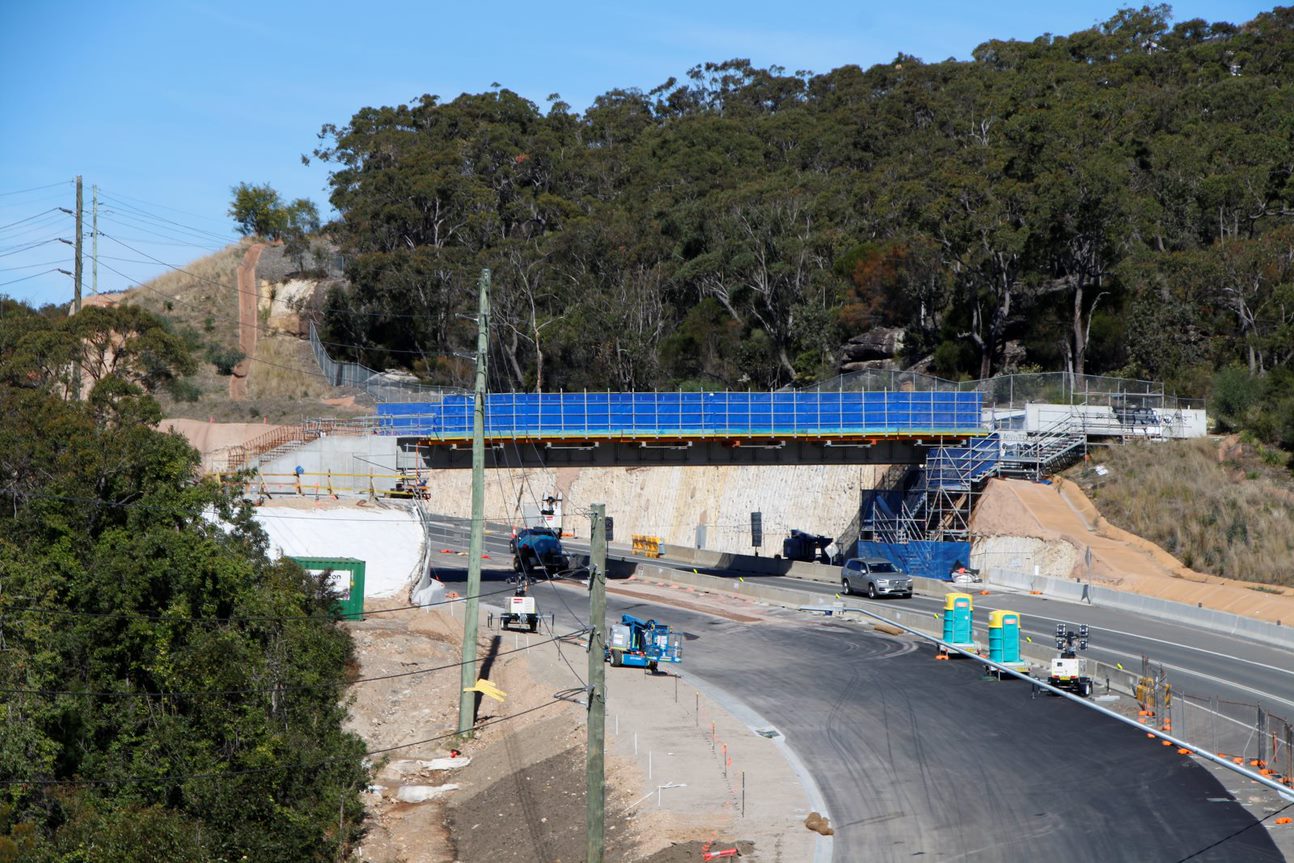
Above and below: how the fauna overpass looks now. Photos supplied.

Mother And Calf Southern Right Whales Expected To Take A Breather In Sydney Harbour This Weekend: Please Stay Away From Them
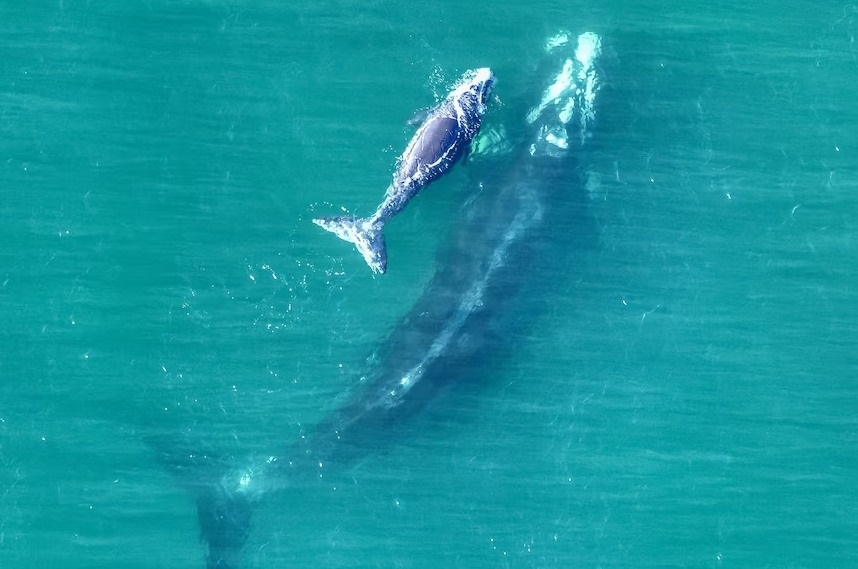 Sydneysiders may be welcoming 2 very rare and special visitors this weekend as the NSW National Parks and Wildlife Service (NPWS) waits to see if a mother-calf pair of Southern Right Whales will stop in for a rest in Sydney Harbour over coming days.
Sydneysiders may be welcoming 2 very rare and special visitors this weekend as the NSW National Parks and Wildlife Service (NPWS) waits to see if a mother-calf pair of Southern Right Whales will stop in for a rest in Sydney Harbour over coming days.Australian Wildlife Rehabilitation Conference 2023: Local Papers Presented
- Encourage and facilitate the organisation of regular national wildlife rehabilitation conferences around Australia
- Provide if requested, operational support to conference organising committees + Administer conference funds, including the interest-free "rolling loan" to conference organising committees
- Maintain the conference website between conferences, and disseminate conference information through the website
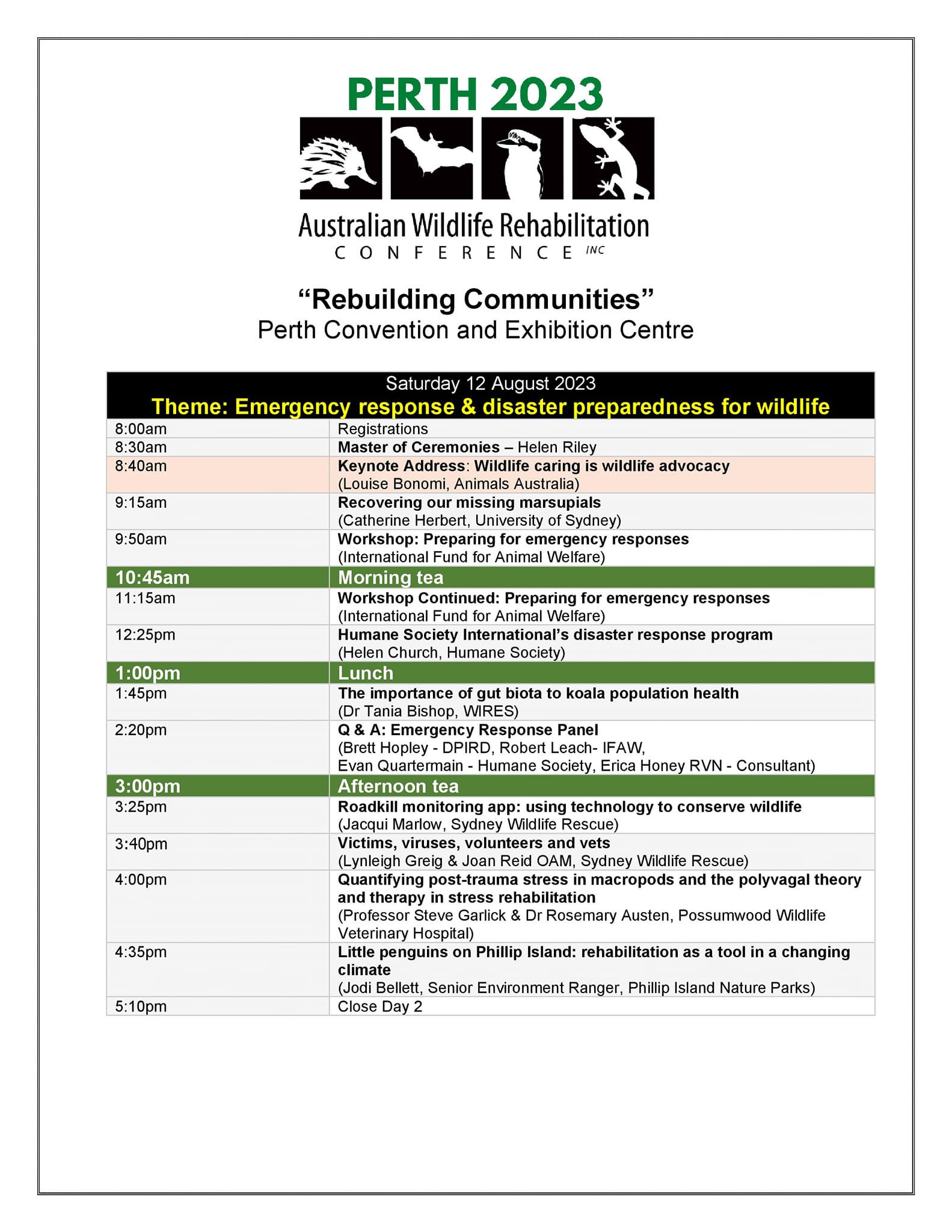
Joan Reid and Lynleigh Greig
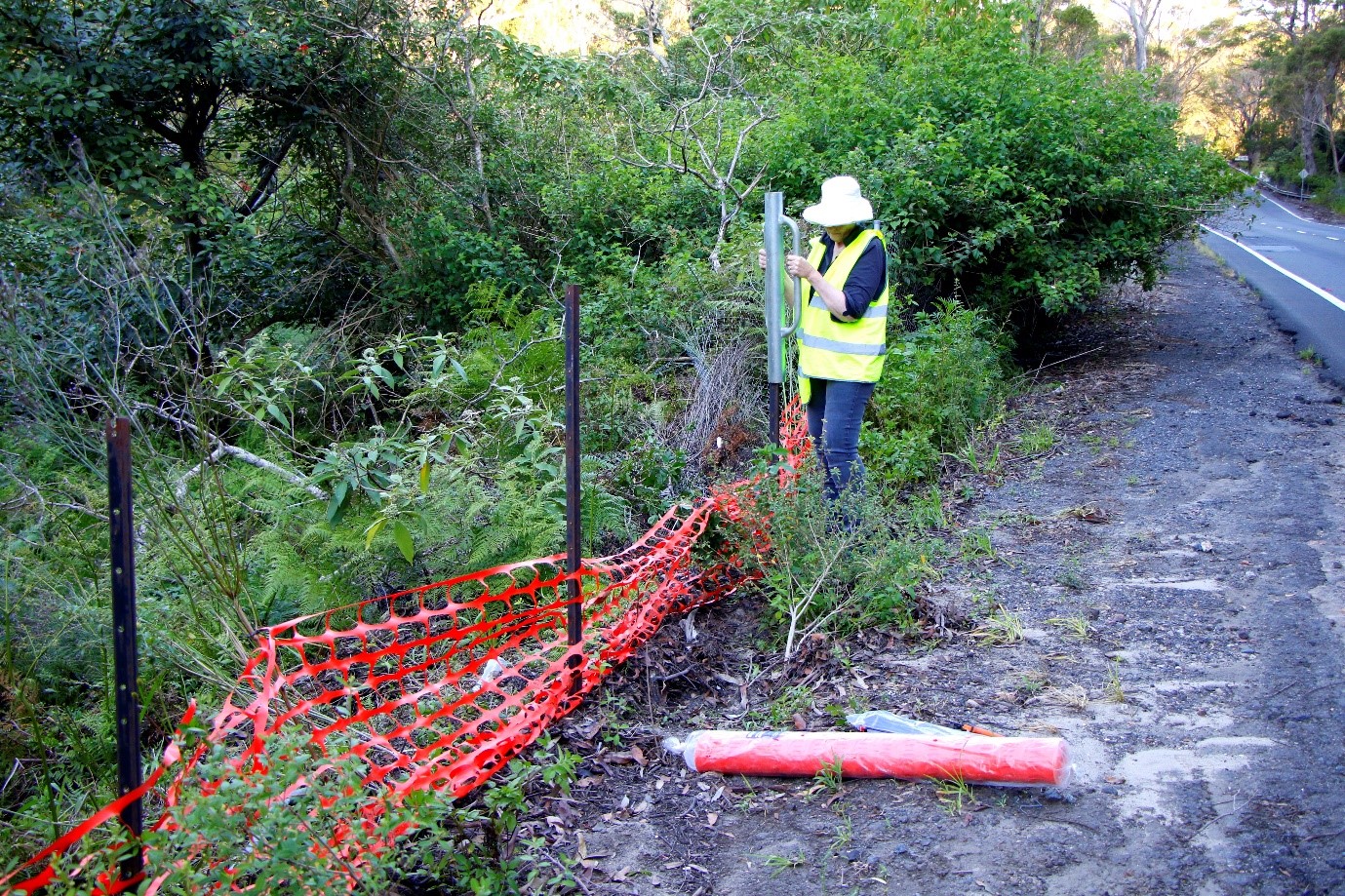
Jacqui Marlow repairing wildlife exclusion fencing on Wakehurst Parkway
Saving Native Species Grants
- 22 Birds
- 21 Mammals
- 9 Fish
- 6 Frogs
- 11 Reptiles
- 11 Invertebrates
- 30 Plants
Invitation For Public Comment: Mt Gilead Stage 2 Residential Development, Gilead, NSW (EPBC 2019/8587)
- Click here to download – EPBC 2019_8587 Mt Gilead Stage 2 Preliminary Documentation_AdequacyAssessment_Ver 3_20230720
- Click here to download – Appendix A_2019-8587 Referral
- Click here to download – Appendix B_EPBC 2019_8587 Decision notice 24FEB2020
- Click here to download – Appendix C_EPBC 2019_8587 PD Requirements_24FEB2020
- Click here to download – Appendix E_Lendlease SustainabilityPolicy
- Click here to download – Appendix F_cam-sustainability-framework-full-1
- Click here to download – Appendix G_ Australia-mission-zero-roadmap-summary
- Click here to download – Appendix H_MtGilead Stage2_Biocert_v8_20230718
- Click here to download – Appendix I_Draft Response Principles for Koala Protection in the Greater Macarthur and Wilton Growth Areas
- Click here to download – Appendix J_DPE Methodology to calculate Koala corridor widths
- Click here to download – Appendix K1_DPE Letter to Lendlease re Koala corridors – Dec 2021
- Click here to download – Appendix K2_DPE Indicative koala corridor map Gilead
- Click here to download – Appendix L_Koala_Conservation_at_Gilead_Lendlease 2022
- Click here to download – Appendix M_ Mount Gilead Stage 2 Koala Plan of Mgnt v4_20230720
- Click here to download – Appendix N_Mount Gilead Stage 2 EPBC CEMP V5_20230720_signed
- Click here to download – Appendix O – PMST Search – 2 February 2023
- Click here to download – Appendix P_EPBC Likelihood tables_v3-02022023
- Click here to download – Appendix Q_Koala Drone surveys Figtree Hill_Wild Conservation 2021
- Click here to download – Appendix R_Koala Drone Surveys Figtree Hill_Wild Conservation 2022
- Click here to download – Appendix S_PlotData_EPBCondition_20191009
- Click here to download – Appendix T_Flora Species List from plot data
- Click here to download – Appendix U_Naturalised Stormwater Strategy for Gilead_E2 Designs
- Click here to download – Appendix V_BioBankingCreditSummaryReport_Development_20230626
- Click here to download – Appendix W_BioBankingCreditSummaryReport_BiobankSite_20230626
- Click here to download – Gilead EPBC offset_CPW Step 1_Cond C_Ver 3_20230628
- Click here to download – Gilead EPBC offset_CPW Step 2_Cond A_Ver 3_20230628
- Click here to download – Gilead EPBC Offset_GHFF_Large-eared Pied Bat Offset Calculations_existing_Ver 3_20230628
- Click here to download – Gilead EPBC Offset_GHFF_Large-eared Pied Bat Offset Calculations_restored_Ver 3_20230628
- Click here to download – Gilead EPBC offset_Pomaderris_Vul_Ver 3_20220628
- Click here to download – Gilead EPBC offset_RFEF Step 1_Cond C_Ver 2_10112022
- Click here to download – Gilead EPBC offset_SSTF Step 1_ Cond A_Ver 3_20230628
- Click here to download – Gilead EPBC offset_SSTF Step 2_ Cond B_Ver 3_20230628
- Click here to download – Gilead EPBC offset_SSTF Step 3_Cond D_Ver 3_20230628
- Click here to download – Gilead_Koala Offset Calculations_Endangered_existing_Ver 3_20230628
- Click here to download – Gilead_Koala Offset Calculations_Endangered_restored_Ver 3_20230628
- Click here to download – Gilead_Koala Offset Calculations_Vulnerable_existing_Ver 3_20230628
- Click here to download – Gilead_Koala Offset Calculations_Vulnerable_restored_Ver 3_20230628
- Click here to download – Gilead_Quoll Offset Calculations_Vulnerable_existing_Ver 3_20230628
- Click here to download – Gilead_Quoll Offset Calculations_Vulnerable_restored_Ver 3_20230628
- Click here to download – Gilead_Quoll Offset Calculations_Vulnerable_Ver 2_10112022
- Click here to download – Gilead_Swift Parrot Offset Calculations_existing_CE_Ver 3_20230628
- Click here to download – Gilead_Swift Parrot Offset Calculations_restored_CE_Ver 3_20230628
Time Of Wiritjiribin
August
Female Lyre bird - Elanora Heights
Photo by Selena Griffith, May 29 2023
Selena says ''this one followed me along the path. Never been so close.''
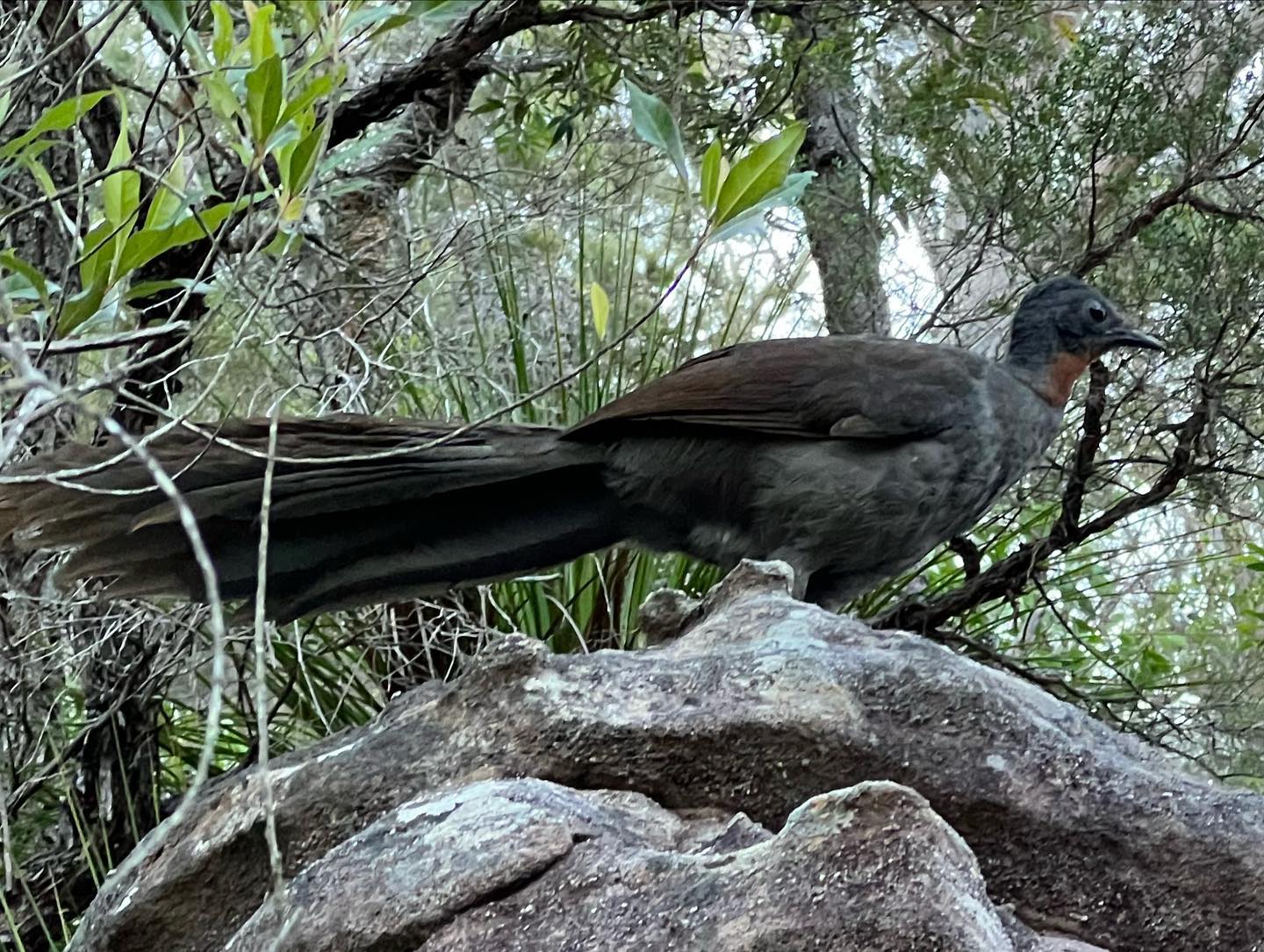
Bushcare Training Day At North Narrabeen
- Weed identification and best practice removal techniques
- Native plant identification and weed species including lookalikes
- Hands-on weed removal
- Bring along your unknown plant species for identification
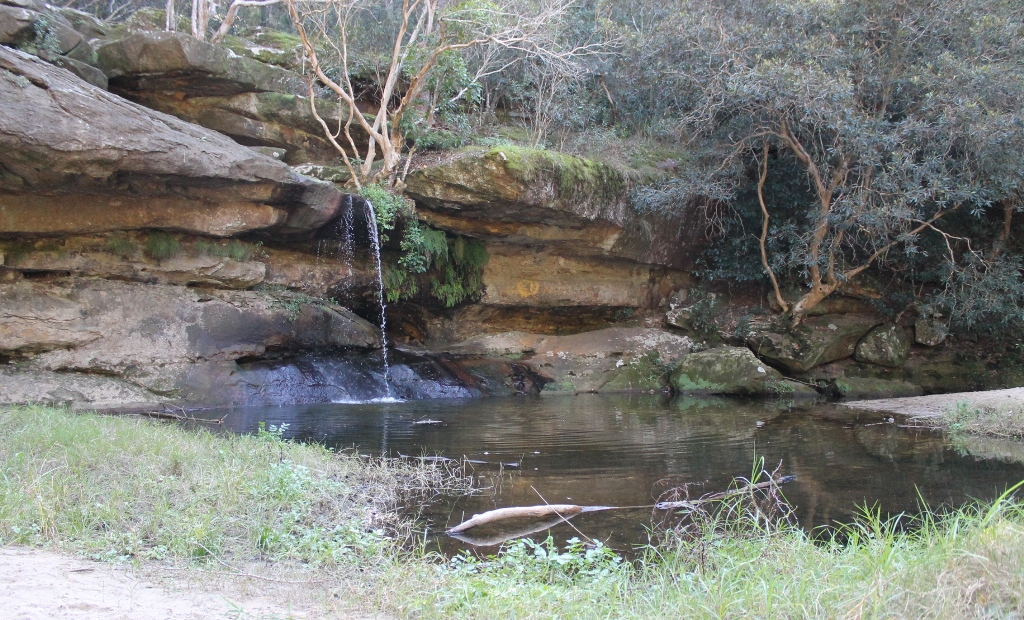
Palmgrove Park Avalon: New Bushcare Group Begins
 Palmgrove Park Avalon is a remnant of the Spotted Gum forest that was once widespread on the lower slopes of the Pittwater peninsula. This bushland’s official name and forest type is Pittwater and Wagstaffe Endangered Ecological Community, endangered because so much has been cleared for suburban development. Canopy trees, smaller trees and shrubs, and ground layer plants make up this community. Though scattered remnant Spotted Gums remain on private land, there is little chance of seedlings surviving in gardens and lawns. More information HERE
Palmgrove Park Avalon is a remnant of the Spotted Gum forest that was once widespread on the lower slopes of the Pittwater peninsula. This bushland’s official name and forest type is Pittwater and Wagstaffe Endangered Ecological Community, endangered because so much has been cleared for suburban development. Canopy trees, smaller trees and shrubs, and ground layer plants make up this community. Though scattered remnant Spotted Gums remain on private land, there is little chance of seedlings surviving in gardens and lawns. More information HERE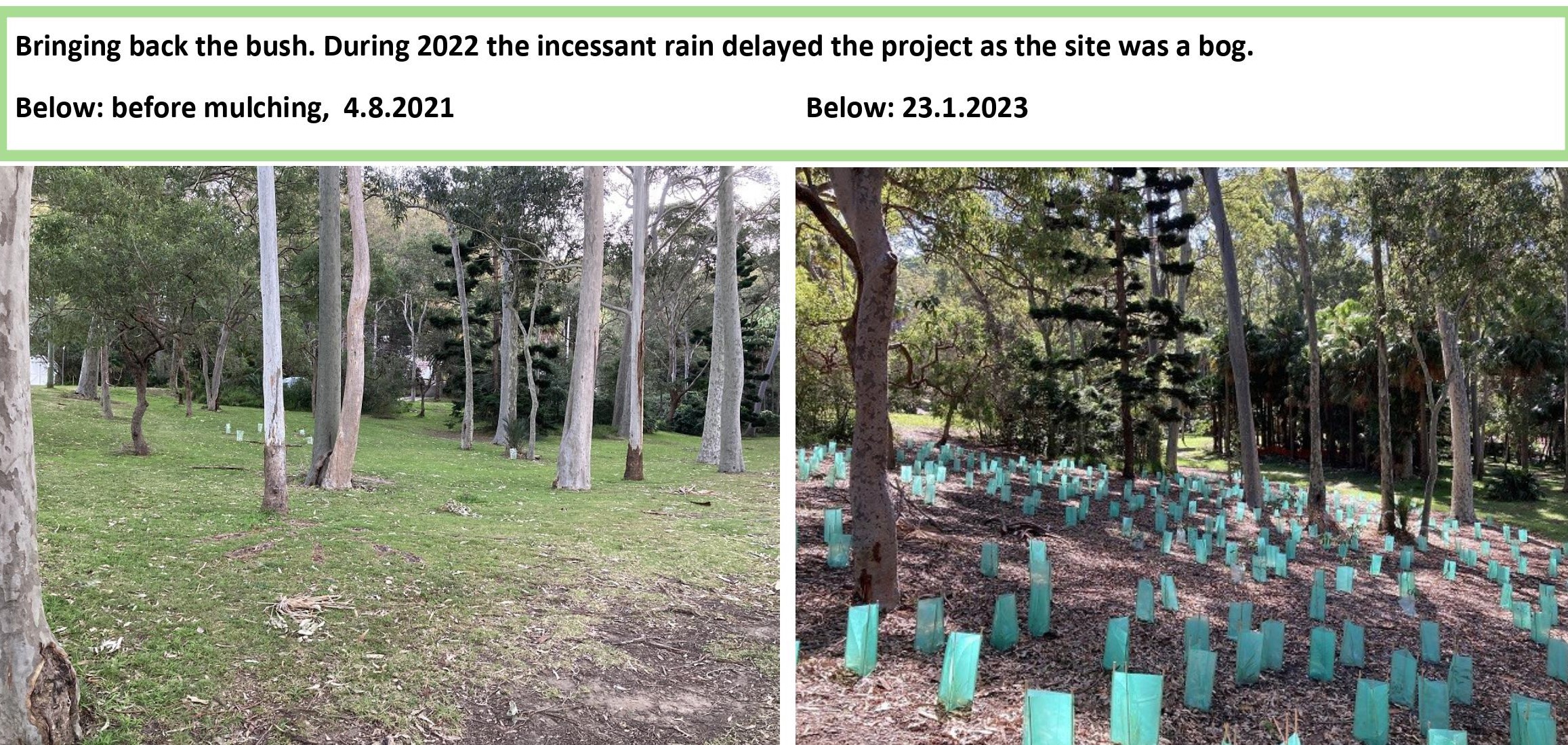
2023 Banksia Foundation NSW Sustainability Awards Open For Nominations
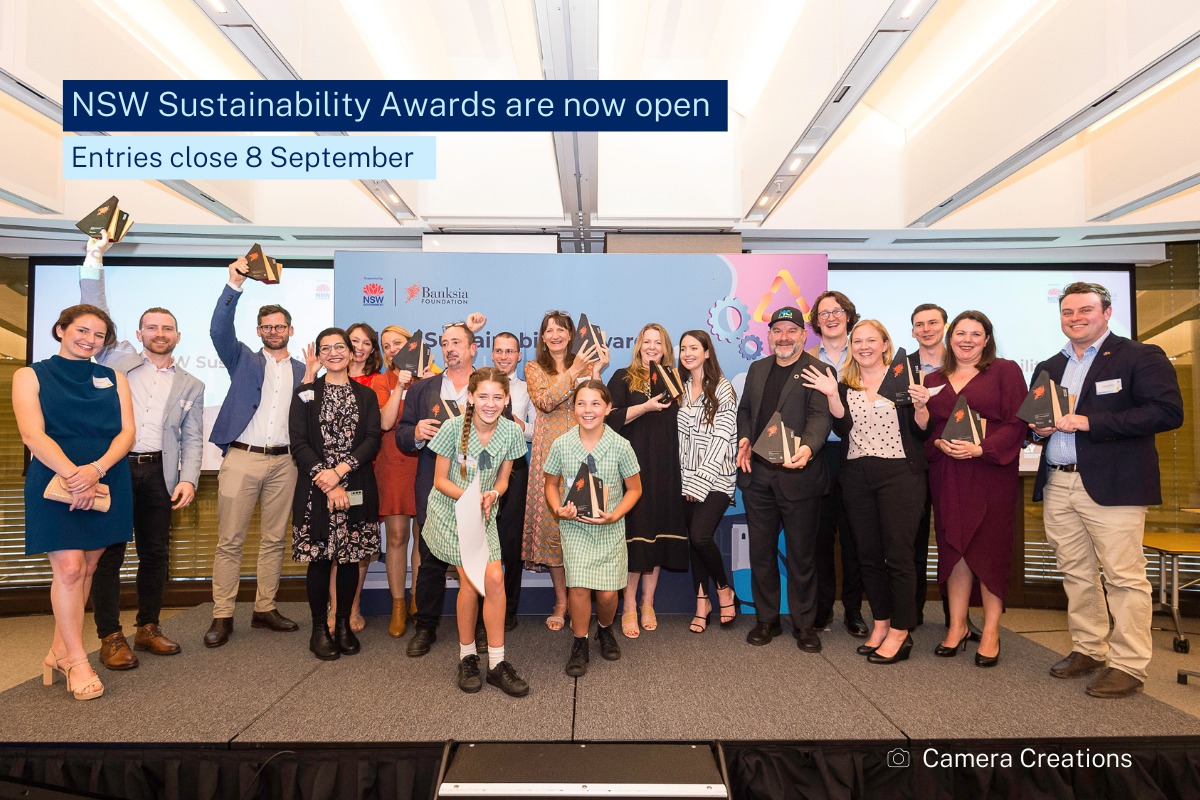
Pittwater Garage Sale Trail Returns: Repurpose Your Items

Northern Beaches Clean Up Crew: Sunday August 27 2023 From 10:00-12:15 - Turimetta Beach Clean Up
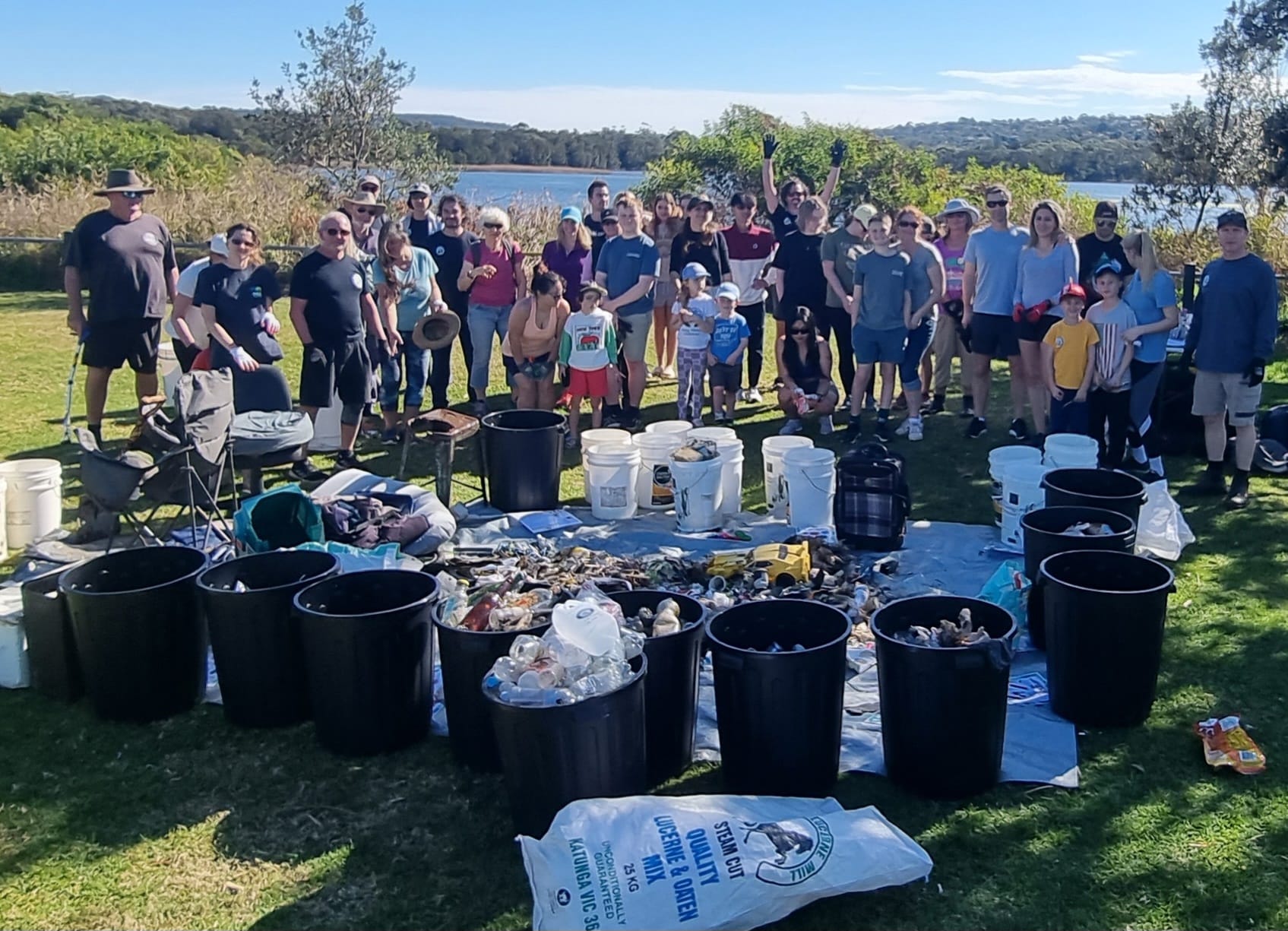
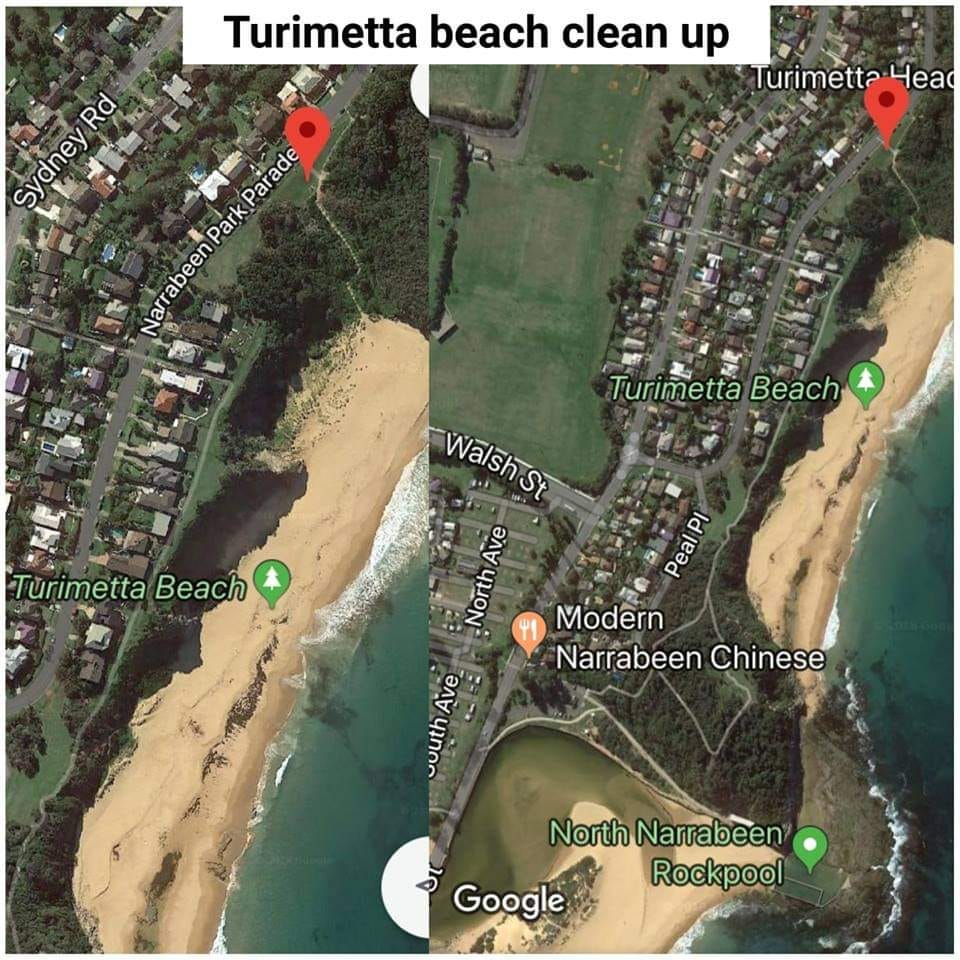
Waste And Sustainability In Schools NR37040: At Kimbriki
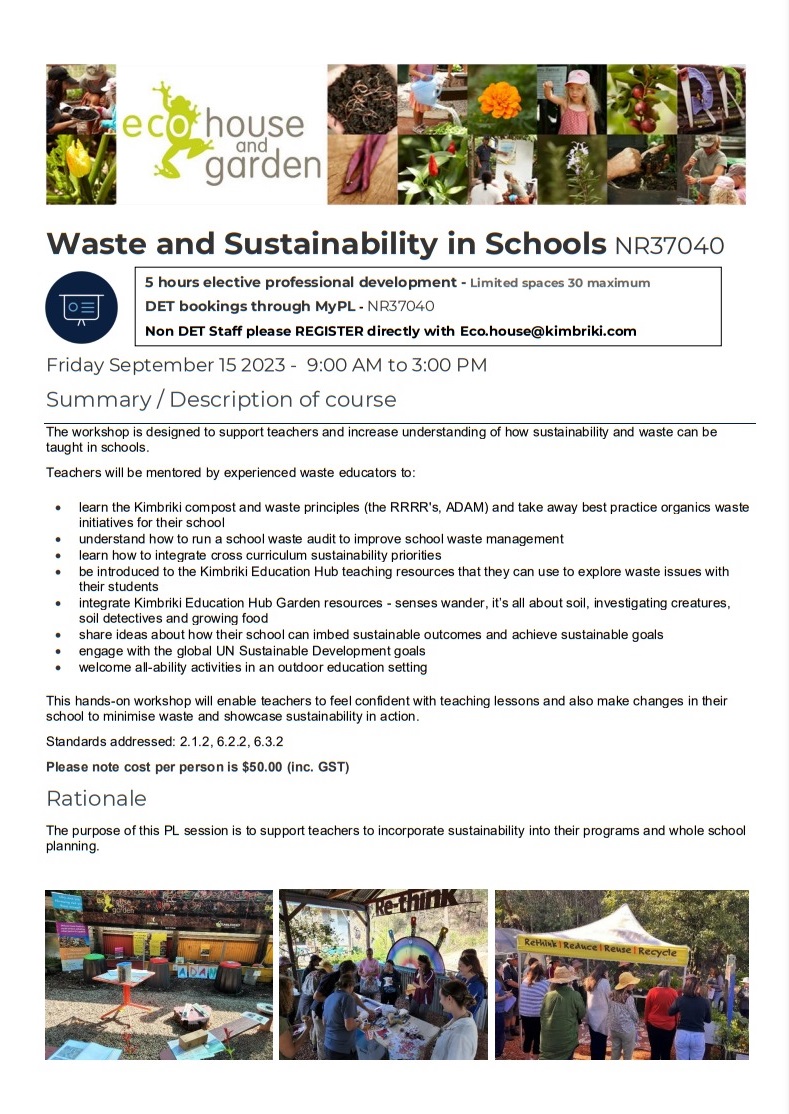
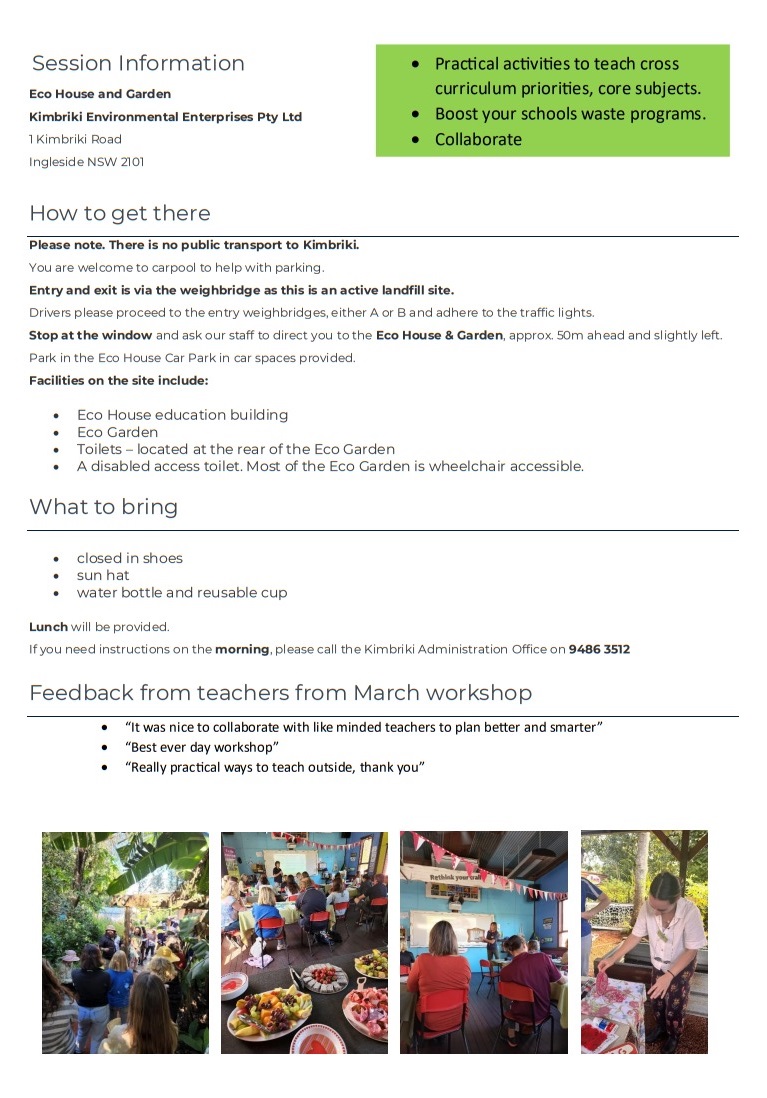
Stony Range Spring Festival 2023: Sunday September 10
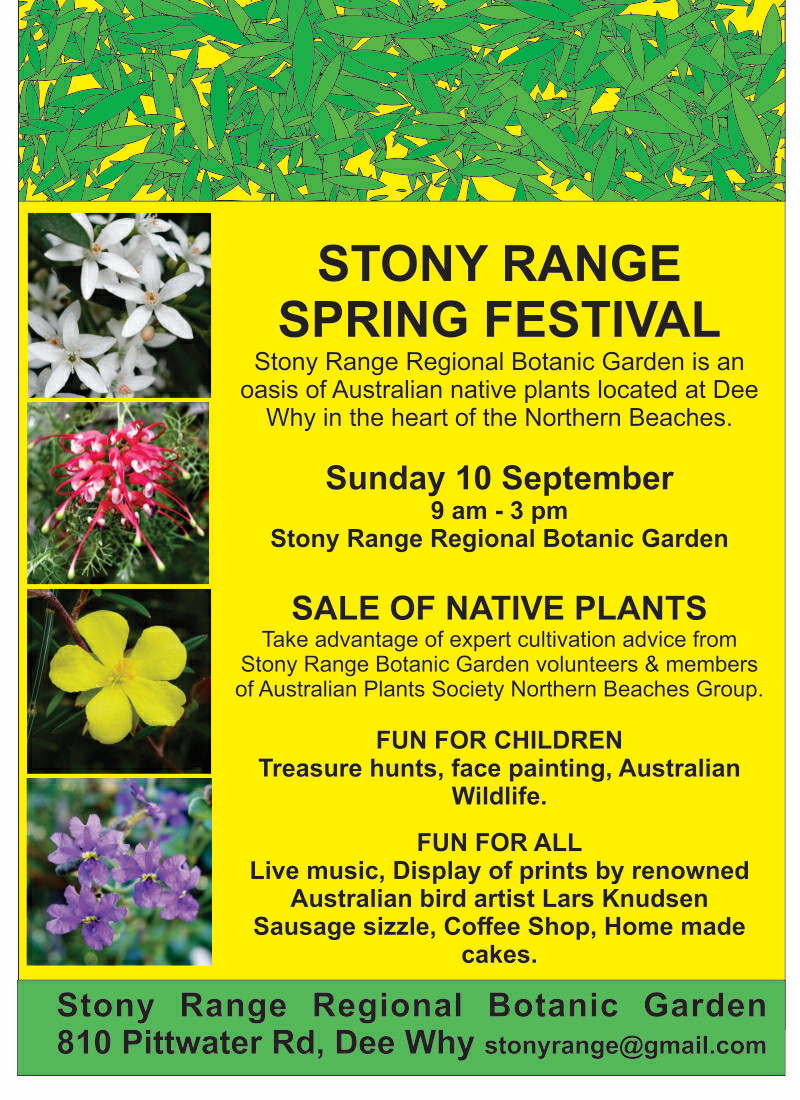
Seen Any Glossies Drinking Around Nambucca, Bellingen, Coffs Or Clarence? Want To Help?: Join The Glossy Squad
- a female bird (identifiable by yellow on her head) begging and/or being fed by a male (with plain black/brown head and body and unbarred red tail feathers)
- a lone adult male, or a male with a begging female, flying purposefully after drinking at the end of the day.

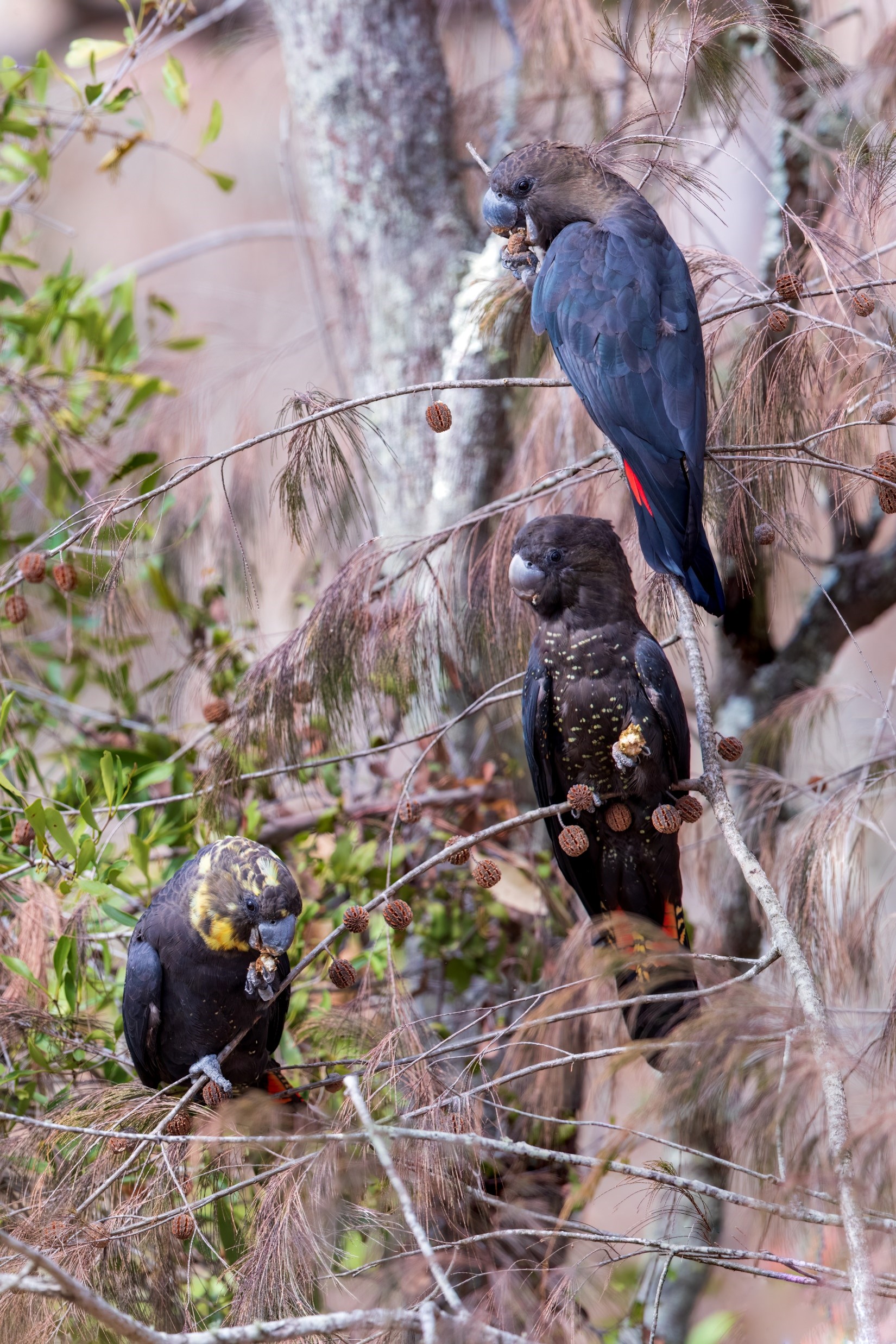
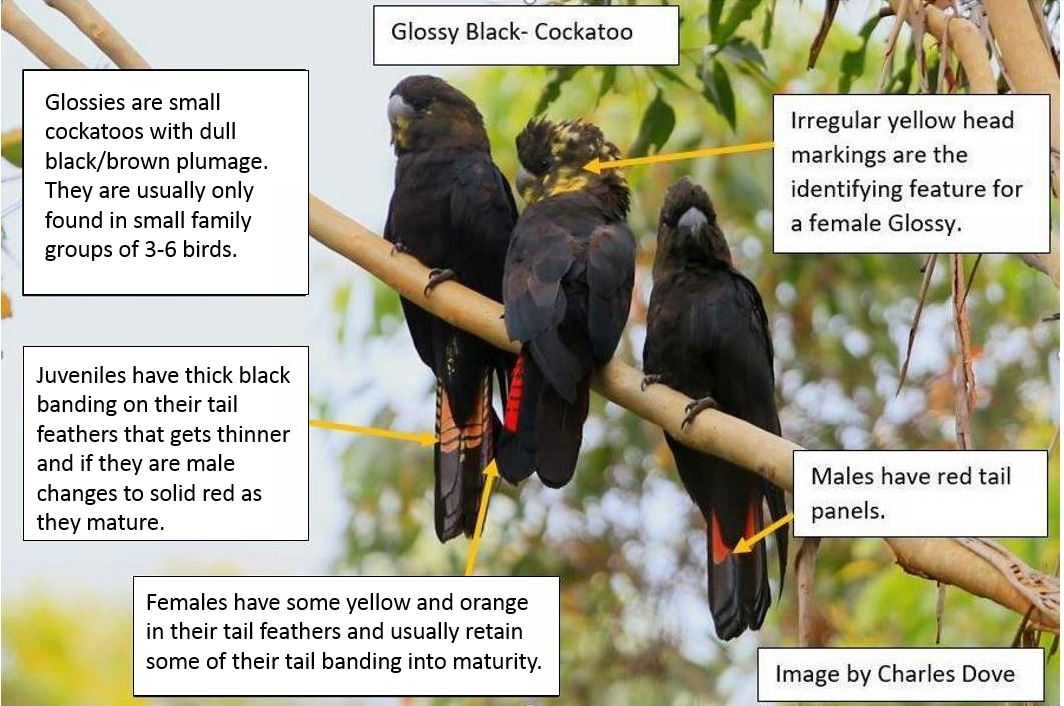
Department Of Planning And Environment To Become Two New Departments From January 1st 2024
Rising River Alert – Snowy River Below Jindabyne Dam
More Councils To Recycle Food And Garden Waste
$850,000 In Funding Open To Improve Fish Habitat
- removal or modification of barriers to fish passage
- rehabilitation of riparian lands (riverbanks, wetlands, mangrove forests, saltmarsh)
- re-snagging waterways with timber structure
- the removal of exotic vegetation from waterways and replacement with native plants
- bank stabilisation works
- fencing to exclude livestock.
Alcohol Washing Confirms New Varroa Detection Near Kempsey
- Ensure they are registered
- Not move hives from their current location
- Report the location of those hives to NSW DPI
- Undertake mandatory alcohol washes on their hives at least every 16-weeks and report the results to NSW DPI within 7 days.

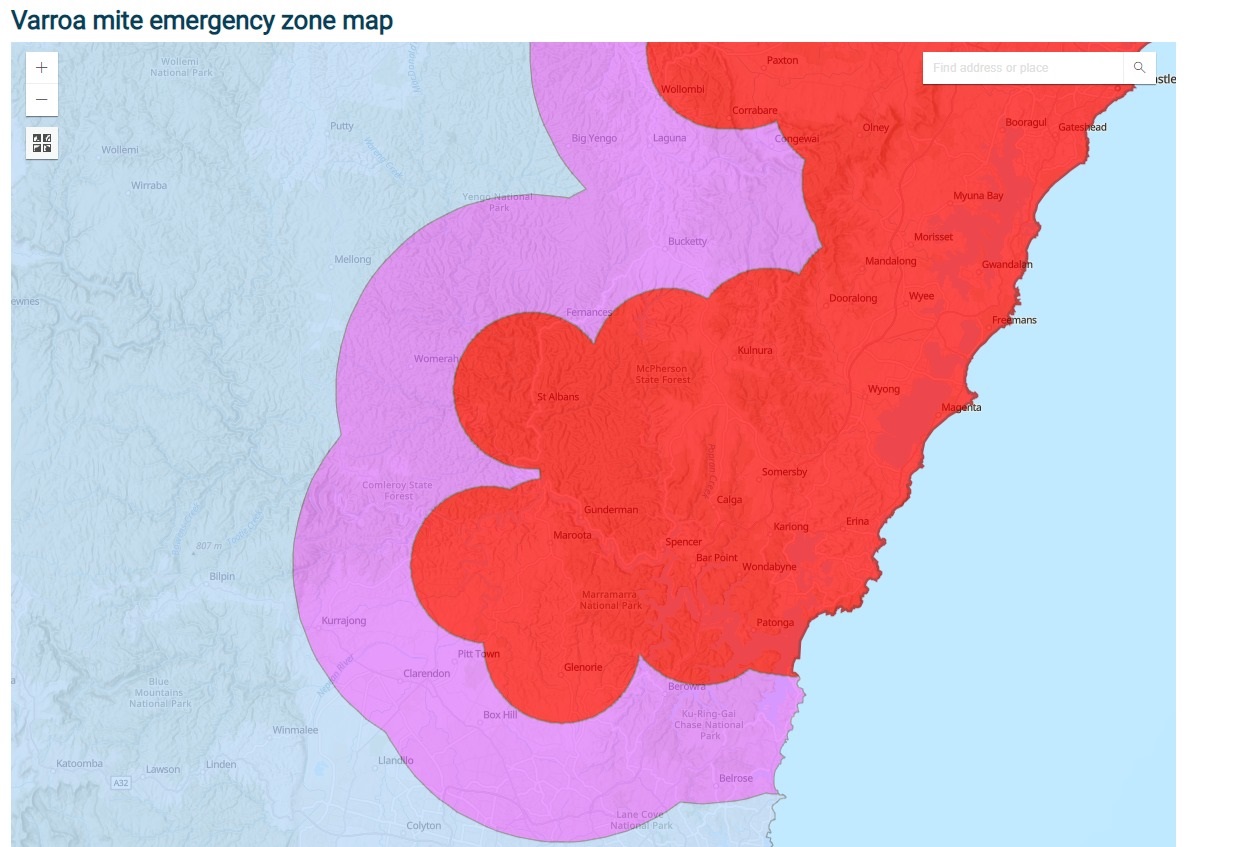
Blue Mountains National Park And Kanangra-Boyd National Park Draft Plan Of Management: Public Consultation
- improving recognition of the parks significant values, including World and National Heritage values, and providing for adaptive management to protect the values
- recognising and supporting the continuation of partnerships with Aboriginal communities
- providing outstanding nature-based experiences for visitors through improvements to visitor facilities - including:
- Opportunities for supported or serviced camping, where tents and services are provided by commercial tour operators, may be offered at some camping areas in the parks
- Jamison Creek, Jamison Valley Walk-in camping Potential new camping
- Leura Amphitheatre Jamison Valley Walk-in camping Potential new camping
- Mount Solitary Jamison Valley Walk-in camping Potential new camping
- Maxwell’s HuC Kedumba Valley Cabin/hut Potential new accommodation
- Kedumba Valley Maxwell’s Hut (historic slab hut) - Building restoration in progress; potential new Accommodation for bushwalkers
- Government Town Police station; courthouse - Potential new Visitor accommodation
- write clearly and be specific about the issues that are of concern to you
- note which part or section of the document your comments relate to
- give reasoning in support of your points - this makes it easier for us to consider your ideas and will help avoid misinterpretation
- tell us specifically what you agree/disagree with and why you agree or disagree
- suggest solutions or alternatives to managing the issue if you can.
Plans For New Wind Energy Project At Spicers Creek On Public Exhibition
Nauseous Territory: Outfoxing Predators Using Baits That Make Them Barf
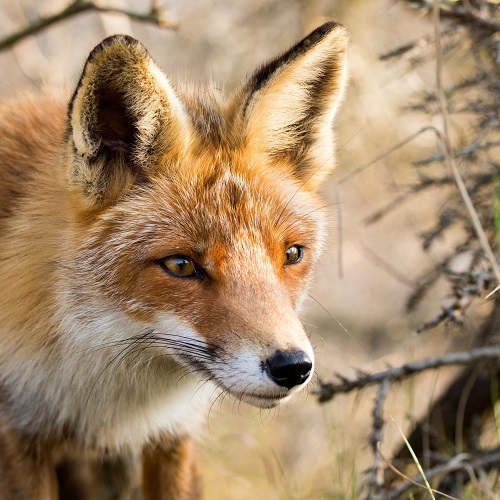 Introduced foxes, dogs, cats, rats, and other predators kill millions of native animals every year, but what if they were conditioned to associate this prey with food that made them ill?
Introduced foxes, dogs, cats, rats, and other predators kill millions of native animals every year, but what if they were conditioned to associate this prey with food that made them ill?Areas Closed For West Head Lookout Upgrades
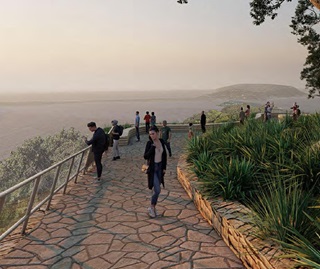 NPWS advise that the following areas are closed from Monday 22 May to Thursday 30 November 2023 while West Head lookout upgrades are underway:
NPWS advise that the following areas are closed from Monday 22 May to Thursday 30 November 2023 while West Head lookout upgrades are underway:
- West Head lookout
- The loop section of West Head Road
- West Head Army track.
Vehicles, cyclists and pedestrians will have access to the Resolute picnic area and public toilets. Access is restricted past this point.
The following walking tracks remain open:
- Red Hands track
- Aboriginal Heritage track
- Resolute track, including access to Resolute Beach and West Head Beach
- Mackeral Beach track
- Koolewong track.
The West Head lookout cannot be accessed from any of these tracks.
Image: Visualisation of upcoming works, looking east from the ramp towards Barrenjoey Head Credit: DPE
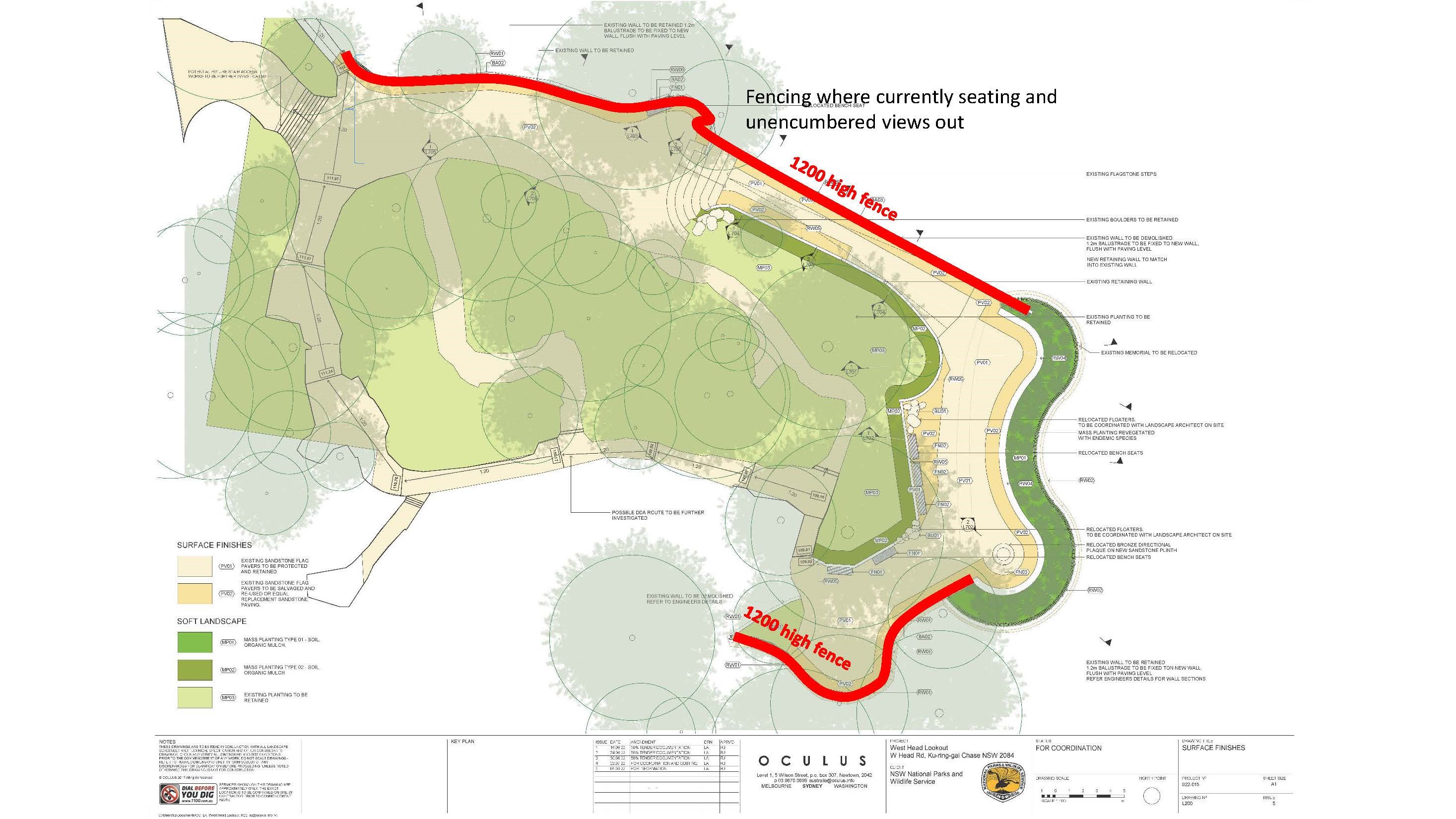
Bush Turkeys: Backyard Buddies Breeding Time Commences In August - BIG Tick Eaters - Ringtail Posse Insights
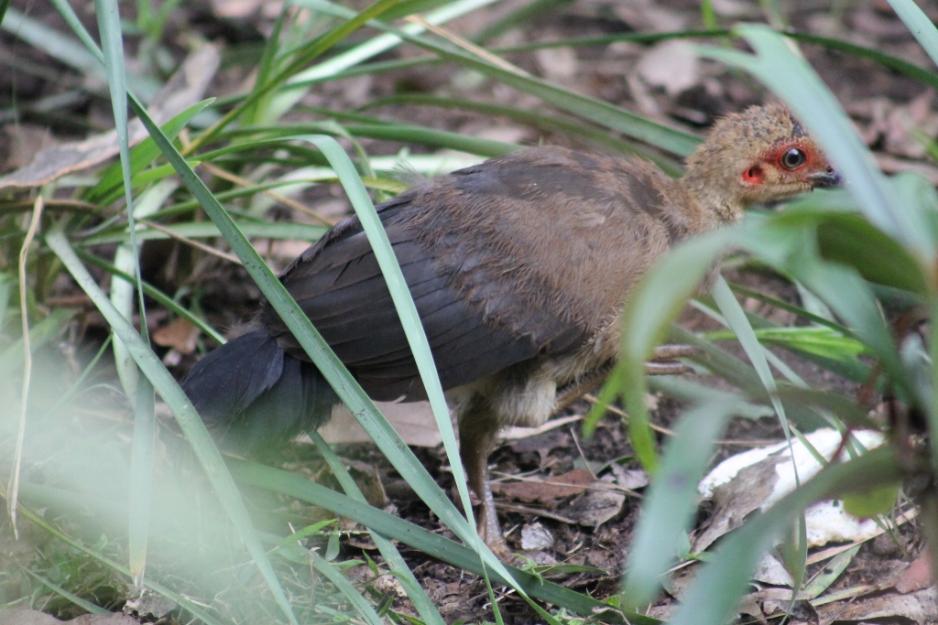
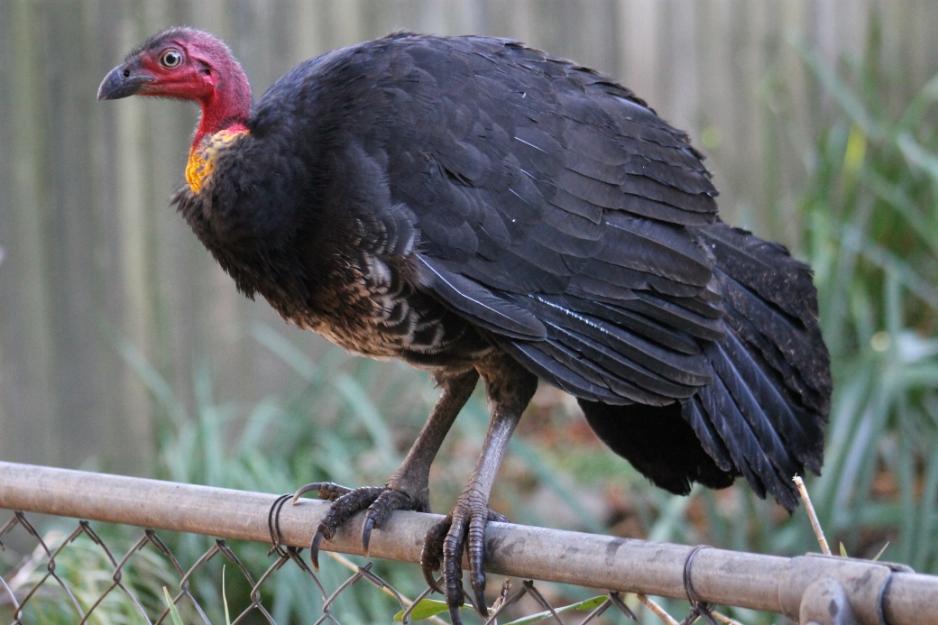
PNHA Guided Nature Walks 2023
Our walks are gentle strolls, enjoying and learning about the bush rather than aiming for destinations. Wear enclosed shoes. We welcome interested children over about 8 years old with carers. All Welcome.
So we know you’re coming please book by emailing: pnhainfo@gmail.com and include your phone number so we can contact you if weather is doubtful.
The whole PNHA 2023 Guided Nature Walks Program is available at: http://pnha.org.au/test-walks-and-talks/
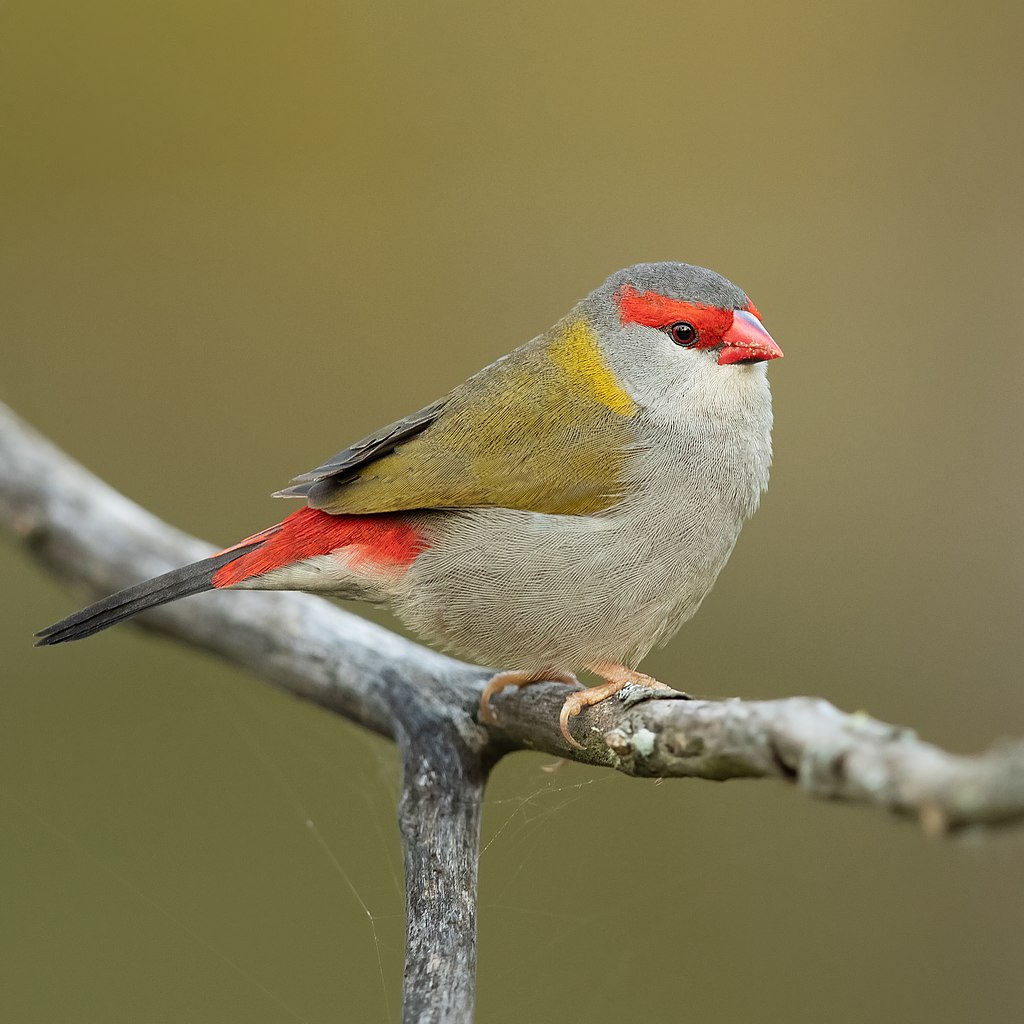
Red-browed finch (Neochmia temporalis). Photo: J J Harrison
Bushcare In Pittwater
Where we work Which day What time
Avalon
Angophora Reserve 3rd Sunday 8:30 - 11:30am
Avalon Dunes 1st Sunday 8:30 - 11:30am
Avalon Golf Course 2nd Wednesday 3 - 5:30pm
Careel Creek 4th Saturday 8:30 - 11:30am
Toongari Reserve 3rd Saturday 9 - 12noon (8 - 11am in summer)
Bangalley Headland 2nd Sunday 9 to 12noon
Bayview
Winnererremy Bay 4th Sunday 9 to 12noon
Bilgola
North Bilgola Beach 3rd Monday 9 - 12noon
Algona Reserve 1st Saturday 9 - 12noon
Plateau Park 1st Friday 8:30 - 11:30am
Church Point
Browns Bay Reserve 1st Tuesday 9 - 12noon
McCarrs Creek Reserve Contact Bushcare Officer To be confirmed
Clareville
Old Wharf Reserve 3rd Saturday 8 - 11am
Elanora
Kundibah Reserve 4th Sunday 8:30 - 11:30am
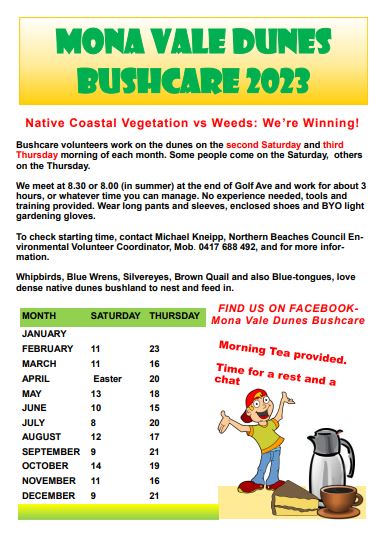 Mona Vale
Mona Vale Mona Vale Beach Basin 1st Saturday 8 - 11am
Mona Vale Dunes 2nd Saturday +3rd Thursday 8:30 - 11:30am
Newport
Bungan Beach 4th Sunday 9 - 12noon
Crescent Reserve 3rd Sunday 9 - 12noon
North Newport Beach 4th Saturday 8:30 - 11:30am
Porter Reserve 2nd Saturday 8 - 11am
North Narrabeen
Irrawong Reserve 2nd Saturday 2 - 5pm
Palm Beach
North Palm Beach Dunes 3rd Saturday 9 - 12noon
Scotland Island
Catherine Park 2nd Sunday 10 - 12:30pm
Elizabeth Park 1st Saturday 9 - 12noon
Pathilda Reserve 3rd Saturday 9 - 12noon
Warriewood
Warriewood Wetlands 1st Sunday 8:30 - 11:30am
Whale Beach
Norma Park 1st Friday 9 - 12noon
Western Foreshores
Coopers Point, Elvina Bay 2nd Sunday 10 - 1pm
Rocky Point, Elvina Bay 1st Monday 9 - 12noon
Friends Of Narrabeen Lagoon Catchment Activities

Gardens And Environment Groups And Organisations In Pittwater
Report Fox Sightings
%20(1).jpg?timestamp=1675893929686)
Marine Wildlife Rescue Group On The Central Coast
A new wildlife group was launched on the Central Coast on Saturday, December 10, 2022.
Marine Wildlife Rescue Central Coast (MWRCC) had its official launch at The Entrance Boat Shed at 10am.
The group comprises current and former members of ASTR, ORRCA, Sea Shepherd, Greenpeace, WIRES and Wildlife ARC, as well as vets, academics, and people from all walks of life.
Well known marine wildlife advocate and activist Cathy Gilmore is spearheading the organisation.
“We believe that it is time the Central Coast looked after its own marine wildlife, and not be under the control or directed by groups that aren’t based locally,” Gilmore said.
“We have the local knowledge and are set up to respond and help injured animals more quickly.
“This also means that donations and money fundraised will go directly into helping our local marine creatures, and not get tied up elsewhere in the state.”
The organisation plans to have rehabilitation facilities and rescue kits placed in strategic locations around the region.
MWRCC will also be in touch with Indigenous groups to learn the traditional importance of the local marine environment and its inhabitants.
“We want to work with these groups and share knowledge between us,” Gilmore said.
“This is an opportunity to help save and protect our local marine wildlife, so if you have passion and commitment, then you are more than welcome to join us.”
Marine Wildlife Rescue Central Coast has a Facebook page where you may contact members. Visit: https://www.facebook.com/profile.php?id=100076317431064
- Ph: 0478 439 965
- Email: marinewildlifecc@gmail.com
- Instagram: marinewildliferescuecc

Watch Out - Shorebirds About
.JPG.opt1460x973o0,0s1460x973.jpg?timestamp=1663629195339)
Possums In Your Roof?: Do The Right Thing

Aviaries + Possum Release Sites Needed

Trapped: Australia’s extraordinary alpine insects are being marooned on mountaintops as the world warms

We may not pay invertebrates much thought, but they’re the workhorses of all ecosystems. Insects and other invertebrates do essential jobs such as pollinating plants, improving soils and controlling pests. They’re also food for many larger animals, which moves nutrients up the food chain.
Invertebrates are vulnerable to rising global temperatures. In response to climate change, many are moving to cooler areas, be that across land towards the poles, or upward in elevation.
But not all invertebrates have that option. In Australia, invertebrates already living at the highest possible elevation – on mountain summits – have nowhere higher to go. So how will they cope? And how can we help them?
Answering these questions is important. Invertebrates underpin Earth’s ecosystems – so if their numbers decline, the ecological damage will be felt far and wide.
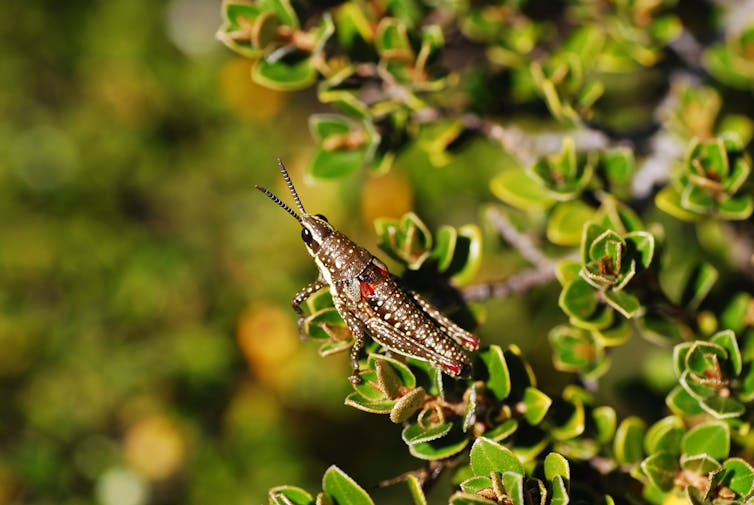
A Life At The Top
The invertebrates of the Australian Alps are beautiful and diverse. As in all ecosystems, they make up the largest proportion of our alpine animal species.
Most of our alpine invertebrates are found nowhere else If we don’t look after them they’re gone forever. And each species extinction is like losing a rivet in an aeroplane wing; eventually whole ecosystems will crash.
Warmer temperatures can affect invertebrates in many ways. For example, pollinating insects that collect nectar may hatch before plants flower – creating issues for both the insects and the plants. Species that rely on wet or damp conditions may find their habitat dried out. Less harsh, cold conditions may also bring new predators and competitors into their habitats.
Overseas, where mountain ranges are typically much higher, animals have been moving up in elevation to survive. But Australia’s mountains are small – less than half the height of many key mountain ranges overseas. This leaves little room to move higher.
Alpine invertebrates tend to live in small, isolated populations on mountain tops. This limits their genetic diversity and therefore the potential that offspring can survive and adapt to changing conditions.
What’s more, many invertebrates don’t have wings, so can’t fly away to a more hospitable place. And being trapped on mountain tops also makes them vulnerable to devastating local threats such as unusually severe or extensive bushfires.
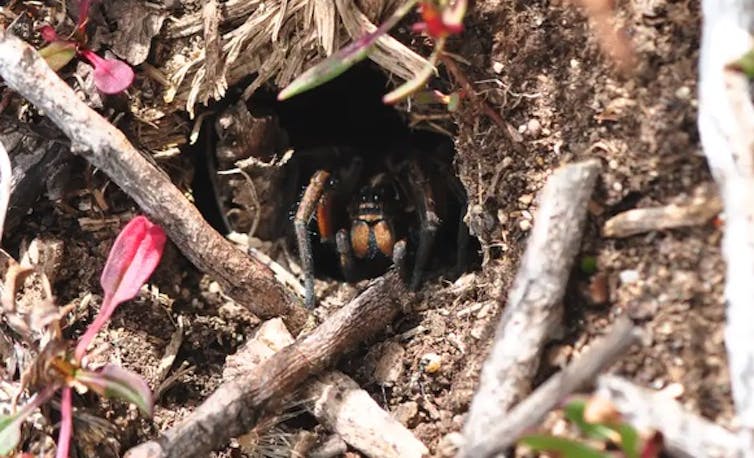
Extraordinary Bogong Moths
Some species might seem to be moving higher up the Australian Alps. For example, it seems bogong moths inhabit low elevation caves less frequently than they once did. But this probably just shows the species’ habitat is shrinking upward.
Each year, bogong moths undertake an extraordinary nocturnal migration. From their starting point many hundreds of kilometres away, they use the stars and Earth’s magnetic field to navigate to the Australian Alps in search of cool caves and rock crevices. There, they rest and take refuge from the summer heat, before returning to their winter pastures.
In 2021, bogong moths were listed as endangered because the availability of their summer habitat is declining.
Bogong moths bring an incredibly important influx of nutrients to the alps. They provide food for many animals, including the adorable, critically endangered mountain pygmy possum, as well as many types of birds.
The Taungurung people refer to the bogong moth as “Deberra”. The annual concentration of Deberra in the alps is culturally significant to the Taungurung and other traditional custodians.
Deberra have a high fat content and were harvested by Taungurung and other groups for eating. During the harvest, large gatherings of many Aboriginal nations were held and cultural business was conducted.
So Deberra offers not only a rich source of food, but also connection with deeply significant cultural landscapes. They are an important element in the cyclical movement of people and exchange of knowledge within and between Indigenous nations.
For Traditional Owners, Deberra is, like all things, part of the interrelated web of Country. When Deberra travels, human and non-human entities follow. It supports energy flows of many kinds.
The decline of Deberra is a sign that Country is sick. Sick Country tells us the land is not being managed well.
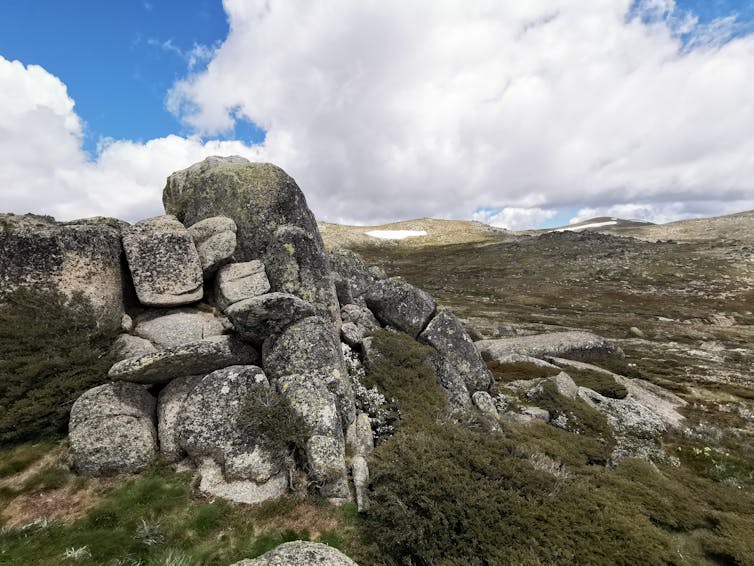
Colour-Changing Skyhoppers
The adults of many alpine invertebrate species live for just a single summer, lay their eggs, then die. They include skyhoppers, a group of alpine grasshoppers unique to Australia, many species of which are threatened.
Skyhoppers rely on a thick snow layer to protect their eggs in winter. But Australia’s snow cover is becoming increasingly unreliable as the planet warms.
Thermocolour skyhoppers, listed as endangered, are unique among grasshoppers in that they change colour from black to turquoise when their body temperature exceeds 25℃.
Until recently, five skyhopper species were known to science. But when researchers walked the entire 655-kilometre Australian Alps walking track, they discovered 15 species of skyhopper exist – each separated by the rugged mountain landscape.
The true biodiversity of the alps is unknown. What we do know is that it is heavily fragmented. What may look like one species across the alps is likely to be many species each occupying small areas. This means they’re even more vulnerable than currently recognised.
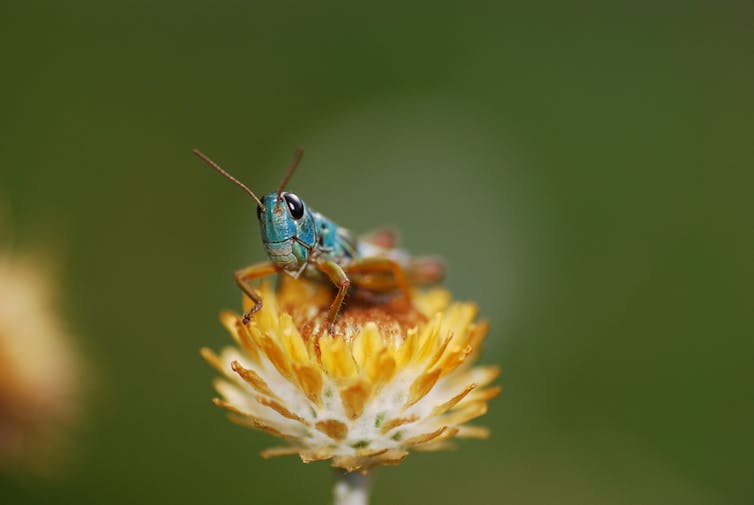
Helping Them Hang On
Much of the Australian Alps region is contained in national parks, but this alone is not adequate protection for our alpine biodiversity.
Greenhouse gas emissions to date have put our alpine biodiversity on a knife’s edge. Australian and international governments must swiftly undertake far more ambitious climate action to cool the alps.
And more effort is needed to give our alpine ecosystems the best chance of coping with climate change. This includes allowing Traditional Owners to connect to and manage Country and removing threats such as feral species, disease and habitat destruction.![]()
Kate Umbers, Senior Lecturer in Zoology, Western Sydney University; Jaana Dielenberg, University Fellow, Charles Darwin University, and Matthew Shanks, Director, Cultural Land Management at Taungurung Land and Waters Council, Indigenous Knowledge
This article is republished from The Conversation under a Creative Commons license. Read the original article.
Two new Australian mammal species just dropped – and they are very small

You probably know about the Tasmanian devil. You might even know about its smaller, less-famous relative, the spotted-tailed quoll.
But these are far from the only meat-eating marsupials. Australia is home to a suite of other carnivorous and insectivorous pouched mammals as well, some of them the size of a mouse or smaller.
Tiniest of all are the planigales, some of which weigh less than a teaspoonful of water. Despite their size, these fierce predators often take on prey as big as themselves.
To date, there are four known species of planigale found across Australia. We have recently discovered another two species, both inhabitants of the Pilbara region of northwest Western Australia: the orange-headed Pilbara planigale (Planigale kendricki) and the cracking-clay Pilbara planigale (P. tealei).
How Many Kinds Of Planigale Are There?
The name planigale translates to “flat weasel”, an allusion to their extremely flat heads, which allow them to shelter in small cracks in rocks and clay soils. Planigales are among Australia’s smallest mammals, with some weighing an average of 4–6 grams (and measuring around 11cm in length), and other species a bit larger at 8–17 grams (and 13cm long).
Scientific studies from the late 1970s onward using body-shape and DNA data have suggested there are many more planigale species than we think.
We put these theories to the test, and found that planigales in the Pilbara display unique body shapes and are genetically unrelated to any of the four known planigale species.
Why Have These Species Only Been Described Now?
The process of describing these two new species was actually started more than 20 years ago, by scientists who were working at the Western Australian Museum at the time.
Their work began after ecologists conducting surveys for developing mines in the Pilbara were capturing planigales that didn’t really fit the descriptions of the known species. For want of a better option, they were still usually identified as either the common planigale (P. maculata) or the long-tailed planigale (P. ingrami).
Scientists led by taxonomist Ken Aplin began examining specimens held in the WA Museum and sequencing their DNA. These studies helped to confirm the discovery of two new species.
Sadly, Ken fell ill and passed away in 2019. This is where we stepped in.
Through support from the Australian Biological Resources Study and the Queensland University of Technology we were able to finish off Ken’s species descriptions and submit the research for publication. This is a crucial step in taxonomy – the species description has to be published before the new name can be considered official.
What Do We Know About The New Species?
Both new species occur in the Pilbara and surrounding areas. The orange-headed Pilbara planigale is the larger of the two, weighing an average of 7g (up to 12g for large males) with a longer, pointier snout and bright orange colouring on the head.
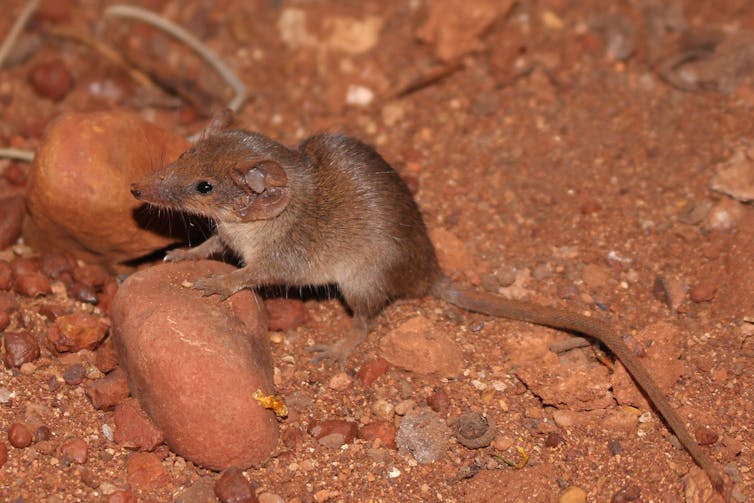
The cracking-clay Pilbara planigale is much smaller, averaging just 4g with darker colouration and a shorter face. It has only been found on cracking clay soils, hence its name.
The orange-headed Pilbara planigale has been found on rocky and sandy soils as well, but both species require a dense cover of native grasses to persist. Both species actively forage during the night, while taking shelter during the day.
This means the two widespread species, the common planigale and the long-tailed planigale, do not occur in the Pilbara or on neighbouring Barrow Island, as was previously thought.
There is still a lot more work for us to do as there remain two “species complexes” of planigales. These are groups where genetic data suggests a species is comprised of multiple different forms.
We’ll be following up on this with more analysis to define more of Australia’s tiniest mammals.![]()
Linette Umbrello, Postdoctoral research associate, Queensland University of Technology; Andrew M. Baker, Academic in Ecology and Environmental Science, Queensland University of Technology, and Kenny Travouillon, Curator of Mammals, Western Australian Museum
This article is republished from The Conversation under a Creative Commons license. Read the original article.
Thick ones, pointy ones – how albatross beaks evolved to match their prey
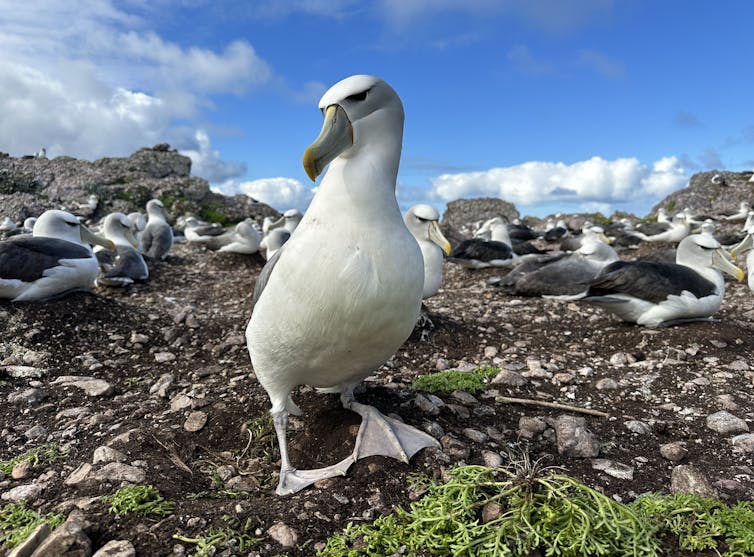
Albatross are among the world’s largest flying birds, with wingspans that can stretch beyond a remarkable three metres. These majestic animals harness ocean winds to travel thousands of kilometres in search of food while barely flapping their wings.
Young albatross, embarking on their first journey, can spend up to five years at sea without ever touching land.
Yet not all albatross are the same. Across the world’s oceans there exist 22 species, with many sharing an overlapping range around the Southern Ocean — a region synonymous with cold, roaring winds and towering waves.
Our new research published today shows how albatross species evolved different beak shapes to make the most of the ocean’s food resources. These species have adapted to different seafood diets.
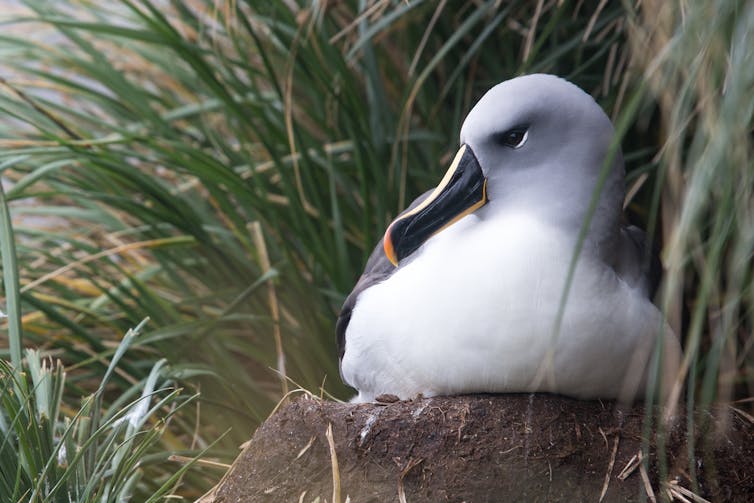
Move Over, Darwin’s Finches!
In 1835 Charles Darwin discovered the finches of the Galápagos Islands and noted their beaks varied in shape and size to suit different diets. This observation became a centrepiece for the theory of evolution, showing how species adapt to different ways of life.
From a single common ancestor, Darwin’s finches diversified. Some birds have thick beaks for feeding on seeds and nuts, while others have pointed beaks for eating insects. This variation allows species to specialise, helping them to share available food sources and limit competition.
Albatross have fascinating beaks. Unlike most other birds, they have a “compound” beak made of multiple pieces of keratin. Albatross spend most of their lives at sea, so they have adapted to drink seawater. They use a special gland to remove salt from the seawater and their beaks contain tube-like passages that excrete the salty liquid.
By studying the shape of albatross beaks in three dimensions (3D), our new research shows that, just like Darwin’s finches, albatross beaks vary in size and shape to adapt to different diets.
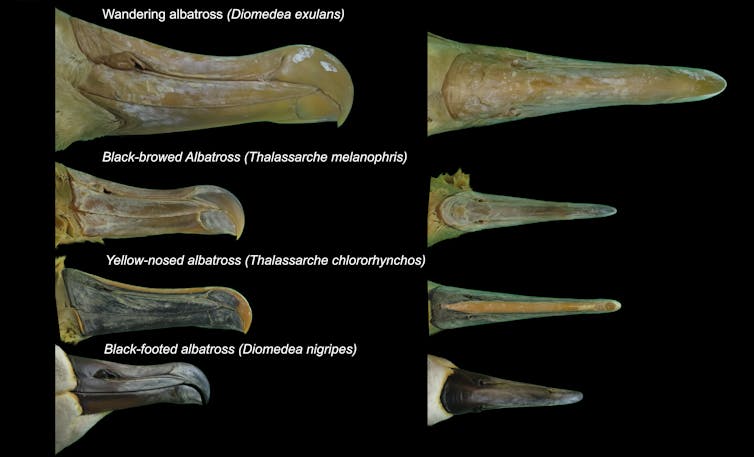
The 3D Scanning Revolution
Wildlife research is undergoing a revolution as scientists use new 3D scanning and modelling techniques to compare the anatomy of animals. This gives fresh insights into their ecology and evolution.
Using museum specimens, we made 3D digital models of beaks for 61 birds from 12 different albatross species. We compared the size and shape of different species’ beaks. We tested if closely-related species had similar beaks. Alternatively, beaks might be more alike between species that are distantly related but consume similar food. Such a pattern would be an example of convergent evolution.
We found beak size and shape varied between albatross species, making it a useful tool for identifying species that otherwise look similar.
Beaks also varied between species that eat either invertebrate prey, fish, or a mixture of both. Even in species that have similarly shaped beaks and diets, variations in beak size enable them to focus on prey of different sizes within the same category, such as small versus large fish.
The variation is most obvious in changes in the length and thickness of the beaks, but they can also vary in how the separate keratin pieces come together to make up the whole shape of the beak. These differences help albatross species to avoid competition with each other as they forage together over the open ocean.
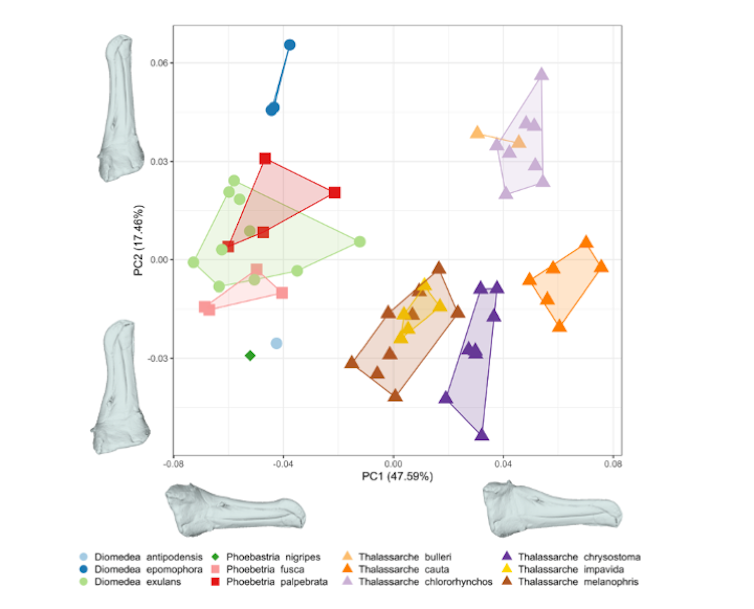
A Future For Albatross?
This research was made possible by the large collection of more than 750 albatross specimens preserved at the Tasmanian Museum and Art Gallery.
Almost all of these specimens came to the museum after being caught as bycatch in past longline fisheries, where bird carcasses were collected to identify which species were being captured on hooks.
Fortunately, improved fishing methods have reduced albatross bycatch, but this collection now remains as a valuable resource for new research like this into the biology of these birds.
Sadly, fisheries are not the only threat these extraordinary birds face. The first European record of an albatross from 1593 tells us how the bird was captured, killed and eaten. Today, of the 22 albatross species, two are considered critically endangered, seven species are endangered, and a further six species are considered vulnerable.
Albatross are still frequent victims of fisheries bycatch, plastic pollution, and introduced predators on their breeding islands.
Like most wildlife species, the persistent threat of climate change looms large, as the world’s oceans warm and alter their habitat and the abundance of their prey.
Despite their evolutionary marvels and remarkable adaptations to the harshest ocean on Earth, the albatross serves as a poignant reminder of nature’s fragility. It is our duty to ensure their wings continue to soar above our oceans for generations to come.![]()

Jane Younger, Lecturer, Southern Ocean Vertebrate Ecology, University of Tasmania; David Hocking, Adjunct Research Associate, Monash University, and Josh Tyler, Postgraduate Research Student, Department of Life Sciences, University of Bath
This article is republished from The Conversation under a Creative Commons license. Read the original article.
Nearly two-thirds of the top fossil fuel producers in Australia and the world aren’t on track for 1.5℃ climate target

Rapid reductions in fossil fuel production and use are essential to limit global warming to 1.5℃ compared to pre-industrial levels. Our new research shows most of the world’s major coal, oil and gas companies are yet to make meaningful reductions.
Some companies have been quick to announce net-zero targets or other claims of alignment with the Paris Agreement. But how do their actions compare to what must be done to achieve the agreed goal of keeping the temperature increase below 1.5℃?
Our research developed a method to track whether production by individual fossil fuel companies is aligned with putting the world on a 1.5℃ climate pathway. We use production budgets as these can be compared directly with fossil fuel demand scenarios and avoid the need for complex emissions calculations.
More than 60% of the top 142 oil, gas and coal companies – including three of the five Australian companies assessed – were not on track. Rio Tinto and BHP were the two Australian companies found to be on track. Between 2014 and 2020, the fossil fuel sectors exceeded overall production budgets by 64% (oil), 63% (gas) and 70% (coal).
These budgets are the levels of production needed to limit warming to 1.5℃ under the Paris Agreement “middle-of-the-road scenario” (where trends broadly follow their historical patterns).
We need freely available information to understand the impact companies are having on the climate and to hold them accountable. Our results are on the website Are you Paris compliant?.
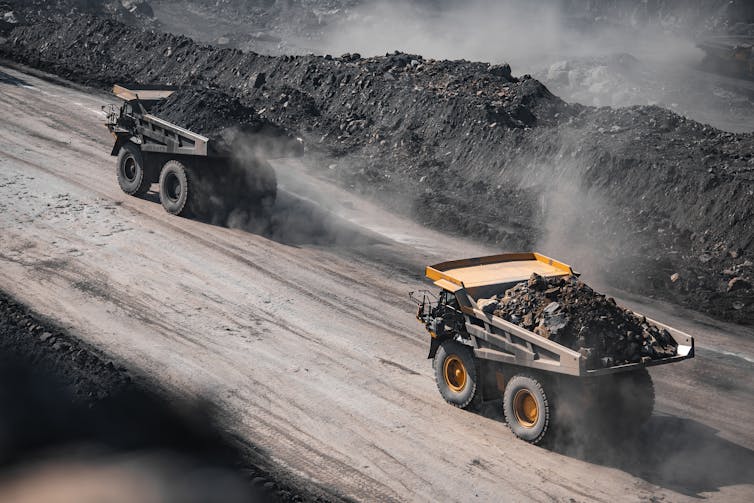
How Can We Track Companies’ Actions?
In an earlier research paper, we laid the foundation of what Paris compliance means using a strict science-based approach. We developed several conditions.
Firstly, the base year of measuring progress of an entity should be the same as the starting year of the decarbonisation scenario being used. While there are many such scenarios, the pathway has to be consistent with a 1.5℃ or “well below” 2℃ warming limit as stated in the Paris Agreement.
To prevent constant delay of action, only pathways starting in or before 2015 should be used. That’s when the world’s nations committed to decarbonisation under the Paris Agreement. For example, if a company wants to track its alignment with a well-below 2℃ pathway starting in 2014, it should start tracking from 2014.
Also, companies should make up for action deficits since the base year to stay within their budgets.
Commonly used frameworks such as the Science Based Targets initiative (SBTi) and the London School of Economics’ Transition Pathway Initiative (TPI) don’t comply with these conditions. The not-for-profit SBTi is the primary point of call for companies wanting to develop emission reduction targets. It’s a partnership between CDP (which runs the global system of environmental impact disclosures), UN Global Compact, World Wildlife Fund and World Resources Institute.
We have now applied our more rigorous approach to fossil fuel companies. Using publicly available production data from the Climate Accountability Institute allows us to assess a large number of companies.
We evaluated the 142 largest producers of coal, oil and gas against four possible emissions “pathways” to limit temperature increase to 1.5℃ this century. We used three pathways set by the Intergovernmental Panel on Climate Change (IPCC) in 2014 and the International Energy Agency’s Net Zero Emissions pathway from 2020. Each pathway involves different scenarios of climate actions, emissions and carbon capture and storage.
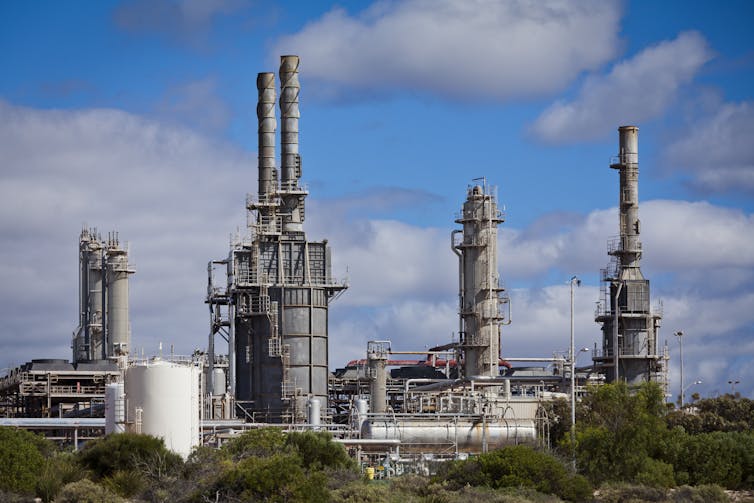
Off Course, With Much More To Do
Not only did we find the majority of these companies are not currently aligned, but the outlook is also troubling. If recent trends (2010-2018) continue, the companies would produce up to 68% (coal), 42% (oil) and 53% (gas) more than their cumulative production budgets by 2050.
In Australia, the three companies not on track were Whitehaven Coal, Santos and Woodside. They exceeded their production budgets by 232% (Woodside coal), 28% (Santos oil) and 33% (Santos gas), and 39% (Woodside gas, on track for oil).
BHP was on track because it has reduced its coal, oil and gas production more than required between 2014 and 2020 under the middle-of-the-road 1.5℃ scenario. It used 87% (coal), 85% (oil) and 92% (gas) of its production budgets. Rio Tinto entirely stopped its production of coal in 2018.
While we project future production using historical (2010-2018) growth, a next step would be to assess how current production plans align with 1.5℃ pathways.
Companies can use our method to see how much they need to reduce production to be aligned. They can also see how much carbon capture and storage is required under a certain 1.5℃ pathway.

Tracking Enables Accountability
For companies to claim Paris alignment, they must be accountable for achieving the required levels of mitigation (reducing production and carbon capture and storage) under a particular 1.5℃ pathway.
Our method provides a foundation to drive this change. It offers a relatively simple way to measure corporate actions against the reductions required.
Our work aids the development of standards, regulation and guidance on what Paris alignment actually means. The Science Based Targets initiative has yet to finalise a method for the oil and gas sector. It has no method for coal.
Our method provides a process that can fill this void. In addition to tracking individual companies’ compliance with the Paris Agreement, we require clarity on their intentions beyond just setting targets. The International Sustainability Standards Board (ISSB) will play a vital role by requiring detailed climate transition plans from companies in countries that adopt its standards.
Tracking how companies are performing empowers all stakeholders – including governments, investors and individuals like you and me – to advocate for climate action and make climate-safe decisions. For example, investors can use this information to decide which companies to invest in and advocate for change where required. Governments can integrate this information into corporate guidelines for climate action.![]()
Saphira Rekker, Senior Lecturer in Sustainable Finance, The University of Queensland and Belinda Wade, Adjunct Associate Professor, School of Business, The University of Queensland
This article is republished from The Conversation under a Creative Commons license. Read the original article.
Yes, climate change is bringing bushfires more often. But some ecosystems in Australia are suffering the most
David Lindenmayer, Australian National University; Chris Taylor, Australian National University; Maldwyn John Evans, Australian National University, and Philip Zylstra, Curtin UniversityBlack Summer, Black Saturday, Ash Wednesday: these and so many other bushfire disasters are regular reminders of the fact Australia is among the most flammable continents on Earth.
Alarmingly, climate change is making bushfires more frequent. This is a huge concern, given the devastating effects of fire on both human communities, and the diversity of plants and animals.
As our new research shows, however, the trend is not uniform. We examined the frequency of wildfires in parts of Victoria over the past 40 years. We found fire frequency is increasing in all ecosystems we studied, but to varying extents. In some places, fires are occurring so often, entire ecosystems are at risk of collapse.
These nuances are important. They point to the urgent need to tackle climate change. They also have major implications for biodiversity conservation, and bushfire management and prevention, and cast further questions over the controversial practice of native forest logging.
Fires Are Becoming Shockingly More Frequent
To understand the effects of wildfires, it’s not enough to focus on a single fire. We must examine successive fires in an area and how frequently they occur.
Our analysis focused on southeastern Australia – one of the most populated, heavily forested, and fire-prone parts of the continent.
Specifically, we homed in on six geographic areas in Victoria known as “bioregions”. Bioregions vary in their climatic conditions, geological features, biodiversity and other characteristics. The six areas together cover 4.64 million hectares – much of it forest.
We excluded deliberate burns such as hazard reduction (or prescribed) burns lit by fire authorities. We also excluded places that had been logged, because they’re known to be at a high risk of severe fire – and so including them would have skewed the results.
We found a major change in the frequency of wildfire over the past four decades. Between 2001 and 2020, there were substantially more fires in almost all bioregions than between 1981 and 2000.
In the earlier two decades, almost 667,000 hectares of forest burned. More than 36,000 hectares of this burned more than once.
In the latter two decades, 3.1 million hectares burned. About 1 million hectares burned more than once.
The change was most pronounced in the three bioregions at higher elevations - the Snowy Mountains, Victorian Alps, and South East Coastal Ranges (which lie southeast of the Snowy Mountains).
The least amount of change was found in Victoria’s East Gippsland Lowlands. This area had more fires in 1981-2000 than the other areas we studied, but only a modest increase in number of fires between 2000 and 2020.
Fascinatingly, however, the story doesn’t end there.
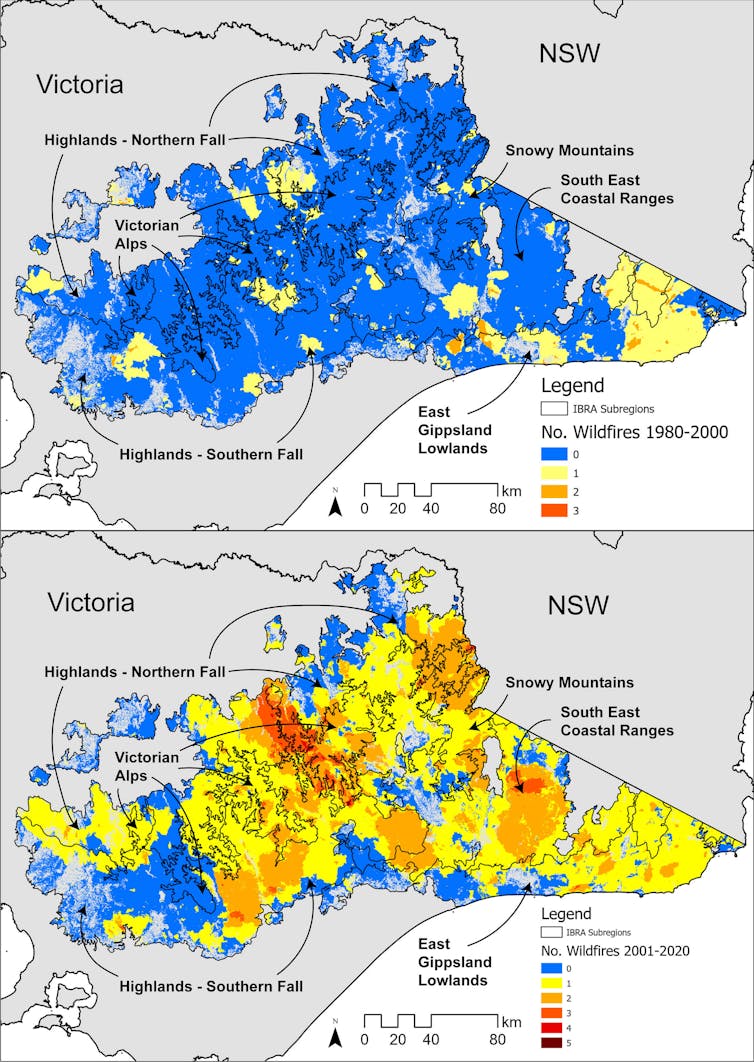
A Complex Picture
We found the changes in fire frequency were nuanced and complex. Across the study areas, the frequency of wildfires was very strongly affected by topographical features such as slope, as well as climate measures such as rainfall and temperature. However, the influence of these factors differed markedly between areas.
For example, in four bioregions we studied, wildfires became more frequent as rainfall declined. But the opposite was true in the other two bioregions.
The reasons for these complex findings remain unclear. Increased average rainfall may, in some cases, arrive in storm events with associated lightning (which can start fires). It can also lead to faster water runoff, meaning rainfall may not be as well retained in the soil as otherwise might be, and forests could become drier.
Similarly, fire frequency was also affected by the extent to which temperatures deviated from the long-term average. Generally, this deviation was toward hotter temperatures.
In some areas, this temperature variation was associated with less frequent fires. In others, it coincided with more frequent fires. Again, the reasons for these differences are not yet clear.
The increase in fire frequency is alarming. Some places where fire has been particularly frequent include wetter forests, such as those dominated by ash-type eucalypts. Consistent with earlier analyses, we found evidence of locations that have experienced up to four fires in the past 25 years.
Fires in ash-type ecosystems have historically occurred only once every 75 to 150 years. Fires occurring too often in these environments may lead to the entire ecosystem collapsing.
Our results have major implications for the native forest logging forestry industry. More frequent fires means many trees burn well before they’ve reached an age suitable for sawlogs. This suggests yields from native forest logging in south-eastern Australia will decline, making the practice even more financially precarious.

What Must Happen Next?
Our results confirm wildfires are becoming more frequent in parts of fire-prone south-eastern Australia. And while climate change influences the frequency of fire, the effects vary across geographical areas.
Clearly, we must seek to limit the number of wildfires. An obvious response is to take more strident steps to tackle climate change. But even if humanity meets this huge global challenge, it will be a long time before we see demonstrable changes in climate conditions.
More immediate options include managing vegetation to reduce flammability. For example, activities such as logging and thinning can make forests more flammable, so such practices should be halted in these vulnerable ecosystems.
Greater efforts are needed to conserve biodiversity that is sensitive to fire, and to conserve ecosystems at risk of collapse. We must also embrace new technologies to detect wildfires as soon as they ignite, and suppress them as quickly as possible.![]()
David Lindenmayer, Professor, The Fenner School of Environment and Society, Australian National University; Chris Taylor, Research Fellow, Fenner School of Environment and Society, Australian National University; Maldwyn John Evans, Senior Research Fellow, Australian National University, and Philip Zylstra, Adjunct Associate Professor at Curtin University, Research Associate at University of New South Wales, Curtin University
This article is republished from The Conversation under a Creative Commons license. Read the original article.
Giant old trees are still being logged in Tasmanian forests. We must find ways of better protecting them
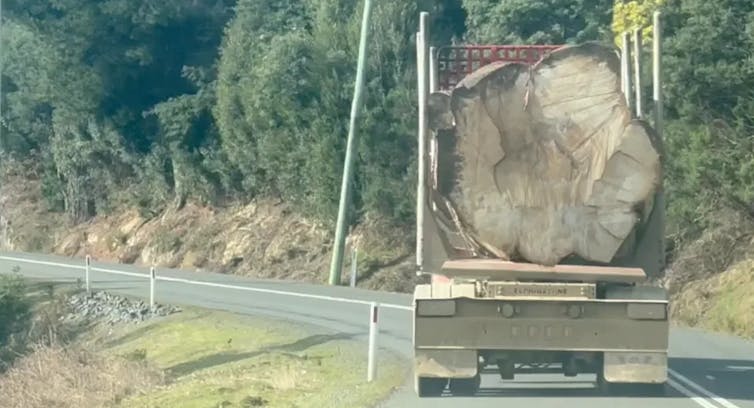
The photo said it all. On the back of a logging truck, a tree so large it could barely fit. It was cut down in Tasmania’s Florentine Valley, not far from Mount Field, where it had started life as a seedling over a century ago.
The photo triggered outrage from conservationists and the public. Greens founder Bob Brown called the felling “a national disgrace” and urged a halt to the felling of old growth giants.
Giant trees are supposed to be protected as a matter of normal process. Trees over 85 metres high or with a trunk volume of 280 cubic metres should be retained with a 100 metres radius of uncleared bush around them. The loggers say this one was cut down for “safety reasons”. We don’t know if this one met those criteria.
Whether or not that’s true, the felling has sparked a new battle in Tasmania’s long-running forest wars. Unlike in Victoria, old growth logging in Tasmania doesn’t look like ending any time soon. But we must find ways to better protect these giants of nature, the tallest flowering trees in the world. They store huge amounts of carbon in their trunks and in the soil, provide habitat for many forest creatures and produce awe in humans who see them.
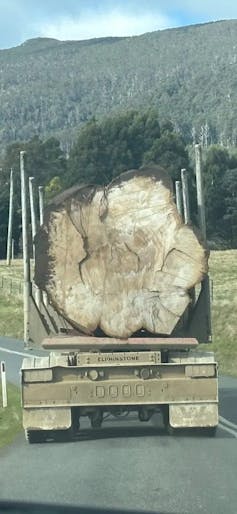
Why Was This Giant Logged?
The truck transporting the trunk of the tree was seen exiting Tasmania’s Florentine Valley. This valley has been the site of many protests over the years. Part of it is in the World Heritage Area, but logging is still allowed in other parts of it.
Why was a tree this size cut down? Safety.
“On occasion, it may be necessary for Sustainable Timber Tasmania to remove a large tree where it presents an access or safety risk,” a spokeswoman told news.com.au.
That is possible. Giant old trees can hollow out as they age and become a safety risk if people are allowed near them. But the trunk in the published photo shows no sign of hollowing out. If it was a giant, the mandatory 100 metre protection zone would eliminate almost all risk.
At the very least, the felling suggests not all of Tasmania’s ancient trees are adequately protected. What it shows is the need for independent assessment of areas slated for logging likely to be home to giants – and to ensure trees felled for “safety” reasons" genuinely need to be removed.
And what about trees that are not quite big enough to be protected? As ecologist and tall-tree expert Dr Jennifer Sanger has observed, the 85-metre figure is arbitrary. We need to plan for the giant trees of the future by keeping the almost giant trees of now.
Ancient Giants Matter
Mountain ash (Eucalyptus regnans) is the world’s largest flowering plant. The trees can live up to 700 years and reach over 100 metres in height.
Do they matter more than other trees? Yes. That’s because big old trees begin to decay in interesting ways, creating hollows for possums and birds to nest in, and even hollowing out inside the trunk, which makes habitat for bats. They play an outsized role in ecosystems in providing shelter, hollows and food.
Ironically, these processes of decay can make these giants all but useless for timber. If you’re logging a giant to turn it into large structural beams, you might find it’s hollow inside and all but useless.
The sheer size of these trees also means they have more habitat to offer for other forms of life. Native animals, birds and invertebrates rely on these trees. Plus, they store massive amounts of carbon, both above ground and in the soil. Cutting down the old growth forests of which these trees are a part and turning them into production forests results in a substantial ongoing leakage of soil carbon for many generations.
The trees induce awe and wonder in most who see them. People are passionate about keeping them on the planet – one of the reasons for the forest wars in the first place. These huge trees attract tourists to walk beneath them or up in their canopies.
Haven’t Tasmania’s Forest Wars Stopped?
Sadly, no. The decades-long battle between loggers and conservationists in Tasmania has certainly become less intense after many old growth forests such as the Weld, Styx, Florentine and Great Western Tiers gained World Heritage protection in 2013.
But native forest logging in Tasmania shows no sign of stopping entirely. Old-growth logging continues around the state, including in the Florentine Valley where this giant tree was felled. Rainforest trees in some reserves are available for logging.
In May, Victorian Premier Daniel Andrews announced his state would this year end native forest logging, which has long been a loss-making industry. Instead, plantation logging will be expanded.
Why can’t Tasmania do this? It mostly comes down to politics. Tasmania is the poorest state in Australia, and the few jobs logging native forests are politically important.
Also, the wood from larger trees are better for ends such as veneer, exposed beams and furniture than most plantation-sourced wood. Their felling can be rewarding financially for the companies that do it, as no-one has to pay to grow them and they can contain large volumes of high quality wood.
But overall, cutting down old growth forests may not stack up economically, with the quasi-government enterprises managing production forests often making losses. It didn’t make much financial sense in Victoria, and may not in Tasmania.
Will the felling of this giant bring change? Don’t bet on it. Probably the best we can hope for is to preserve as many giants – and near-giants – as we can. And to do that, we’ll need independent assessments of old growth forest slated for logging to double-check measurements of these precious trees. ![]()
Jamie Kirkpatrick, Professor of Geography and Environmental Studies, University of Tasmania
This article is republished from The Conversation under a Creative Commons license. Read the original article.
More Than 250 Scientists Call For An End To Land Clearing
Let's End Land Clearing
Letters Show Need For Urgent Action To Protect Threatened Species
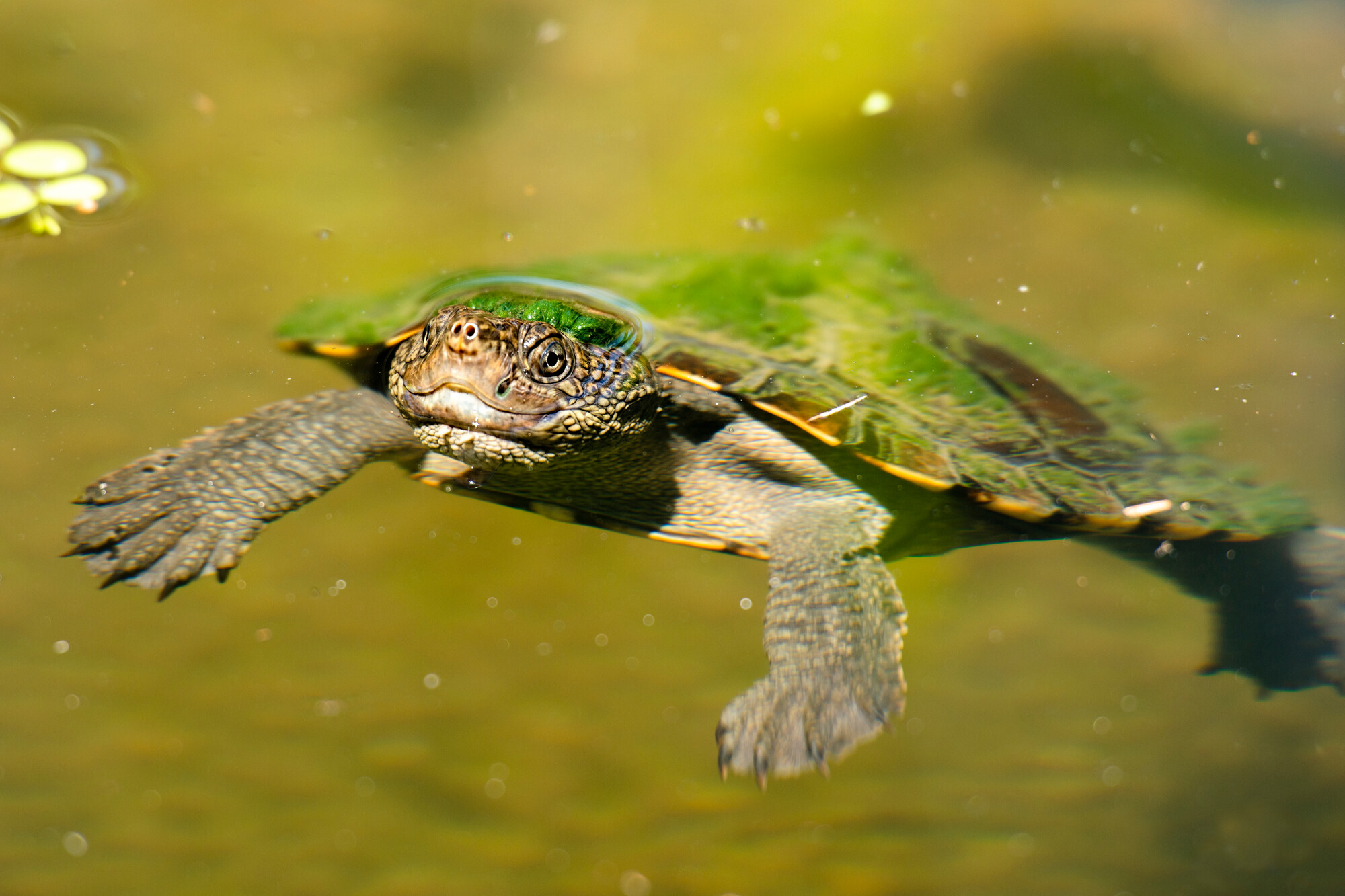
A green roof or rooftop solar? You can combine them in a biosolar roof, boosting both biodiversity and power output
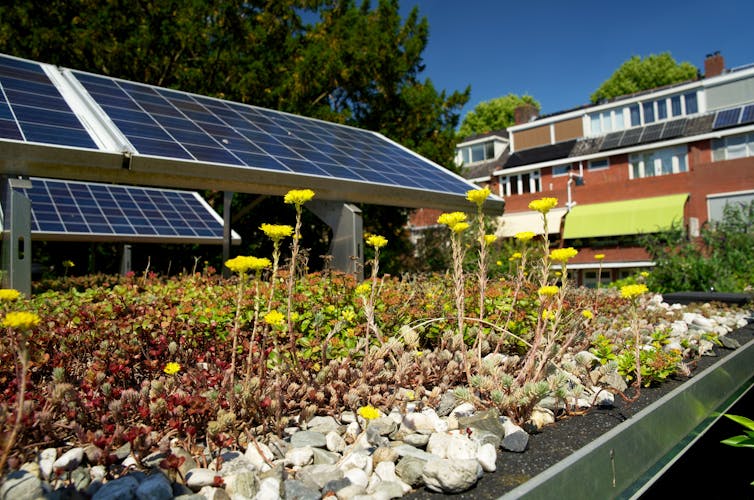
Growing city populations and limited space are driving the adoption of green roofs and green walls covered with living plants. As well as boosting biodiversity, green roofs could play another unexpectedly valuable role by increasing the electricity output of solar panels.
As solar panels heat up beyond 25℃, their efficiency decreases markedly. Green roofs moderate rooftop temperatures. So we wanted to find out: could green roofs help with the problem of heat reducing the output of solar panels?
Our research compared a “biosolar” green roof – one that combines a solar system with a green roof – and a comparable conventional roof with an equivalent solar system. We measured the impacts on biodiversity and solar output, as well as how the plants coped with having panels installed above them.
The green roof supported much more biodiversity, as one might expect. By reducing average maximum temperatures by about 8℃, it increased solar generation by as much as 107% during peak periods. And while some plant species outperformed others, the vegetation flourished.
These results show we don’t have to choose between a green roof or a solar roof: we can combine the two and reap double the rewards.
How Was The Study Done?
Many studies have tested a single rooftop divided into “green roof” and “non-green roof” sections to measure the differences caused by vegetation. A problem with such studies is “spatial confounding” – the effects of two nearby spaces influencing one another. So, for example, the cooler green roof section could moderate the temperature of the non-green section next to it.
In studies that use distinct buildings, the buildings might be too far apart or too different in construction to be comparable.
The two buildings in our study were the same height, size and shape and located next to each other in Sydney’s central business district. The only difference was Daramu House had a green roof and International House did not.
We selected a mix of native and non-native grasses and non-woody plants, which would flower across all seasons, to attract diverse animal species.
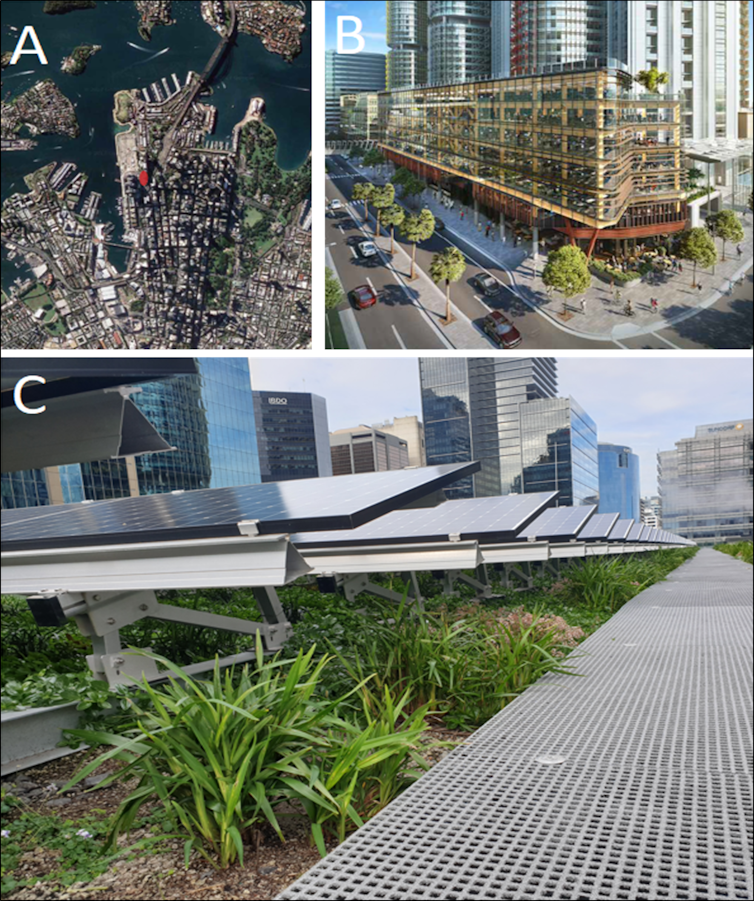
The biosolar green roof and conventional roof had the same area, about 1860 square metres, with roughly a third covered by solar panels. Vegetation covered about 78% of the green roof and the solar panels covered 40% of this planted area.
To identify which species were present on the roofs we used motion-sensing cameras and sampled for DNA traces. We documented changes in the green roof vegetation to record how shading by the solar panels affected the plants.
How Did The Panels Affect The Plants?
In the open areas, we observed minimal changes in the vegetation cover over the study period compared to the initial planted community.
Plant growth was fastest and healthiest in the areas immediately around the solar panels. Several species doubled in coverage. We selected fast-growing vegetation for this section to achieve full coverage of the green roof beds as soon as possible.
The vegetation changed the most in the areas directly below and surrounding the solar panels. The Baby Sun Rose, Aptenia cordifolia, emerged as the dominant plant. It occupied most of the space beneath and surrounding the solar panels, despite having been planted in relatively low densities.
This was surprising: it was not expected the plants would prefer the shaded areas under the panels to the open areas. This shows that shading by solar panels will not prevent the growth of full and healthy roof gardens.
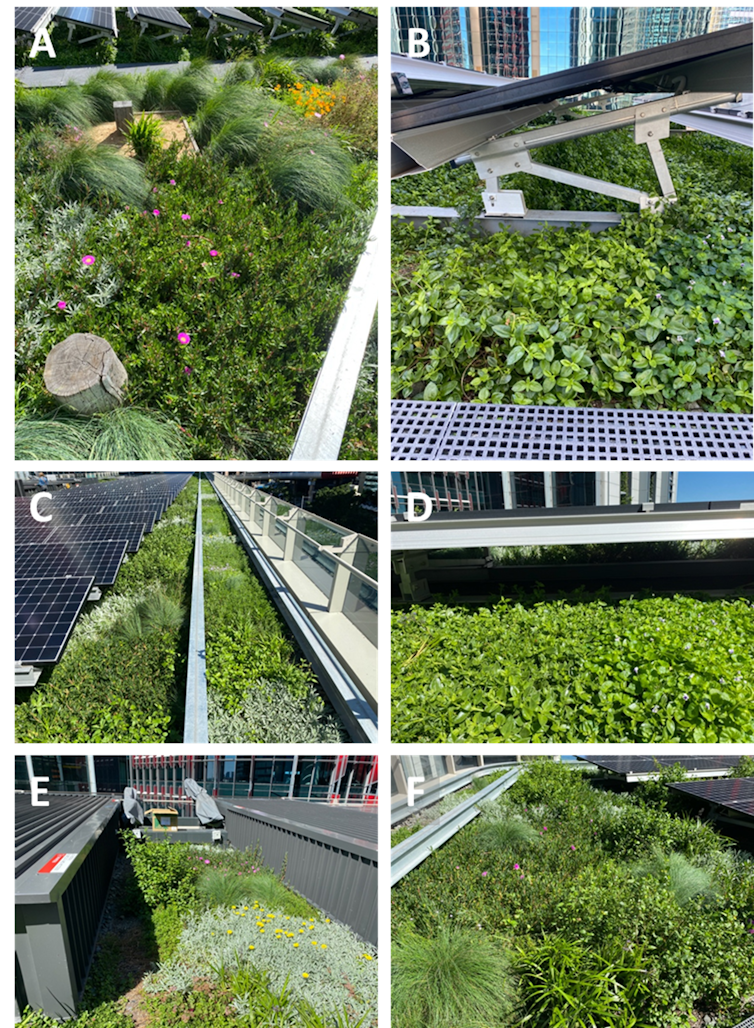
What Were The Biodiversity Impacts?
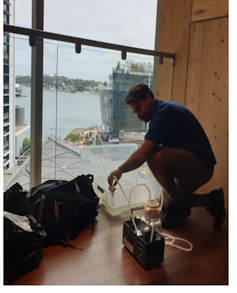
We used environmental DNA (eDNA) surveys to compare biodiversity on the green roof and conventional roof. Water run-off samples were collected from both roofs and processed on site using portable citizen scientist eDNA sampling equipment to detect traces of DNA shed by the species on the roof.
The eDNA surveys detected a diverse range of species. These included some species (such as algae and fungi) that are not easily detected using other survey methods. The results confirmed the presence of bird species recorded by the cameras but also showed other visiting bird species went undetected by the cameras.
Overall, the green roof supported four times as many species of birds, over seven times as many arthropods such as insects, spiders and millipedes, and twice as many snail and slug species as the conventional roof. There was many times the diversity of microorganisms such as algae and fungi.
Encouragingly, the green roof attracted species unexpected in the city. They included blue-banded bees (Amegilla cingulata) and metallic shield bugs (Scutiphora pedicellata).
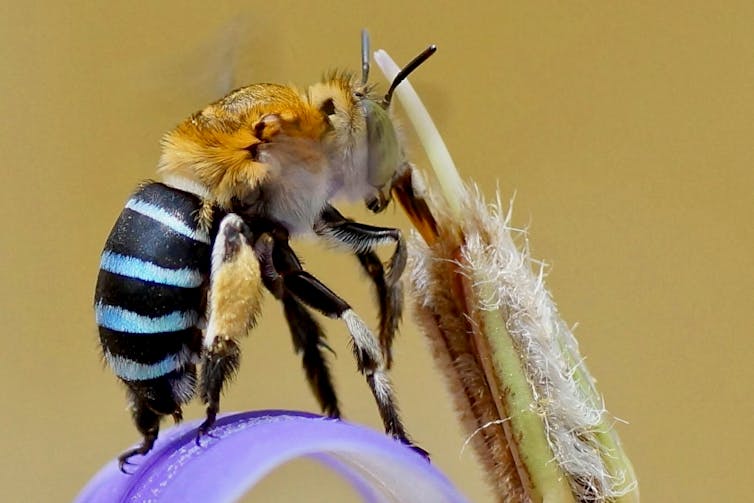
How Did The Green Roof Alter Temperatures?
The green roof reduced surface temperatures by up to 9.63℃ for the solar panels and 6.93℃ for the roof surfaces. An 8℃ reduction in average peak temperature on the green roof would result in substantial heating and cooling energy savings inside the building.
This lowering of temperatures increased the maximum output of the solar panels by 21-107%, depending on the month. Performance modelling indicates an extensive green roof in central Sydney can, on average, produce 4.5% more electricity at any given light level.

These results show we don’t have to choose between a green roof or a solar roof. We can combine them to take advantage of the many benefits of biosolar green roofs.
Biosolar Roofs Can Help Get Cities To Net Zero
The next step is to design green roofs and their plantings specifically to enhance biodiversity. Green roofs and other green infrastructure may alter urban wildlife’s activities and could eventually attract non-urban species.
Our green roof also decreased stormwater runoff, removed a range of run-off pollutants and insulated the building from extremes of temperature. A relatively inexpensive system provides all of these services with moderate maintenance and, best of all, zero energy inputs.
Clearly, biosolar green roofs could make major contributions to net-zero cities. And all that’s needed is space that currently has no other use.![]()
Peter Irga, ARC DECRA Fellow and Lecturer in Air and Noise Pollution, School of Civil and Environmental Engineering, University of Technology Sydney; Eamonn Wooster, Postdoctoral Research Fellow, Gulbali Institute, Charles Sturt University; Fraser R Torpy, Director, Plants and Environmental Quality Research Group, University of Technology Sydney; Jack Rojahn, PhD Candidate, Institute for Applied Ecology, University of Canberra, and Robert Fleck, Research Scientist, School of Life Sciences, University of Technology Sydney
This article is republished from The Conversation under a Creative Commons license. Read the original article.
Rising seas and a great southern star: Aboriginal oral traditions stretch back more than 12,000 years
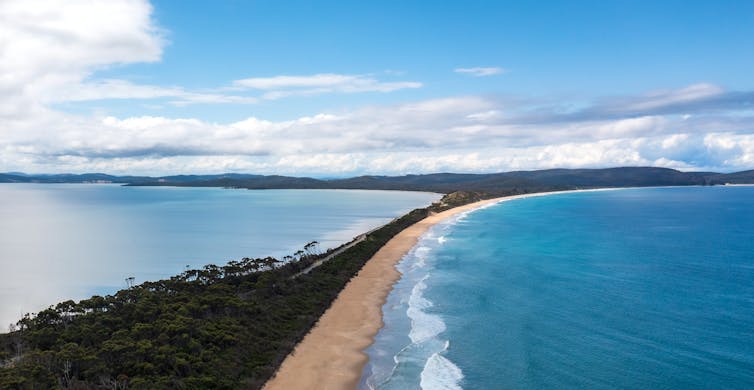
Content note: this article mentions genocide and acts of colonial violence against Aboriginal people.
How long do you think stories can be passed down, generation to generation?
Hundreds of years? Thousands?
Today, we publish new research in the Journal of Archaeological Science demonstrating that traditional stories from Tasmania have been passed down for more than 12,000 years. And we use multiple lines of evidence to show it.
Tasmania’s Violent Colonial History
Within months of establishing a colonial outpost on the island in 1803, British officials had committed several acts of genocide against Aboriginal Tasmanian (Palawa) people. By the mid-1820s, soldiers, convicts, and free settlers had taken up arms to fight what became known as the “Black War”, aimed at capturing or killing Palawa and dispossessing them of their Country.
Tasmania’s colonial government appointed George Augustus Robinson to “conciliate” with the Palawa. From 1829 to 1835, Robinson travelled with a small group of Palawa, including Trukanini and her husband, Wurati. By 1832, Robinson’s “friendly mission” had turned to forced removals.

Robinson kept a daily journal, which included records of Palawa languages and traditions. Over time, Palawa men and women slowly began to share some of their knowledge, explaining how their ancestors came to Tasmania (Lutruwita) by land from the far north, before the sea formed and turned their home into an island. They also spoke about the Sun-man, the Moon-woman, and a bright southern star.
These stories are of immense importance to today’s Palawa families who survived the devastating impact of colonisation, and who continue to share these unique creation stories. Through careful investigation of colonial records, and collaborating with Palawa knowledge-holders, we found something remarkable.
Rising Seas And The Formation Of Lutruwita
Over the past 65,000 years, Australia’s First Peoples witnessed natural disasters and significant changes to the land, sea and sky. Volcanoes spewed fire, earthquakes shook the land, tsunamis inundated the coastlines, droughts plagued the continent, meteorites fell to the earth, and the stars shifted in the night sky.
Some 20,000 years ago, the world was in the grip of an ice age. Australia was conspicuously drier than it is today, and the ocean was significantly lower. All of that sea water was bound up in glaciers that swathed vast tracts of land, particularly across the Northern Hemisphere, and polar ice caps much larger than ours today.
As time passed, temperatures gradually rose and the ice began to melt. After 10,000 years, the sea level had risen 125 metres; a process that dramatically transformed coastlines and submerged landscapes that had been ancestral Country for thousands of generations. This forced humans to change where and how they lived.
During the ice age, both Lutruwita and Papua New Guinea were connected to mainland Australia by dry land, forming a landmass called Sahul. As the seas rose, Tasmania’s connection gradually narrowed to form what geologists call the Bassian Land Bridge.
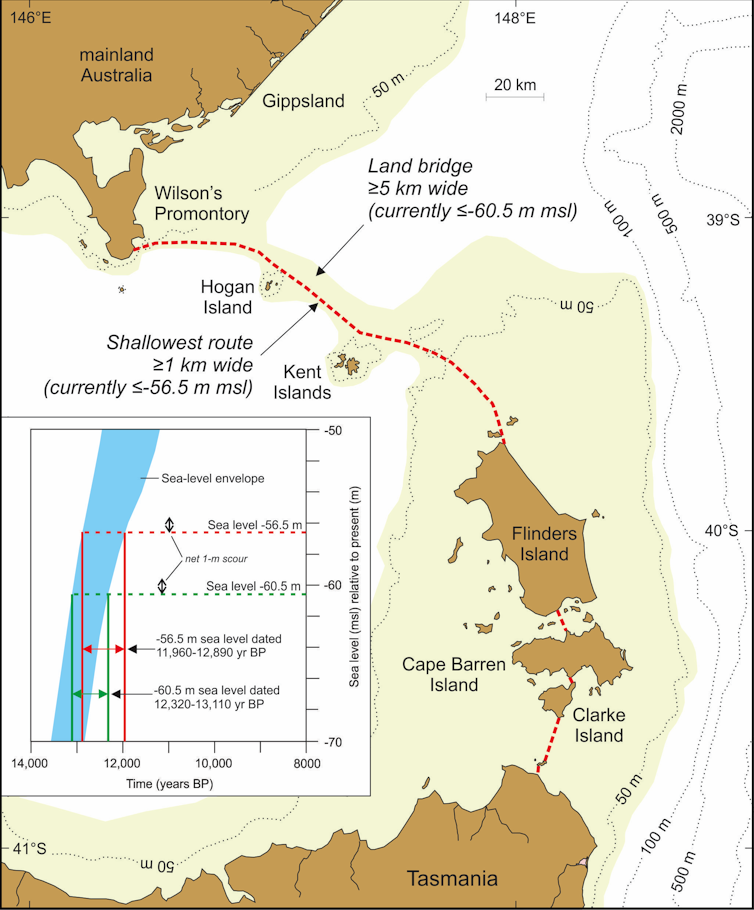
People continued to live on this “land bridge”, but by 12,700 years ago it had narrowed to just 5 kilometres wide (lime-green shading on the map above). Habitable land was gradually reduced as the sea closed in. Less than 300 years later, the “land bridge” was gone and Lutruwita was completely surrounded by water.
Palawa traditions from that time survived hundreds of generations of retelling, forming part of a larger canon of Aboriginal and Torres Strait Islander stories around Australia. They described rising seas and submerging coastlines as the ice sheets melted before levelling off around 7,000 years ago. Stories of similar antiquity are known from other parts of the world.
A Great South Star
Aboriginal and Torres Strait Islander cultures developed rich and complex knowledge systems about the stars, which are still used today. They describe the movements of the Sun, Moon, and stars, as well as rare cosmic events, such as eclipses, supernovae, and meteorite impacts.
In the 1830s, a Palawa Elder spoke about a time when the star Moinee was near the south celestial pole. He laid down a pair of spears in the sand and drew a few reference stars to triangulate its position.
Colonists seemed perplexed about the presence of an antipodean counterpart to Polaris, as no southern pole star exists today. Some tried to identify the stars on the star map, but seemed confused and labelled them incorrectly, as they were unaware of an important astronomical process called axial precession.
As the Earth rotates, it wobbles on its axis like a spinning top. This shifts the location of the celestial poles, tracing out a large circle every 26,000 years. As thousands of years pass by, the positions of the stars in the sky slowly change.
Long ago, Canopus was at its southernmost point in the sky. Lying just over 10 degrees from the south celestial pole, it appeared to always hover in the southern skies each night. That last occurred 14,000 years ago, before rising seas turned Lutruwita into an island.

Exciting Collaborative Futures
We can see through independent lines of evidence that Palawa stories have been passed down for more than twelve millennia. We also find here the only example in the world of an oral tradition describing a star’s position as it would have appeared in the sky over 10,000 years ago.
Our investigation of colonial records that record traditional systems of knowledge has demonstrated a powerful cross-cultural way of better understanding deep human history. This also recognises the immense value of Aboriginal and Torres Strait Islander traditions today.
This research was co-authored by graduate Michelle Gantevoort from RMIT University, and student researchers Ka Hei Andrew Law from the University of Melbourne and Mel Miles from Swinburne University of Technology.![]()
Duane Hamacher, Associate Professor, The University of Melbourne; Greg Lehman, Pro Vice Chancellor, Aboriginal Leadership, University of Tasmania; Patrick D. Nunn, Professor of Geography, School of Law and Society, University of the Sunshine Coast, and Rebe Taylor, Associate Professor of History, University of Tasmania
This article is republished from The Conversation under a Creative Commons license. Read the original article.
Thousands of migratory birds will make NZ landfall in spring – will they bring a deadly bird flu with them?
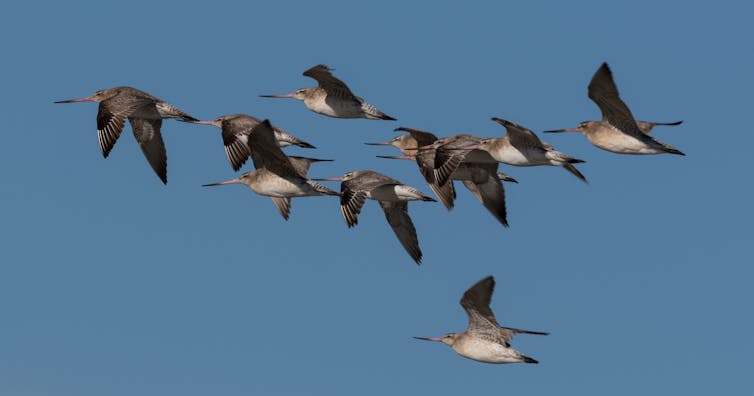
A highly pathogenic bird flu is currently sweeping the world – and New Zealand could be better prepared for its potential arrival.
Over the past few years, more and more birds have come to harbour new strains of this deadly virus as it continues to evolve to infect new species. It is now causing a panzootic (a pandemic of animals) among wild aquatic birds.
The virus, known as highly pathogenic avian influenza virus, has likely already killed thousands of birds worldwide (the exact number is difficult to estimate). What’s more, spillovers to non-avian hosts such as mammals are becoming increasingly common.
While only a few human cases have been reported, cats, foxes and sea lions are being infected at an alarming rate.
Despite intercontinental transmission of highly pathogenic bird flu variants during the past 20 years, no cases have been reported in New Zealand – yet. Australia is also considered free of the virus, although a few years ago a strain in chickens was thought to have evolved locally.
One reason we emphasise “yet” is because each spring, thousands of migratory birds arrive in Aotearoa New Zealand. Will they bring these deadly strains of avian influenza with them? An unwanted viral hitchhiker of this type could have devastating consequences for our biota and industries.
How Bird Flu Could Get To New Zealand
New Zealand is conventionally assumed to be at low risk from highly pathogenic avian influenza. We are thought to be too far away from other landmasses and not on routes that migratory waterfowl usually take.
Any migratory shore and seabirds that do usually make landfall in New Zealand are thought likely to die of the disease before reaching our shores.
But some wild birds might experience asymptomatic infections, even of strains that are typically highly pathogenic.
Also, the recent expansion of susceptible host species, including to marine mammals, increases the risk that some species might carry the virus here.
As for geography, research suggests wild bird migrations are responsible for transmitting the virus from Europe to the Americas across the Atlantic, as well as throughout Eurasia. So why not to New Zealand? Are we really just too far away?
How To Prepare For An Outbreak
If this highly pathogenic avian influenza virus were to arrive, New Zealand is not as prepared as it could be. The major reason is that we have very little active virus surveillance of wildlife.
New Zealand monitors livestock, including cows, sheep and poultry, for a range of diseases. But the impact of this virus on people and non-poultry livestock is likely to be minimal.
The first signs might be the death of seabirds or marine mammals. While perhaps not as iconic as a kiwi or kākāpō, New Zealand is home to a great many seabirds found nowhere else on the planet.
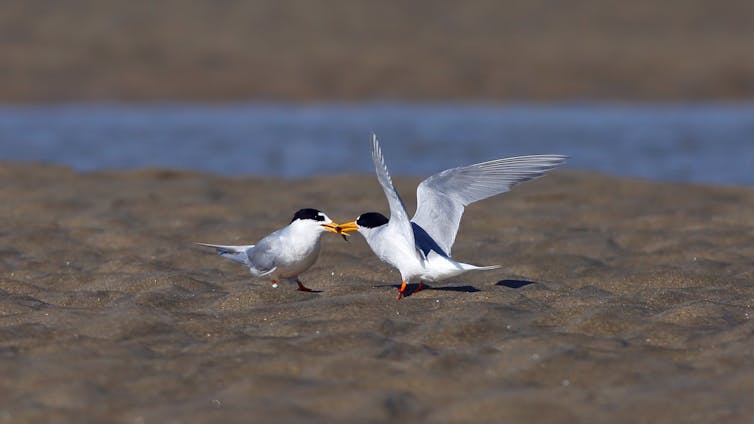
Some species, such as tara iti (or fairy tern) are critically endangered, with only about 50 individuals left. A virus such as this could directly drive the extinction of species with such low numbers.
Given this risk, the US took action to vaccinate the Californian condor against avian influenza – but only after finding 21 dead condors (4% of the remaining population) which had tested positive for the H5N1 strain.
What should New Zealand watch for and how can we be better prepared to detect any incursions early?
Raising awareness: unexpected deaths in animals are a red flag. Usually, such events are investigated by the Ministry for Primary Industries. But we must better inform the public about what to do if they spot a dead bird or sea lion.
Testing: ramp up active and targeted surveillance of known pathogens. Wild birds have been surveyed annually since 2004 for avian influenza. However, since 2010 the focus has shifted away from migratory birds to sampling resident wildfowl in the summer months, concentrating on a small number of coastal locations visited by migratory shorebirds. This is based on the lack of positive samples from migratory bird prior to 2010, but the global situation and consequences of an incursion warrant revisiting active migratory bird surveillance across more locations.
Genomics: use the viral genomics capabilities we have already established during the COVID-19 pandemic. In Europe, for instance, there are some circulating variants of avian influenza that seem to better infect mammals. If the virus arrives here, viral genomics can be used effectively to let us know what form we are dealing with, and inform our response.
It is clear that to first spot and then stop a virus such as this, we need to look at the entire ecosystem – that is, where humans, animals and the environment are interconnected. This is known as the “One Health” approach.
While this makes intuitive sense, the reality is that disease surveillance affecting humans, domestic animals and wildlife is largely siloed and under-resourced. There is limited integration of activities across these domains. The result is that we are currently ill-equipped to track and respond rapidly to this deadly virus were it to arrive in New Zealand.
We are advocating defragmentation of our surveillance for emerging pathogens. It is time to provide a more enhanced and integrated One Health surveillance system, involving expertise across universities, research institutes and government departments to re-evaluate our pandemic (and panzootic) preparedness.![]()
Jemma Geoghegan, Professor and Webster Family Chair in Viral Pathogenesis, University of Otago and Nigel French, Distinguished Professor of Infectious Disease Epidemiology and Public Health, Massey University
This article is republished from The Conversation under a Creative Commons license. Read the original article.
Montana youth win unprecedented climate case: What does this ruling mean for Canada?

On Aug. 14, a Montana court delivered what is being hailed as a game-changing ruling in a much anticipated youth-led climate change case, Held v. State of Montana.
The Montana First Judicial District Court ruled that the state’s energy policy forbidding the government from considering the impacts of greenhouse gas (GHG) emissions and climate change in its environmental decision-making violates the state constitution’s fundamental “right to a clean and healthful environment.”
The court’s decision is a resounding victory for the 16 youth plaintiffs and their legal team. Michael Gerrard, founder of Columbia University’s Sabin Center for Climate Change (who was not involved in the case), said that “I think this is the strongest decision on climate change ever issued by any court.”
That said, the court stopped short of requiring the state to develop a supervised GHG emissions reductions plan.
The Montana state government issued a fiery response to the ruling and has signalled its intention to appeal, which will send the case to the state Supreme Court. However, regardless of how events play out in Montana, one question stands out: What are the implications of this ruling here in Canada and around the world?
Express And Implied Rights
The legal landscape here in Canada is, unsurprisingly, quite a bit different from the United States. Specifically, The Canadian Charter of Rights and Freedoms does not include a green amendment like Montana’s; indeed, the Charter has not been amended once since its enactment in 1982.
Consequently, rights-based climate litigation in Canada requires the judiciary to interpret other Charter rights — particularly Section 7’s right to life, liberty and security of the person, and Section 15’s right to equality — as naturally and necessarily encompassing a right to a clean and healthy environment.
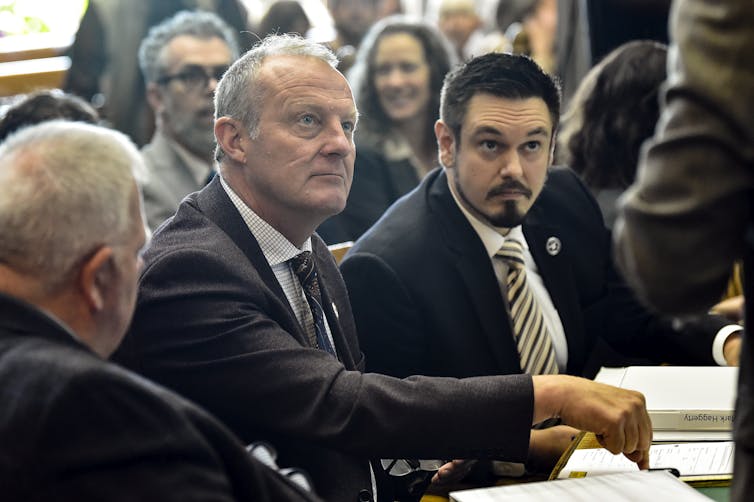
A number of Canadian environmental law scholars argue forcefully that even though Canada’s Charter is silent on the need to protect the Earth’s critical life-support systems — clean air, water and a stable climate — the rights to life, equality and security of the person will be meaningless on a dying planet and therefore must be interpreted with reference to ecological sustainability.
Indeed, the core argument advanced in the ongoing youth climate case in Canada, La Rose v. His Majesty the King, is that the federal government has a constitutional duty to protect Canadian youth and future generations from climate change. A decision by the Federal Court of Appeal in the La Rose case is expected soon.
If the youth plaintiffs prevail, the case will proceed to a trial. If the court rules in favour of the federal government, the youth plaintiffs will almost certainly appeal to the Supreme Court of Canada.
The Montana decision, however, as strong an endorsement as it is of climate science and renewable energy alternatives to fossil fuels, will not likely assist the youth plaintiffs in the La Rose case. The Montana decision is legally distinguishable because its constitution includes an express — as opposed to an implied — right to a clean and healthful environment.
The same goes for Canadian arguments advancing the common law public trust doctrine, which is already expressly codified in the Montana Constitution.
A Constitutional Challenge
The other key climate law case in Canada is the Supreme Court of Canada’s pending decision in Alberta’s constitutional challenge to the federal Impact Assessment Act. Here, too, the Montana decision is a sobering reminder of the limitations of constitutional litigation when it comes to advancing climate policy.
If the Montana decision stands, state agencies will have the discretion to consider GHG emissions and climate change when reviewing energy projects. But as the Supreme Court of Canada case illustrates, the key question is not whether climate change is considered, but how.
After all, Canada approved the Bay du Nord offshore oil project under the Impact Assessment Act, contrary to Alberta’s claims that the “no more pipelines law” will block future fossil fuel development.
Beyond Symbolism
But that does not mean that the Montana decision is merely a symbolic victory. It’s a strong vindication of independent scientific expertise and its relevance to climate and energy policymaking.
The Montana decision also reaffirms the potential of collective action and collaboration among youth, environmental lawyers, and climate change scholars.
The Montana court joins other courts around the world in highlighting the problem of delaying climate action, which requires youth and future generations to make even faster, more radical and more expensive emissions reductions down the road.

Germany’s highest constitutional court, for example, held that it was unconstitutional for the government to make decisions today that lock-in future harms and place a disproportionate burden on future generations. Yet Germany is still struggling to implement the court’s ruling by enacting a sufficiently ambitious emissions reduction plan. Judicial rulings must be founded on and sustained by sufficient political support to make a real difference on the ground.
Thus, the key now is to build on the court’s strong decision and take the fight to the democratic political arena where more than one Canadian provincial premier continues to deny their government’s responsibility to urgently act on climate change.
Verdicts send strong messages, but democratic politics is required to turn messages into policy.![]()
Jason MacLean, Adjunct professor, Environment and Sustainability, University of Saskatchewan
This article is republished from The Conversation under a Creative Commons license. Read the original article.
Trees, rivers and mountains are gaining legal status – but it’s not been a quick fix for environmental problems
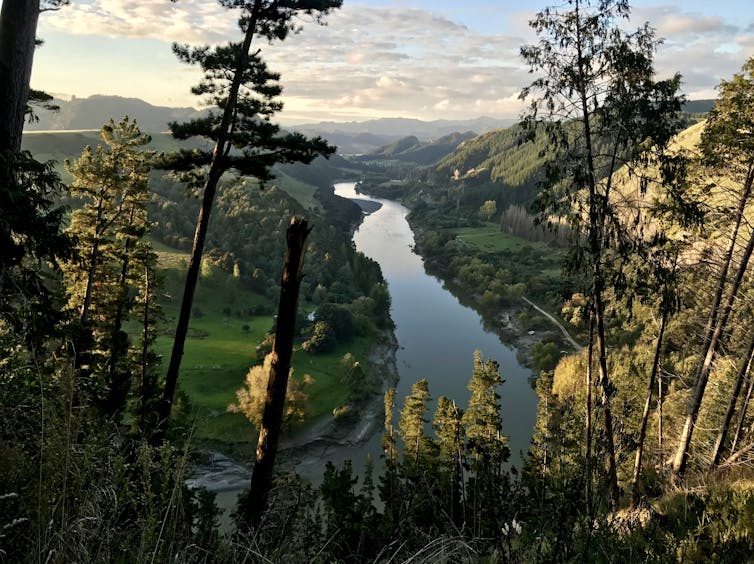
As the scale and severity of environmental issues become more obvious, lawmakers are experimenting with new ways to protect nature. One approach that has gone from blue-sky debate to meaningful reality over the past 50 years is to give elements of the natural world – trees, rivers and mountains – legal rights and allow people to go to court on their behalf.
In 2022, Spain’s Mar Menor saltwater lagoon became the first ecosystem in Europe to be granted a limited legal status similar to a company. Meanwhile, Ireland’s recent Citizens’ Assembly on Biodiversity Loss concluded with a recommendation to amend the constitution to include a provision on the rights of nature.
This idea can be traced back to the early 1970s, when American legal scholar Christopher Stone spontaneously threw it into a classroom discussion about the gradual expansion of rights, and was pleasantly surprised by the positive response it got.
He knew that the US Supreme Court was about to hear an important case on what lawyers call “standing” (whether or not one has the right to be heard by a court in a particular dispute), in which an environmental organisation called the Sierra Club was seeking to prevent the development of a ski resort in the Sequoia National Forest. Stone also knew that one of the justices, William O. Douglas, who was well known for his environmental sympathies, would be writing a foreword to an issue of a legal journal.
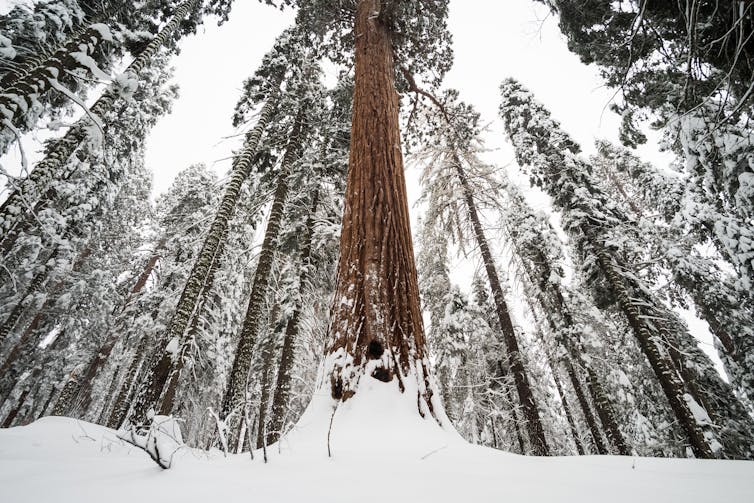
Stone quickly wrote an article called Should Trees Have Standing?, elaborating on his initial thought just in time to get it into that issue. Douglas picked up the idea and endorsed it in his judgment, saying: “The river as plaintiff speaks for the ecological unit of life that is part of it. Those people who have a meaningful relation to that body of water — whether it be a fisherman, a canoeist, a zoologist or a logger — must be able to speak for the values which the river represents and which are threatened with destruction.”
Though this did not sway the other members of the Supreme Court, it did spark a brief flurry of academic writing on the subject (the ski resort was never built anyway). Stone became a media celebrity for a short while before the idea of giving parts of nature legal rights faded from the public eye.
Fast forward to the 21st century and academics alongside environmental activists have given the idea a new lease of life. It has grown to include different schools of thought and these theories are now being put into practice worldwide.
So far, they have not been a quick fix for environmental problems. But they are leading to some successes.
More experiments may help identify how to make them work well effectively. But simply granting rights to nature is probably not a substitute for strong institutions and meaningful enforcement. This becomes clear when we explore the experiences of three different countries.
New Zealand
In 1840, the Treaty of Waitangi was signed between the British crown and New Zealand’s indigenous Māori people. The treaty aimed to protect the Māori people’s right to their land and resources.
As part of a settlement to remedy past breaches of the treaty, both a former national park called Te Urewera and the Whanganui River have been recognised in New Zealand law as entities with their own rights (although not all the rights of a human person) since 2014 and 2017 respectively. This has involved the creation of two boards to manage the natural resources, featuring joint representation from the government and the local tribe.
Plans for rethinking Te Urewera are still being formulated, and representation for the Whanganui River has only recently been appointed (like many things, it was delayed by the COVID pandemic). However, a strategic plan will be developed in tandem with a NZ$30 million (£14 million) fund to support the river’s health and wellbeing.
Time will tell if reframing this process so that nature itself has a voice will yield better outcomes.
Bangladesh
In 2019, the High Court of Bangladesh recognised the Turag River (and all other rivers in Bangladesh) as a living entity with legal rights and required that the government take significant action to protect it.
The state agency with overall responsibility, the National River Conservation Commission, has promised rapid action. But, still today, many water bodies in the country are “dead” thanks to pollution caused by the widespread dumping of industrial and human waste.
The Buriganga River, which flows south-west of Bangladesh’s capital city of Dhaka, is now so polluted that its water appears black outside of the monsoon season.

Ecuador
In 2008, Ecuador adopted a new constitution that includes an article explicitly recognising nature’s right to “exist, persist, maintain and regenerate its vital cycles, structure, functions and its processes in evolution”. This development has enabled landowners and environmentalists to bring cases to court to protect the country’s rivers and forests, slowly making this right a reality.
A striking example of this unfolded in 2021 when the Ecuadorian Constitutional Court revoked mining permits in Los Cedros – a cloud forest area of great biodiversity in the Andean mountains. It asserted that these permits not only violated the rights of local residents (such as the right to clean water and a healthy environment), but also the rights of the forest itself.
This is a significant step with ramifications for the future. However, it also highlights a common objection: that environmental matters frequently also include some form of human interest that can serve as a basis for legal standing. Consequently, granting nature rights may be unnecessary.
Whether they work or not, some form of rights for aspects of nature are likely to become part of most legal systems this century. Anyone with an interest in environmental protection should be aware of the idea and its development.

Don’t have time to read about climate change as much as you’d like?
Get a weekly roundup in your inbox instead. Every Wednesday, The Conversation’s environment editor writes Imagine, a short email that goes a little deeper into just one climate issue. Join the 20,000+ readers who’ve subscribed so far.![]()
Rónán Kennedy, Associate Professor, University of Galway
This article is republished from The Conversation under a Creative Commons license. Read the original article.
Rising methane could be a sign that Earth’s climate is part-way through a ‘termination-level transition’
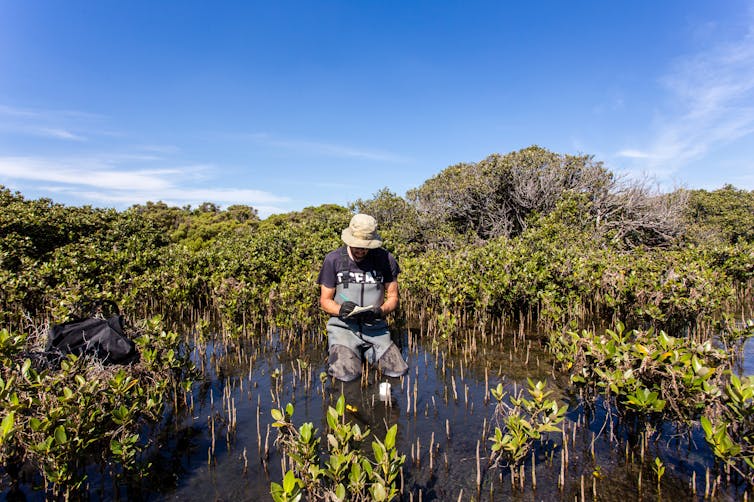
Since 2006, the amount of heat-trapping methane in Earth’s atmosphere has been rising fast and, unlike the rise in carbon dioxide (CO₂), methane’s recent increase seems to be driven by biological emissions, not the burning of fossil fuels. This might just be ordinary variability – a result of natural climate cycles such as El Niño. Or it may signal that a great transition in Earth’s climate has begun.
Molecule for molecule, methane is a much more potent greenhouse gas than CO₂ but it lasts slightly less than a decade in the atmosphere compared with centuries for CO₂. Methane emissions threaten humanity’s ability to limit warming to relatively safe levels. Even more troubling, the rate at which methane is increasing in the atmosphere has accelerated recently. Something like this has happened before: sudden surges in methane marked the transitions from cold ice ages to warm interglacial climates.
Methane was about 0.7 parts per million (ppm) of the air before humans began burning fossil fuels. Now it is over 1.9 ppm and rising fast. Roughly three-fifths of emissions come from fossil fuel use, farming, landfills and waste. The remainder is from natural sources, especially vegetation rotting in tropical and northern wetlands.
Methane is both a driver and a messenger of climate change. We don’t know why it is now rising so rapidly, but the pattern of growth since late 2006 resembles how methane behaved during great flips in Earth’s climate in the distant past.
The Methane Record: 2006 To Present
In late 2006, atmospheric methane unexpectedly began rising. Methane had risen fast in the 19th and 20th centuries but plateaued by the end of the 1990s. This rise was driven by fossil fuel emissions, especially from gasfields and coal mines.
Imagine accelerating a car with your foot flat down. The car speeds up but eventually air resistance equals engine power and the car hits maximum speed. In 1999, it looked like methane had reached a similar equilibrium between its sources and sinks. Then in late 2006, the amount of methane in the air climbed fast. Even more unexpectedly five years later, the rate of growth sped up again. During the 2020s the growth rate has become yet faster, faster even than during the peak of gas industry leaks in the 1980s.
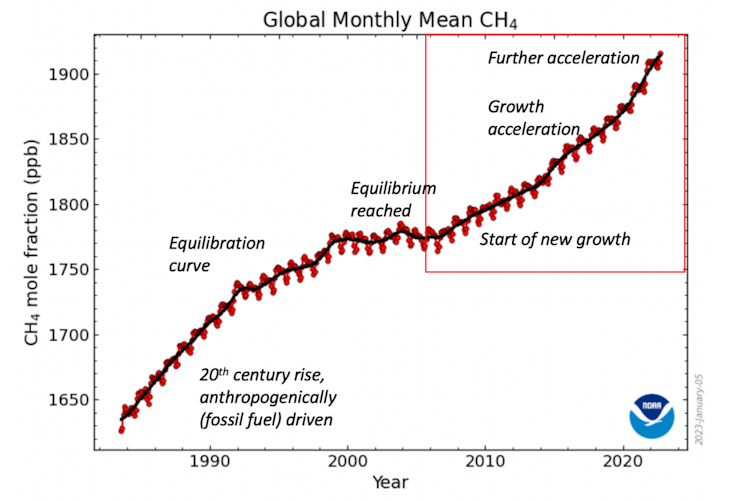
Today’s growth seems to be driven by new emissions from wetlands, especially near the equator but perhaps also from Canada (beavers are methane factories which pull huge amounts of plant matter into ponds they’ve made) and Siberia. This is a result of climate change: increasing rainfall has made wetlands wetter and bigger while rising temperatures have boosted plant growth, providing more decomposing matter and so more methane. Emissions from huge cattle lots in tropical Africa, India and Brazil may also be rising and rotting waste in landfills near megacities like Delhi are important sources too.
Climate Terminations
In the past few million years, Earth’s climate has flipped repeatedly between long, cold glacial periods, with ice sheets covering northern Europe and Canada, and shorter warm inter-glacials.
When each ice age ended, Earth’s surface warmed by as much as several degrees centigrade over a few millennia. Recorded in air bubbles in ice cores, sharply rising methane concentrations are the bellwethers of these great climate-warming events. With each flip from a glacial to an interglacial climate there have been sudden, sharp rises in atmospheric methane, likely from expanding tropical wetlands.
These great climate flips that ended each ice age are known as terminations. Each has a Roman numeral, ranging from Termination IX which happened about 800,000 years ago to Termination IA which initiated the modern climate less than 12,000 years ago. For example, around 131,000 years ago during Termination II, the British climate suddenly flipped from glaciers in the Cotswolds to hippopotami wallowing in what is now Trafalgar Square.
Full terminations take several thousands of years to complete, but many include a creeping onset of warming, then a very abrupt phase of extremely rapid climate change that can take a century or less, followed by a longer, slower period during which the great ice caps finally melt. In the abrupt phase of the great change that brought about the modern climate, Greenland’s temperature rose by around 10°C within a few decades. During these abrupt phases, methane climbs very steeply indeed.
Is Something Dramatic Underway?
Methane fluctuated widely in pre-industrial times. But its increasingly rapid growth since 2006 is comparable with records of methane from the early years of abrupt phases of past termination events, like the one that warmed Greenland so dramatically less than 12,000 years ago.
There is already lots of evidence that the climate is shifting. Atlantic ocean currents are slowing, tropical weather regions are expanding, the far north and south are warming fast, ocean heat is breaking records and extreme weather is becoming routine.
In glacial terminations, the entire climate system reorganises. In the past, this took Earth out of stable ice age climates and into warm inter-glacials. But we are already in a warm interglacial. What comes next is hard to imagine: loss of sea ice in the Arctic in summer, thinning or partial collapse of the ice caps in Greenland and West Antarctica, reorganisation of the Atlantic’s ocean currents and the poleward expansion of tropical weather circulation patterns. The consequences, both for the biosphere in general and food production in south and east Asia and parts of Africa in particular, would be very significant.
There’s much to be done that could hastily stop methane’s rise: plugging leaks in the oil and gas industry, covering landfills with soil, reducing crop-waste burning. Shooting the methane messenger won’t stop climate change, which is primarily driven by CO₂ emissions, but it will help.
Roman numerals IX to I denote past great climate transitions. There is no Roman number zero, but then any future termination-scale transition will be different – a temperature step from our present interglacial climate to some new future that is warmer yet. Methane’s signal is still unclear, but the question remains: has Termination Zero begun?

Don’t have time to read about climate change as much as you’d like?
Get a weekly roundup in your inbox instead. Every Wednesday, The Conversation’s environment editor writes Imagine, a short email that goes a little deeper into just one climate issue. Join the 20,000+ readers who’ve subscribed so far.![]()
Euan Nisbet, Professor of Earth Sciences, Royal Holloway University of London
This article is republished from The Conversation under a Creative Commons license. Read the original article.
Why moths might be more efficient pollinators than bees and butterflies
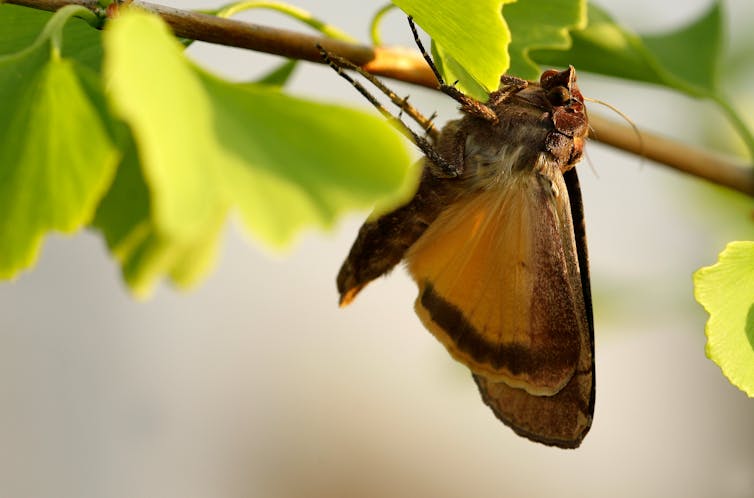
If you’ve ever felt underestimated and ignored, spare a thought for your local moths. Honeybees, bumblebees and butterflies are almost synonomous with pollination. People love them for their intimate relationship with flowers – we can’t grow a lot of our food or enjoy the sight of fragile springtime blossom without them. But our recent research showed moths may actually be more efficient pollinators.
Almost all scientific research on pollinators happens during the day, which means we know little about what happens at night. So we designed a study to compare the contribution of nocturnal and day-active pollinators. We focused on bramble, which is widespread across Europe. People often look at bramble as a prickly pest that needs to be removed from our green spaces. But it is a crucial source of nectar and pollen for bees, butterflies and moths, flowering from early spring through until the autumn.
During peak summer in the UK, when we carried out our experiment, the night is only around one-third of the entire day cycle. During this time, moths are almost the only insects that visit flowers. Even though 83% of all flower visits in our study happened during the day, pollination rates were higher at night time. This suggests moths are more efficient pollinators than species that are active during the day.
We used trail cameras to record visitors to bramble flowers over three days and placed special bags over the flowers so we could compare their pollination rates. One group of flowers was covered for the whole three days. The second group was covered only during the day time and a last set was covered only at night. It wasn’t possible to identify the species of every moth that visited the flowers, but among them were silver Y and large yellow underwing moths, which are both in the family Noctuidae.
While it remains unclear precisely why moths had higher pollination rates, it may be that they spend more time visiting each flower than honeybees, hoverflies and other daytime pollinators. In any case, it’s certain that the importance of moths as nocturnal pollinators is undervalued. Despite the fact there are only 60 species of butterfly and over 2,500 species of moth in the UK, a far higher proportion of research and environmental policies focus on butterflies.
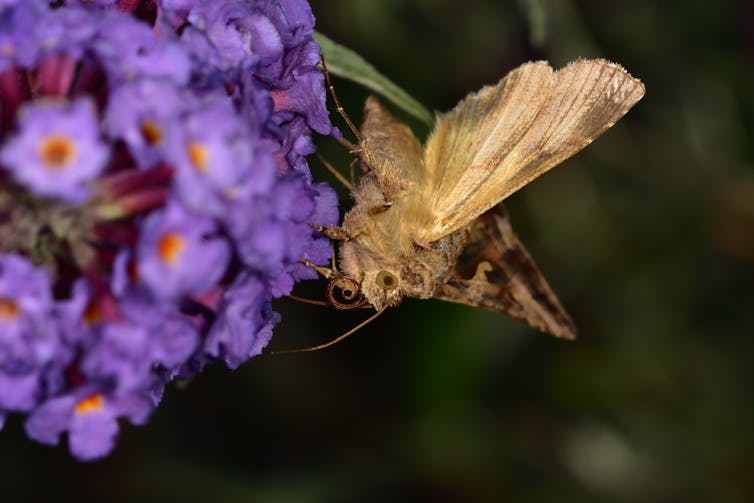
Our study showed that the pollination of valuable crop plants and threatened species of wildflowers may rely upon on moths. Many of the UK’s macro-moths (which tend to be larger) are declining, with over 40% of species declining in abundance.
Under Pressure
Moths face the same challenges as daytime pollinators, such as pesticides, habitat loss and climate change. But nocturnal moths are also threatened by artificial light at night. Recent research has highlighted how street lighting is disrupting the feeding behaviour of caterpillars and reducing moth numbers. Previous work has also shown the light disrupts adult moths from feeding, breeding and laying eggs.
Moths are not only important pollinators – they are key links in the food chain and shape the structure and composition of habitats. Their caterpillars feed on grasses and other plants. When caterpillars are dispersed throughout a habitat, some areas are grazed and others are not, which creates a varied structure. This variety bodes well for biodiversity, by creating a greater range of habitats for different species to live in. Not to mention the importance of moths as a vital food source for bats, birds and other small mammals.
New approaches to research are being developed and tested, which will help address gaps in our understanding about the role of moths as important pollinators.
For example, automated identification and tracking of insects through machine learning can allow us to remotely monitor pollinator activity, saving time in collecting and processing data. Understanding more about moths will give us the knowledge we urgently need to protect them.
What You Can Do
You can help these pollinating insects by allowing some patches of bramble and other flowering, scrubby plants to grow in your garden, allotments and hedgerows. You can also encourage your council to do the same across the network of road verges and parks in the UK.
The harmful effects of artificial light can be managed by dimming or limiting the operating time of street-lighting during the night, as pioneered by Devon and some other district councils. At home, you can switch off or reduce the use of outdoor lights at night and close your curtains and blinds to prevent light from spilling outside. Tackling light spill from shop fronts and glass office blocks could also help moths stay focused on pollination.
In light of the huge declines in populations of pollinating insects across the globe, it’s more important than ever to protect our pollinators. These small and simple changes will provide more homes for wildlife. Spreading the word could have a crucial impact on moth conservation – some of the most underappreciated and important animals on our planet.

Don’t have time to read about climate change as much as you’d like?
Get a weekly roundup in your inbox instead. Every Wednesday, The Conversation’s environment editor writes Imagine, a short email that goes a little deeper into just one climate issue. Join the 20,000+ readers who’ve subscribed so far.![]()
Fiona Mathews, Professor of Environmental Biology, University of Sussex and Max Anderson, South West Landscape Officer for Butterfly Conservation
This article is republished from The Conversation under a Creative Commons license. Read the original article.
Rod Stewart - Rhythm Of My Heart
Vietnam Veterans Remembered 50 Years On From Australian Troop Withdrawal

Financial Report On The Australian Aged Care Sector 2021-22
- Home care
- Residential care
- Commonwealth Home Support Programme
- Future demand for aged care
- the implementation of the Australian National Aged Care Classification funding model, which commenced on 1 October 2022
- an additional 9,500 home care places in 2023-24
- the expanded role of the Independent Health and Aged Care Pricing Authority, which will ensure care funding moves in line with the costs of delivering care
- funding for higher wages for aged care workers
- additional investment into nursing and care.
Australia's Progress In Advance Care Planning: Challenges And Innovations
Digital Puzzle Games Could Be Good For Memory In Older Adults
95% male conductors, 70% ageing classics and zero appetite for risk: what’s wrong with elite Australian opera
Caitlin Vincent, The University of Melbourne; Bronwyn Coate, RMIT University, and Katya Johanson, Edith Cowan UniversityThe stories told on the operatic stage have received critical attention for their representation of gender, particularly the often violent fate of their heroines.
But little attention has been paid to women’s representation behind the scenes in Australia. In part, this is due to a lack of readily available data about women’s actual status within opera companies.
We have now created a unique dataset to address this gap.
We looked at the production credits for staged operas presented by Opera Australia, Opera Queensland, the State Opera of South Australia, Victorian Opera and West Australian Opera from 2005 to 2020.
For each production, we tracked the gender profile of the practitioners credited as conductors, directors and designers. We looked at who was credited when, and on which kinds of operas.
We found evidence of pervasive gender inequality.
Gender Inequality At Top Opera Companies
Across the five companies, women were hugely underrepresented in the core creative leadership roles of conductor and director.
Women held just 5% of conductor credits over the 16 seasons, and less than a quarter of director credits. Not only were women less likely to see initial credits compared to men, they were also less likely to have opportunities to work on more than one production.
At individual companies, women’s representation was lowest at Opera Australia and the State Opera of South Australia.
Less than 3% of conductors and 19% of directors credited at Opera Australia were women. The State Opera of South Australia did not credit a single woman conductor between 2005 and 2020 and just 17% of its credited directors were women.
In comparison, two of the smallest companies – Opera Queensland and Victorian Opera – had by far the highest representation for women in both roles.
Women also saw low representation as designers, comprising 21% of set designers and 9% of lighting designers. Women were much more likely to be credited in the feminised role of costume designer.
Inequality Is Greatest In Productions Of The Canon
The kinds of operas programmed also affected women’s representation as conductors, directors and designers.
Canonical works like Puccini’s La bohème (1895) and Bizet’s Carmen (1875) are seen as low-risk because they are recognised as masterpieces of the genre and are popular with existing opera audiences.
Canonical operas dominated programming at four of the five companies, followed by slightly less popular works from the 19th century and earlier, such as Rossini’s La Cenerentola (1817) and Bizet’s Les pêcheurs de perles (1863).
The combination of canonical and slightly less canonical works comprised 84% of programming at West Australian Opera, 79% at Opera Australia, 73% at Opera Queensland and 64% at the State Opera of South Australia. (The outlier, Victorian Opera, explicitly focuses on modern operas.)
However, women practitioners were notably absent from the production teams for these popular works. On canonical operas, women’s representation as conductors dropped to less than 1%. Women directors and designers saw almost universal drops in representation across both categories of repertoire.
Instead, women were more likely to be credited on high-risk modern operas. These works are thought to be less popular with audiences and are programmed less frequently and for fewer performances than canonical works.
Women also had higher levels of representation in musical theatre works, popular with audiences but traditionally holding little prestige in the sector.
Risk Perception And Gender Inequality
Beyond the risk associated with different operas and their ability to attract audiences, a contributing factor for gender inequality in opera is how “risky” certain practitioners are thought to be.
Studies from the creative industries have shown perceptions of risk in the arts are deeply gendered, particularly when it comes to hiring for key artistic or governance roles. While men practitioners are seen as reliable, women are seen as inherently risky.
These biases are exacerbated in fields like opera where work opportunities are driven by personal networks and professional visibility, both of which favour men.
Risk perceptions also have compounding effects. Because modern operas are already seen as “risky”, it appears these productions can take the “risk” of employing women – whereas canonical operas, programmed because they are “safe”, also make the “safe” choice in hiring men.
Risk Aversion In Funding Enables Gender Inequality
Entrenched gender bias is difficult to shift in any field. But with Australia’s opera companies, government funding policies are exacerbating the field’s existing inequality.
Here again, it comes down to questions of risk.
Australia’s peak arts funding body, now named Creative Australia, has a particular focus on mitigating risk – both financial and artistic – through its operatic policies.
In exchange for multi-year funding support, companies are expected to maintain financial targets and prioritise programming operas that are low-risk financially. Companies are also encouraged to rent existing productions from Opera Australia or co-commission new productions with other companies.
These policies are laudable for their attention to efficient public spending and co-operation. But policies can have unintended impacts.
By encouraging companies to program low-risk popular operas, Creative Australia is trying to mitigate financial risk. But such policies don’t take into account the fact that women practitioners are largely absent from these works.
In the same way, policies that promote co-operation don’t consider how this leads to companies reproducing gender imbalances. Opera Australia is framed as a key source of rental productions for other companies but also has some of the lowest rates of representation for women directors and conductors.
It is critical that arts funding bodies and policymakers consider the practical impacts of their policies. At the same time, opera companies need to acknowledge the extent to which their own organisational practices are driving inequality within the sector.
The scale of gender inequality at work in Australian opera production won’t be easily remedied. But shining a light on the extent of the problem is a start towards making the sector accountable for its performance, both on and off the stage. ![]()
Caitlin Vincent, Lecturer in Creative Industries, The University of Melbourne; Bronwyn Coate, Senior Lecturer in Economics, RMIT University, and Katya Johanson, Professor of Audience Research, Edith Cowan University
This article is republished from The Conversation under a Creative Commons license. Read the original article.
Running This Week: The Chiltern Trail On The Verge Of Spring 2023 By Kevin Murray And Joe Mills
August 10, 2023
A terrific walk on a terrific day... 6.8 kilometres on the Chiltern Track at Ingleside, with Glenys and Joe. Whew! I took a picture or two that you might enjoy...
(Did I mention it was 6.8 kilometres?)
Kevin M.
.jpg?timestamp=1692296735941)
Chiltern has a meaning of, relating to, or being chalky, sandy, gravelly, and loamy soils of England that are naturally dry and lie in dry situations.
The Warringah Shire Council meeting held December 20th 1954 records:
Street Names – Shire Engineer’s Report
h) Stating that attempts are being made to establish a Progress Association in the area between Ingleside and Church Point, the proposed name being ‘’Cicada Glen’’, that letters from the provisional Hon. Secretary refer to Chiltern Road, running north from Mona Vale Road some distance west of the road to the new sanitary depot; and suggesting that the Council officially name this road Chiltern Road. Resolved, - That this suggestion be adopted. (Crs. Hewitt, McKay)
The Chiltern Trail is a firetrail that goes from the end of Chiltern Road in Ingleside down to McCarrs Creek Road.
This affords you great views over the district, stretches to t he Lower Gledhill Falls, where McCarrs Creek plunges over a cliff into a pool. You can also access from the other side of the creek by following McCarrs Creek from The Duckhole.
You can also access Crystal Creek, which is to the east of the trail as it flows down to McCarrs Creek Road.
Length: 6.8 km - you need to be fit will take 2-3 hours in and back. Best walked in Autumn, Winter or Spring.
One for those of us who aren't quite as fit as this happy trio - thank you very much Glenys, Kevin and Joe - BEAUTIFUL! Head over to the Pictures page and enjoy this week's Pictorial.
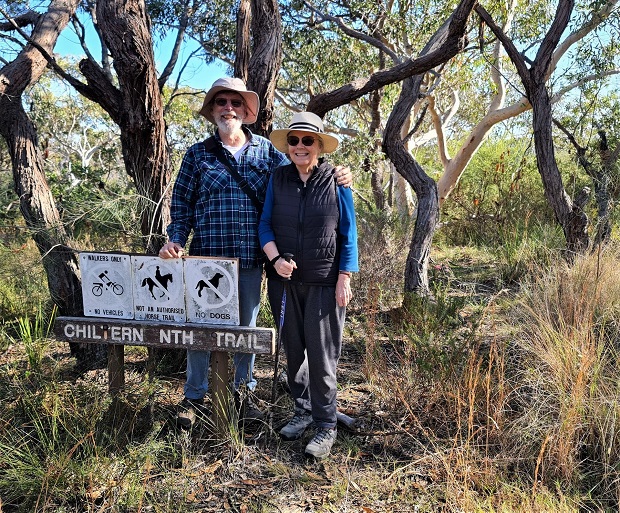
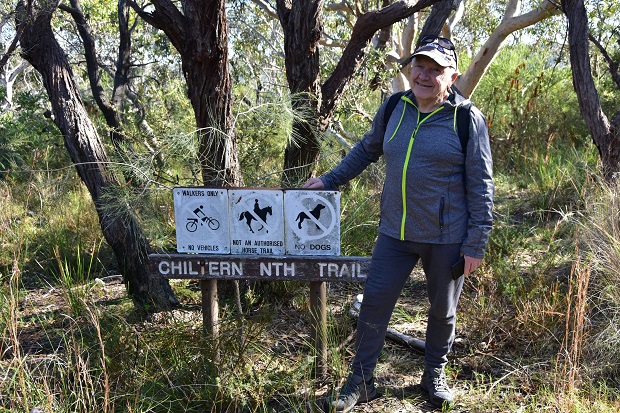
2024 NSW Seniors Festival To ‘Reach Beyond’
APSC Releases Capability Review Report For The Department
Wildfires And Farming Activities May Be Top Sources Of Air Pollution Linked To Increased Cases Of Dementia
Interested, curious and empathetic, Michael Parkinson helped bridge the gap between Australia and England
Lea Redfern, University of SydneyMichael Parkinson, who has died at 88, demonstrated the art of the good interview night after night. He practised deep listening, giving his interviewee his full attention, but he was always aware of the audience. While he was asking questions on behalf of the audience and advocating for the audience, he always had the person he was interviewing as his focus.
As host of Parkinson (1971–82 and 1998–2007) and Parkinson in Australia (1979–83), he was a big presence on Australian TV. He was television the whole family could watch together, never unsuitable for children.
We may not have understood everything, and some references went over our head, but as children we could watch Parkinson with our parents. I remember as a young person regularly watching him and hoping the interview would be funny that week.
There were times you knew it was going to be hilarious. When Billy Connolly or “our” Dame Edna were going to appear it was a must-watch.
Whoever the interviewee, Parkinson brought out their stories, their observations. He gave them space to share engaging stories and never stepped on a punchline. Although humour was a draw card for the audience, there was space for pathos, too.
Finding The Shape
Parkinson was an interviewer of great skill. He could be a presence, but never pull focus from the interviewee. He was deeply empathetic, and always in control of the interview.
The form of the interview was always satisfying: he knew how to draw a narrative through the length of the program. When interviewing three people at once, he knew how to be fair and have a balance between everyone and their stories. He made this appear effortless.
From 1979 to 2014 he frequently worked in Australia across the ABC, Channel Ten and Channel Nine.
For a generation of ten pound passage immigrants, he represented the best of the old country: he was never patronising, never spoke down to people, and helped to bridge the gap between Australia and England. He was able to bring us the best of British and Australian interviewees alike, affirming Australia’s international standing in the arts and culture.
When speaking to Australian politicians, sports stars and actors he was always deeply interested and deeply curious. He could reflect us back to ourselves without any of the cultural cringe so evident in the media of the time. The affection Australians felt for him is shown in the diminutive “Parky”.
An Authentic Voice
Born in Yorkshire in 1935, Parkinson didn’t attend university, starting his career working for newspapers straight out of school. It was perhaps this start which aided in his plain speaking common sense and ability to talk to ordinary people. You got the sense he could speak to anybody. There was no putting on a persona; he was always authentically him.
Today, this authentic self is seen in many of our best interviewers. We know how important it is curiosity and authenticity drive the interview – Parkinson was doing this decades before others recognised its importance.
When I started in radio, I looked towards Parkinson as the gold standard. I admired how he was able to draw people out and reveal so much of themselves. He demonstrated how the media could go beyond the soundbite.
So much of the media of the time was about context-free news and current affairs journalism. Although his interviews were with celebrities, he showed people might share more of themselves and the world if they’re given time and space to speak. Parkinson gave us a fuller, richer sense of the people he spoke to.
His legacy in Australia can be seen in people like Andrew Denton, Richard Fidler and Sarah Kanowski – long form interviews driven by curiosity.
Some people have been describing Parkinson’s death as the end of an era, but his legacy will live on. When we look at shows like ABC Conversations, and so many longform podcasts, we find curious interviewers who, like Parkinson, build a relationship and find a connection with an interviewee. A soundbite might show up on TikTok or YouTube – but you have to do the longform interview to get there.
Perhaps one of the best demonstrations of this was Parkinson’s interview with Ian Thorpe. In the 2014 interview, Thorpe came out publicly for the first time, and spoke about his depression and use of drugs and alcohol.
Without the relationship Parkinson was able to build over the course of the interview, it is doubtful Thorpe would have felt comfortable to come out in the same way. Parkinson was always interested in giving people the opportunity to reveal themselves.
That Thorpe felt Parkinson’s show was a safe space to come out says something about the tenor of his relationship with his interviewees and his place in Australian culture.
There For The Audience
His few missteps seemed to be with women. As I grew older, I realised he was a man of his time, as was made obvious in his awkward interviews with Meg Ryan and Helen Mirren. In these interviews, his occasional awkwardness around gender is writ large, and the interviews go off the rails. He fails to develop his famous rapport and adjust his approach in response to their discomfort.
But given the length of his career, the rarity of these missteps is still impressive. His geniality and quiet generosity came across night after night, for decades.
What defined him more than anything was how he was inclusive of his audience. No matter how complex the ideas or how smart the person he was interviewing, the audience was brought along with them. He was there on our behalf, and able to ask the clarifying questions without worrying about his own ego.
He represents an age of Australian and British relationships in a way that is truly singular and his interviews are artefacts of that age. He was an interiewer who stood out for not having to stand out, and the delights and possibilities of the long-form interview are his legacy.![]()
Lea Redfern, Lecturer, Discipline of Media and Communications, University of Sydney
This article is republished from The Conversation under a Creative Commons license. Read the original article.
2024 NSW Seniors Festival Grants Program Applications Open

- supporting a broad range of local community organisations
- supporting programs and activities in regional NSW
- fostering partnerships with community groups and services
- providing programs and activities for diverse communities in NSW
- supporting projects that empower older people to stay connected
- assisting organisations to increase capacity of current programs and activities.
- Up to $5,000 for local community programs and activities.
- $5,001 - $10,000 to local government organisations for large scale community and regional programs and activities – funding is available to local government organisations only.

The Rions

Website: therions.com/home
Instagram: www.instagram.com/therionsband
Tik Tok: www.tiktok.com/@therionsband
Facebook: www.facebook.com/TheRionss
There will be no better way to spring into Spring and Summer 2023 than tuning in to the sounds coming from Pittwater band and former Barrenjoey High School alumni The Rions this September through November. To back up newly released EP 'Minivan' the boys will be on the road, taking it to the streets, and nightclubs, in a tour that stretches from Queensland to Tassie and even a jaunt over to Western Australia. Although only one local gig is scheduled so far, at Dee Why and 18+, included are performances with the Grapevine Gathering national tour, indicating The Rions are happy to inspire locals to join the road trip phenomenon to 'see and be in other places' during Australia's warmer months.
First forming as a band following a 2016 high school talent show, when they were in Year 7, their music teacher Mr Stone (father of Angus & Julia) saw something special and encouraged the boys to get gigging.The name stems from the inability of Harley to pronounce the word ‘lion’ when a toddler; he would pronounce it ‘rion’. He had been telling fellow band members about this when the organisers asked them what they were going to be called and the spontaneous response from his band mates was ‘The Rions!’.
The band consists of Noah Blockley (lead vocals, bass guitar), Harley Wilson (guitar), Asher McLean (guitar), and Tom Partington (drums).
They started performing in our area at the age of 13 and have ventured through a multitude of genres, citing Arctic Monkeys, Lime Cordiale, Spacey Jane, and Dayglow as their musical influences.
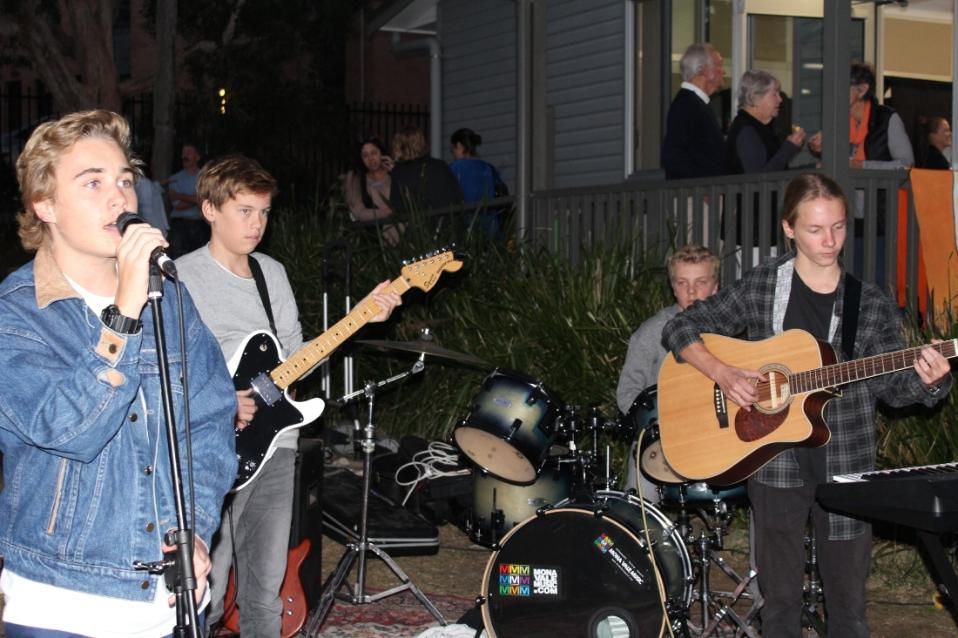
Besides being talented musicians they also have ‘put back’ into our local community – just some of these 'fronting ups' were making music at the opening of the Avalon Youth Hub in 2018, playing the Breath Festival in 2019 and teaming up with Marvell in 2020 to help 2019/2020 fire impacted Mogo Public School at Batemans Bay when BHS was raising funds for these youngsters.
At just 17 years old, their natural talent and hard work helped them create a loyal following, winning a spot in the Bluesfest Busking Comp Grand Final, taking out the Northern Composure Audience Choice Award and winning Triple j’s Unearthed High 2021 with their single ‘Night Light' produced alongside Callum Howell (Ocean Alley).
The win built on the momentum of debut singles ‘Sadie‘, ‘Halfway Out‘ and ‘Head Still Hurts’, followed by ‘Disassociation’ and ‘Anakin’, each stronger than the last.
Since, The Rions racked up some 10 million streams worldwide, gone back-to-back in consecutive Hottest 100 countdowns and drawn praise from the likes of even the most unlikely of fans in Avatar’s Sam Worthington. Night Light would land at No. 51 on triple j’s Hottest 100 countdown for 2021, and they’d follow it up with Anakin which appeared at No. 64 in 2022.
The Rions runs as Profile of the Week this Issue. A taster:
Bring Back Memories Not Measles
Fun Little Wave At South Av. - Tuesday August 15, 2023
Pictures From The Past: Palm Beach In 1921
Warringah Shire Council's Minutes from Meetings records, from the Meeting of 19th September, 1921:
Palm Beach (Item 26). The Palm Beach Progress Association's letter, 2/9/21, urging erection of dressing sheds at Palm Beach, and offering to arrange for cost of erection, if Council provide the material, was read in conjunction with the report. Resolved. - (Crs. Hitchcock, Quirk) That the proposal be approved, £5 to be voted for the supply of the necessary material, the (Vote) sheds to be in accordance with the plan submitted by Mr. Kerr, and to be completed to the Council's satisfaction.
Photos by Rex Hazlewood, circa December 1921, courtesy The Mitchell Library, State Library of NSW, Item No.:c046220004h and Item No.:c046220004h show view from Beach road at Palm Beach with dressing sheds in place on the sand and horses plus the view to the beach from the then rock pool at Palm Beach - this was expanded and 'finished' due to a loan to the Council from Mr. Hordern in 1926. He owned the house/ weekender you can see at the far south in this section from a panorama:.
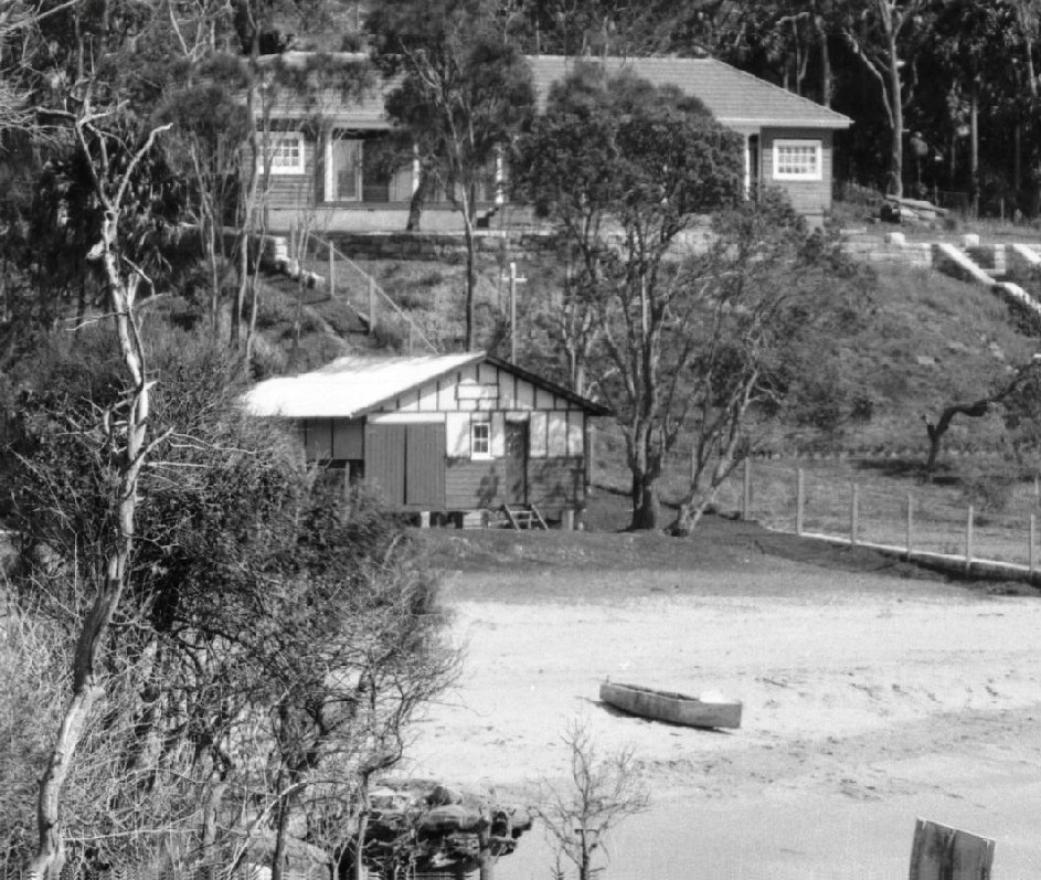
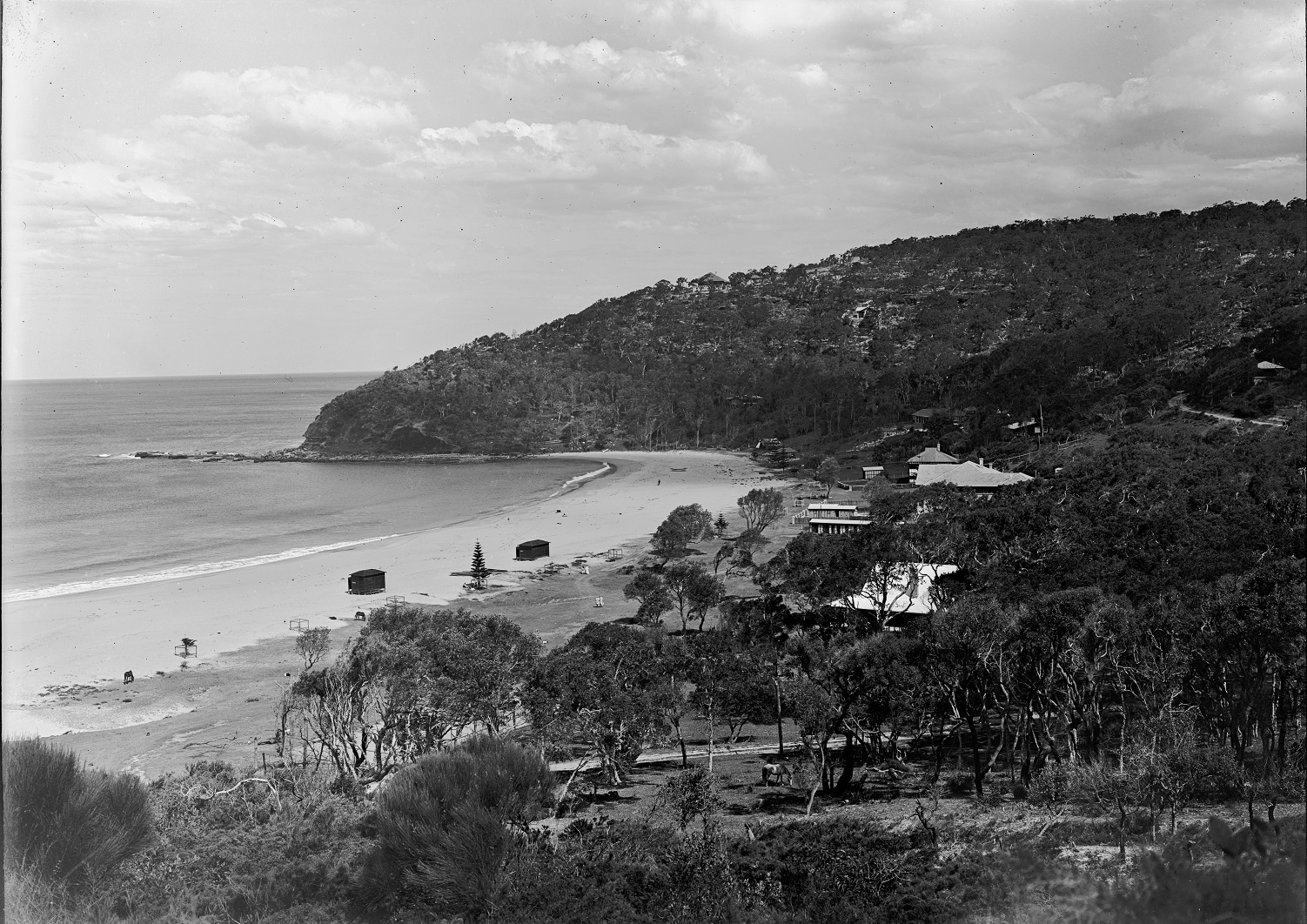

Canberra Today And Tomorrow
Published by the NFSA - From the Film Australia Collection. Made by The Commonwealth Film Unit 1959. Directed by Joe Scully, Rhonda Small and John Martin Jones. The development of Australia’s National Capital. Canberra, the National Capital of Australia, is a city which has been planned; a place where modern living is enriched by a lovely setting. But the hustling young city of today is expanding and developing, and there is emerging the pattern of the proud city of tomorrow.
Find What You're Looking For During Skills Week
National Skills Week starts Monday 21 August.
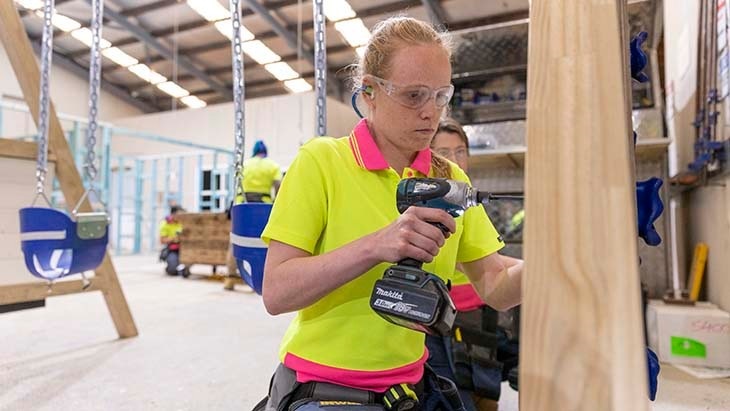 People across NSW are being encouraged to explore and celebrate everything vocational education and training offers during National Skills Week, which starts on Monday 21 August.
People across NSW are being encouraged to explore and celebrate everything vocational education and training offers during National Skills Week, which starts on Monday 21 August.
The Skills Week theme, 'What are you looking for?', highlights the exciting education and career opportunities offered through Vocational Education and Training (VET) pathways.
NSW Department of Education Secretary Murat Dizdar said Skills Week aimed to overturn out-of-date perceptions about the opportunities vocational education offered.
“Our job market is changing rapidly, and the vocational education sector has a key role to play in future-proofing existing and emerging industries,” Mr Dizdar said.
“Vocational education will continue to support the traditional trades but is also crucial for new and emerging industries. For example, our clean energy future will provide terrific jobs based on many of our current trades.”
Mr Dizdar said the line between a university, or a vocational education and training pathway was increasingly being blurred.
“Vocational education and training sits alongside university as an equal partner in the tertiary education sector and the future lies in increased collaboration between these two,” he said.
“The future belongs to those who learn more skills and combine them in creative ways.”
He said Skills Week was also an important time to highlight the work done in opening young people’s eyes to the career opportunities available through the School-based Apprenticeships and Traineeships (SBATs) program in NSW public schools.
Almost 3000 students are currently undertaking SBATs in NSW public schools, a 9.5 per cent increase in participation that is bucking the national trend.
According to the National Centre for Vocational Education Research, NSW has almost 113,000 trainees and apprentices in training, which is more than any other state or territory.
Mr Dizdar said in Skills Week it was also important to highlight the incredible support of employers, who mentor students through their training, and the sector’s world-class educators.
Now in its 13th year, Skills Week celebrates the skills, talents, and career pathways of students, apprentices, trainees, and the wide range of industries they work in.
National Skills Week takes place from 21-27 August, with a launch at the Parliament of NSW on 22 August.
Photo: Almost 3000 students are undertaking School-based Apprenticeships and Traineeships in NSW public schools,
School Leavers Support
- Download or explore the SLIK here to help guide Your Career.
- School Leavers Information Kit (PDF 5.2MB).
- School Leavers Information Kit (DOCX 0.9MB).
- The SLIK has also been translated into additional languages.
- Download our information booklets if you are rural, regional and remote, Aboriginal or Torres Strait Islander, or living with disability.
- Support for Regional, Rural and Remote School Leavers (PDF 2MB).
- Support for Regional, Rural and Remote School Leavers (DOCX 0.9MB).
- Support for Aboriginal and/or Torres Strait Islander School Leavers (PDF 2MB).
- Support for Aboriginal and/or Torres Strait Islander School Leavers (DOCX 1.1MB).
- Support for School Leavers with Disability (PDF 2MB).
- Support for School Leavers with Disability (DOCX 0.9MB).
- Download the Parents and Guardian’s Guide for School Leavers, which summarises the resources and information available to help you explore all the education, training, and work options available to your young person.
School Leavers Information Service
- navigate the School Leavers Information Kit (SLIK),
- access and use the Your Career website and tools; and
- find relevant support services if needed.
Word Of The Week: Credo
Noun
1. a statement of the beliefs or aims which guide someone's actions or the way they live.2. a guiding belief or principle : creed. 3. a creed of the Christian Church in Latin. 4. a musical setting of the Nicene Creed, typically as part of a mass.
From Old English: Latin, ‘I believe’. Compare with creed. From early 13c., "the Creed in the Church service," from Latin credo "I believe," the first word of the Apostles' and Nicene creeds, first person singular present indicative of credere "to believe," from PIE compound *kerd-heart- "to believe," literally "to put one's heart" (source also of Old Irish cretim, Irish creidim, Welsh credu "I believe," Sanskrit śrad-dhā- "faith, confidence, devotion"), from PIE root *kerd- "heart." The nativized form is creed. General sense of "formula or statement of belief" is from 1580s.
*kerd- Proto-Indo-European root meaning "heart."
It is the hypothetical source of/evidence for its existence is provided by: Greek kardia, Latin cor, Armenian sirt, Old Irish cride, Welsh craidd, Hittite kir, Lithuanian širdis, Russian serdce, Old English heorte, German Herz, Gothic hairto, "heart;" Breton kreiz "middle;" Old Church Slavonic sreda "middle."
Creed: (noun) - 1. a system of religious belief; a faith. 2. a formal statement of Christian beliefs, especially the Apostles' Creed or the Nicene Creed. 3. a set of beliefs or aims which guide someone's actions. From Old English creda, from Latin credo.
Hip-hop at 50: 7 essential listens to celebrate rap’s widespread influence

On the evening of Aug. 11, 1973, DJ Kool Herc attended a block party in the South Bronx. Armed with two record players and a mixer, he created an extended percussive break while others rhymed over the beats. Hip-hop was born.
Well, that’s the origin story, although pinpointing the birth of a genre is never going to be an exact science. What is undeniable, though, is that in the 50 years since that event, hip-hop has evolved, grown and influenced nearly every aspect of modern U.S. culture – from dance, theater and literature to visual arts and fashion.
But at the heart will always be the music. Leading up to the landmark anniversary, The Conversation reached out to hip-hop academics – it is a scholarly pursuit, too – to help provide context on how the genre has transformed modern culture, not just in the U.S. but around the world. Below is a selection of the resulting articles, introduced by a key track featured in their writing.
1. ‘Rapper’s Delight’ – The Sugarhill Gang
No history of hip-hop would be complete without this 1979 track by The Sugarhill Gang. But along with being an old-school classic, it also kick-started hip-hop’s global expansion.
As Eric Charry, a music professor at Wesleyan University, explained, within months of its being released, versions of “Rapper’s Delight” were being recorded in Brazil, Jamaica, Germany and the Netherlands. Within a year or so, the song’s DNA had spread to Japan and Nigeria.
“It marked the beginning of the globalization of rap music and the broader hip-hop culture in which it is embedded, which includes deejaying, break-dancing and graffiti-tagging,” Charry wrote. But this global spread created what Charry described as a paradox: “The Black American urban culture that birthed rap and hip-hop makes up its very fabric. But so does the core idea of representing one’s own experience and place.”
This led to questions of authenticity that global rappers have contended with ever since, with some digging into their own local culture to square the circle.
2. ‘Planet Rock’ – Afrika Bambaataa & The Soulsonic Force
Despite building on samples and influences from the past, hip-hop as a genre has always pointed forward – as this 1981 track from Afrika Bambaataa & Soulsonic Force exemplifies. “Planet rock” also forms part of a tradition in which rappers lean on Afrofuturism – a mix of science fiction, politics and liberating fantasy – to “inform their lyrics and their look,” as Roy Whitaker, a scholar of Africana philosophy of religions at San Diego State University, explained.
“Hip-hop artists influenced by Afrofuturism have long been aware that American society made many Black, Indigenous and other people of color feel different – less than human, or even like aliens – and expressed this through their art. And like socially conscious hip-hop, Afrofuturism has always had a political element,” Whitaker wrote, noting the influence that Afrofuturism pioneers such as musicians Sun Ra and George Clinton and science fiction novelist Octavia Butler had on rap artists from Public Enemy and OutKast to Kendrick Lamar.
“All in all, Afrofuturism counsels marginalized peoples to reassess past wounds and present injustices, while reassuring them that there are possible futures where they can feel they belong,” Whitaker concluded.
3. ‘Stan’ – Eminem, Featuring Elton John
OK, this is a live performance from the 2001 Grammy Awards show and not a recorded track – though Eminem did release a version of “Stan” featuring British singer Dido a year earlier. But it was a pivotal moment in rap history: Eminem dueting with pop royalty Elton John underscored how hip-hop by the beginning of the 21st century had been accepted by the mainstream music industry.
Moreover, it came at a time when Eminem was deemed deeply controversial because of his use of anti-gay slurs in his tracks. Yet here he was being embraced – both figuratively and physically – by one of the world’s most famous openly gay men. The moment forms part of the hip-hop’s evolution on LGTBQ issues that University of Richmond sociologist Matthew Oware detailed in his article.
He noted that rappers are now having discussions over LGBTQ+ issues and apologizing for hateful speech in their earlier lyrics.
As rap music hits its 50th anniversary, “it is increasingly embracing challenges to – and debates about – homophobia,” Oware wrote. “That is, hip-hop has evolved to the point where anti-gay rhetoric invites condemnation from members of the culture. It is still present in some rap lyrics – as indeed is true of all genres, from pop to country – but hip-hop is changing because of more progressive cultural views and greater LGBTQ+ representation.”
4. ‘You Came Up’ – Big Pun
While hip-hop’s origins lie in Black American communities, Latino culture is also deeply woven into its story: from pioneers like Kid Frost and Big Pun to Bad Bunny, one of the most-streamed artists making music today.
The genre was “my first love,” wrote Alejandro Nava, a religious studies professor at the University of Arizona. “Hip-hop had its finger on the pulse of Black and brown lives on the frayed edges of the Americas, lives like my father’s and his father’s before him.”
Big Pun, for example – raised in the South Bronx by his Puerto Rican family – alerted the world that “Latins goin’ platinum was destined to come.” Big Pun’s rhymes “spilled off his tongue in torrents of alliteration and assonance, rarely pausing to take a breath or gulp, as if he didn’t require as much oxygen as other humans,” Nava recalled.
From coast to coast, young Latinos “embraced hip-hop as an ingenious instrument of self-expression,” asserting their place in American culture – and often calling for social change.
5. ‘That’s What The Black Woman Is Like’ – Arianna Puello
Back in the day, as they still do now, rappers talked about their experiences on the margins of American society. Those social messages connected with Black and immigrant youths throughout Europe who themselves were searching for identity in countries where discrimination remains entrenched.
As a scholar of European studies and identity politics, Armin Langer wrote that modern-day European rappers, particularly Arianna Puello, Black M and Eko Fresh, are challenging outdated European views of citizenship and reshaping public debate on racial and ethnic identity.
Throughout her career, for example, Puello has used her music to confront the racism that she has faced as a Black female migrant in Spain.
In this 2003 track, “Así es la negra,” or “That’s what the Black woman is like,” tells the “ignorant racist,” “You’re going to have to put up with me, If I am born again I want to be what I am now, of the same race, same sex and condition.”
“As migration from African, Caribbean and Middle Eastern countries to Europe continues to increase and European societies discuss questions of identity belonging, it’s my belief that hip-hop will continue to make significant contributions to ongoing public policy debates,” Langer wrote.
6. ‘Move The Crowd’ – Eric B. And Rakim
Of all the elements of hip-hop – which include deejaying, rapping, graffiti-writing and break-dancing – one that seems to get the least attention is the one referred to as hip-hop’s fifth element: “knowledge of self.”
Su'ad Abdul Khabeer, Associate Professor of American Culture at the University of Michigan, expounded on the significance of the phrase. She argued that it became “hip-hop’s consciousness, emphasizing an awareness of injustice and the imperative to address it through both personal and social transformation.”
One of the first rappers to use the phrase in lyrics was Rakim, who mentioned it in his 1987 song “Move the Crowd.” The song is a track on the “Paid in Full” album, which Rolling Stone once listed as No. 61 on its “500 Greatest Albums of All Time.”
7. ‘LOUD’ – Wawa’s World
In 2005, U.S. rapper Warren “Wawa” Snipe coined the term “dip hop” to describe a burgeoning form of rap music in the Deaf community.
West Virginia University ethnomusicologist Katelyn Best has been following dip hop artists for over a decade. In that time, she’s witnessed dip hop artists achieve mainstream success – including Wawa, whose 2020 song “LOUD” became a top 20 dance track on iTunes.
Dip hop is unique, Best wrote, because “rappers lay down rhymes in sign languages and craft music informed by their experiences within the Deaf community.”
At the same time, the subgenre embodies hip-hop’s broader legacy: speaking – or signing – about experiences of marginalization, while shaking up preexisting notions of what can be considered music.
There is no one way to perform dip hop. Some artists speak and sign simultaneously so their music can be understood by hearing audiences, too. Others collaborate with interpreters, or prerecord vocal tracks that play in the background while they rap in sign language.
“Dip hop, like many styles of music, comes to life through live performance,” Best wrote. “Artists move across the stage with their hands flying through the air as audiences pulse to the rhythm of the blasting bass beat.”
“In the spirit of hip-hop,” Best added, “dip hop rebels both musically and socially against cultural norms, breaking the mold and expanding possibilities for musical artistry.”![]()
Howard Manly, Race + Equity Editor, The Conversation; Jamaal Abdul-Alim, Education Editor, The Conversation; Matt Williams, Senior International Editor, The Conversation; Molly Jackson, Religion and Ethics Editor, The Conversation, and Nick Lehr, Arts + Culture Editor, The Conversation
This article is republished from The Conversation under a Creative Commons license. Read the original article.
Hip-hop at 50: how the sights, sounds and moves of the music spread across the world

On August 11 1973, DJ Kool Herc and his sister Cindy threw the now legendary Back To School jam in the recreation room of 1520 Sedgewick Avenue in The Bronx, New York.
Herc’s party represented a coming together of music and the start of something new. The Bronx crowd did not want the dancehall sounds Herc had begun to play. They wanted soul and the tough percussion of funk. So, Herc changed up the sound and used the main switch for the lights like a strobe-light to add atmosphere. Little did they know, that his event would be commonly accepted by the hip-hop fraternity worldwide as the starting point of what was to become one of the most important creative movements of the last century.
This year, members of the hip-hop community, spanning several generations, will be celebrating the core elements of hip-hop culture: graffiti, breaking (or breakdancing), DJing and rapping that have thrived in the last 50 years.
Although 1973 is recognised as the year that gave birth to hip-hop, it was not until 1979 that the first rap records connected to hip-hop culture were recorded. Fatback’s King Tim III (Personality Jock) arrived in the spring of that year followed by Sugarhill Gang’s Rapper’s Delight in the late summer. Over the next three years, a swathe of disco-oriented rap records followed, solidifying hip-hop culture through the medium of vinyl.
Hip-Hop’s Development
The six years between 1973 and 1979 are hugely significant to hip-hop’s development. Grandmaster Flash, DJ Mean Gene, GrandWizzard Theodore, DJ Breakout and DJ Baron from The Brothers Disco], Afrika Bambaataa and Kool Herc were each pioneering hip-hop jams in their respective Bronx neighbourhoods. MCs and rappers, such as Coke La Rock, Grandmaster Caz and M.C. G.L.O.B.E., also developed rap styles.
Breakers were also progressing breaking moves, styles and forms of dance in response to the breakbeat – the parts of the record where rhythm and percussion takes over. Kool Herc developed the Merry-Go-Round, a method of continuing the break by utilising two copies of the same record, thus providing a music space where breakers could dance longer and in more creative ways.
While all of this thrived in the US, it was almost a decade until hip-hop culture reached other shores.
The Sugarhill Gang’s Rapper’s Delight and Kurtis Blow’s Christmas Rappin’ (1980) were chart hits overseas. Hip-hop’s identity was transported globally, however, by the visuals in punk impressario Malcolm McLaren and World’s Famous Supreme Team’s Buffalo Gals music video. It was also helped by The New York City Rap Tour in 1982.
Message Making
Throughout its history, hip-hop has been accused of not producing proper music. Its early incarnations of rhymes over records and studio band cover versions of funk and disco jams to programmed drum machine and digital sampling did not sit comfortably with the canon of 20th-century music.
MCs were charged with rapping because they couldn’t sing. Breaking was labelled passing fad that kids would grow out of, like yoyoing or jumping on pogo sticks. Hip-hop challenged the norms of mainstream music. Yet, here we are, rejoicing in a cultural movement which continues to develop.
Hip-hop’s significance is multifaceted, but one of the most important things about it is its ability to foster confidence, self-expression and forms of identity for its participants. Through the practices of the elements, hip-hop adopters learn new ways of making art. Formal education in visual art, dance and music is uneeded, it is not necessary to own musical instruments or have access to a dance or art studio.
Aspiring hip-hop artists learn from each other and the ethos of “each one teach one” – adapted from the African American proverb – applies across the culture. Relating to ideas of identity, hip-hop also brings teachings of Black history – histories that were traditionally not taught through conventional western school curriculum. This is often referred to as hip-hop’s fifth element.
In the late 80s, Public Enemy and the Native Tongues collective brought a level of social consciousness to rap music, but hip-hop has always maintained a political and critical edge.
Brother D’s How We Gonna Make The Black Nation Rise? from 1980 is perhaps the clearest example:
My people, people, people, can’t you see
What’s really goin’ on?
Unemployment’s high, the housing’s bad
And the schools are teaching wrong
Cancer from the water, pollution in the air
But you’re partying hard, like you just don’t care
But the more well-known Melle Mel recording with Grandmaster Flash and The Furious Five took socially conscious lyrics to the mainstream with songs like New York, New York and The Message (cowritten with Duke Bootee).
The rise of socially-conscious hip-hop was crucial for listeners. Chuck D, his group Public enemy, and others like Grandmaster Flash and The Furious Five, made lyrical references to political Black figures such as Louis Farrakhan, Malcolm X and Martin Luther King.
Hip-hop has always produced a counter-narrative to the mainstream, staying true to its underground ethos. You can hear it in the music of superstars like Kanye West whose early career lyrics keenly described American racial inequality. Take the song Never Let me Down off his debut album The College Dropout, where he raps about how his grandparents fought for civil rights, adding:
Racism still alive, they just be concealing it
Many of today’s rappers are also still using the form to expose inequality. Popular artists like Kendrick Lamar and Travis Scott are telling evocative stories about racism, generational trauma, inequality and a broken culture. These mainstream artists are cut from the same cloth as the more underground rappers like Roughneck Jihad and Worms Ali.
With history 50 years deep and its continuing innovations, hip-hop can and should remain at the forefront of these conversations for the next 50 years.

Looking for something good? Cut through the noise with a carefully curated selection of the latest releases, live events and exhibitions, straight to your inbox every fortnight, on Fridays. Sign up here.![]()
Adam de Paor-Evans, Research Lead at Rhythm Obscura, University of Plymouth
This article is republished from The Conversation under a Creative Commons license. Read the original article.
Australia just won the netball world cup. Why isn’t there room for multiple women’s world cups in our sports media?
Kasey Symons, Swinburne University of Technology and Bess Schnioffsky, RMIT UniversityWith the Matlidas progressing to the quarter finals of the 2023 FIFA Women’s World Cup, Australia’s sports media is focussed on this global mega event and the potential it has to change the women’s game.
Broadcast numbers are setting records, stadiums are packed, Matildas jerseys are flying off the shelves and the media is paying attention.
But why aren’t Australia’s netballers afforded the same media focus? On August 6, the Australian Diamonds won the Netball World Cup for the 12th time with a 61–45 victory over England in Cape Town.
While some Australians celebrated this moment in the early hours of Monday morning, many sports fans would have been unaware the final was even happening among the level of coverage the football is currently receiving.
One contributing factor was time zones. The recent netball world cup was held in South Africa, and Australian audiences suffered from an unpalatable time difference.
However the specific challenges traditional women’s sports encounter within the greater complexities of the women’s sports world cannot be ignored.
Barriers For Traditional Women’s Sports
Australian netball has seen recent growth in broadcast and ticket sales. The 2023 final of Australia’s professional netball league was the most watched Super Netball match ever on Foxtel. And yet the media attention afforded to netball pales in comparison to women’s sporting codes aligned with traditional men’s sports.
At the FIFA world cup, the sports media is showcasing the thriving and inclusive fan culture, the history of women’s football and stories from grassroots and community football.
These stories offer a point of difference to men’s football and highlight obstacles overcome compared to the men’s code.
The narratives of progress for women’s football demonstrate a “dream finally being realised” and a bridging of historical gaps.
For netball, there are no comparative narratives to tell. While there is men’s netball and a national men’s netball team in Australia, the history of netball as a sport designed for women provides a perception it does not experience the same challenges as other women’s sports playing “catch up”.
Netball is taken for granted and is largely out of mind for sports media.
Netball And Australian Sport Culture
Netball was historically designed for women and girls based on the original rules of basketball adapted to suit the “ideal qualities” placed on women in the late 19th century.
The sport removed dribbling to limit physical exertion and maintain appropriate dress standards, ensured no contact, restricted movement on the court and, at certain periods, enforced silence on participants.

Unlike the global game of football, netball remains popular only in a handful of Commonwealth countries.
Netball has the highest participation rate of any team sport for women and girls in is Australia. Most Australian women are directed to and encouraged to play netball at some point in their lives.
Despite this prevalence, there has been little research on netball, the game’s origins and cultural significance in Australian sporting culture.
Women’s Sports Media Coverage
Coverage for women in sport consistently makes up less than 10% of the overall sports media coverage in Australia.
Even with no live sport during the height of the COVID pandemic, men’s sport stories still dominated.
Despite netball’s popularity and high participation rates, a study of nine Australian newspapers’ coverage of the 2017 Super Netball season revealed only 4.58% of total sports media coverage was dedicated to the sport.
The most coverage the game generates is when it is in crisis: the 2020 controversy surrounding the competition’s only Indigenous player at the time, Jemma Mi Mi, not given court time in the league’s Indigenous round, despite featuring in the marketing; Netball Australia’s financial position and subsequent proposed sponsorship with Hancock Prospecting; and the folding of the Collingwood Super Netball Team.
The Australian domestic netball competition is arguably the best in the world and attracts the world’s best netballers. But if not for independent women’s sport and dedicated netball media platforms, passionate freelancers and champions driving netball coverage at their mainstream media mastheads, it’s sobering to think where that 4.6% of coverage would sit.
While more Matildas become household names, few could name the Diamonds co-captains, Steph Wood and Liz Watson, and know Wood has just retired from international competition .
Few are discussing the fact World Netball does not offer prize money, and what the current uncertainty of the Commonwealth Games means for athletes who do not have their sport included in the Olympics.
As we reflect on the exciting gains this global mega event can offer women’s football, and the stories which are being told about the barriers these players have faced in a traditionally male sport, we must also reflect on what barriers exist in other women’s sports.
Netball plays an incredibly powerful role in connecting many women to sport in Australia. Media coverage is important to continue to celebrate the athletes at both a grassroots and a professional level. But it also has an important role to play in calling attention to the challenges and change netball needs to continue to drive the code forward alongside other developing professional women’s sports.![]()
Kasey Symons, Postdoctoral research fellow, Swinburne University of Technology and Bess Schnioffsky, PhD Candidate, RMIT University
This article is republished from The Conversation under a Creative Commons license. Read the original article.
Connection, camaraderie and belonging: why the Matildas could be making you a sports fan for the very first time
Sarah Tillott, Southern Cross University and Diarmuid Hurley, Southern Cross UniversityWith over seven million Australians hooked onto the world cup viewing, many who have never really been interested in sports have recently found themselves screaming at the TV, cheering in pubs and hugging complete strangers.
Have you found yourself in this new legion of sports fans, and wondering how you got here?
It is likely down to many factors. There is of course the incredible talent on display, the kindness players are showing on and off the field, and women and girls relating to players who look like them.
But it is also to do with the visibility and exposure of the game; the influence of our families and friends; the ways we are hardwired for connection; and the addictive nature of neurotransmitters.
Like many Australians, we will be sure to not miss tonight’s game when Australia plays England in the semifinal – but first, here’s a look at all of these new emotions you may be experiencing.
The Social Contagion
With Australia as a host nation – and the incredible success of the Matildas – there has never been more visibility and focus on women’s football in Australia.
Positive emotions and behaviours are contagious. Psychologists refer to “emotional contagion” or “social contagion”, which describes how emotions, attitudes and behaviours spread through groups and crowds.
In general, people just want to feel good! We enhance that feeling by forming positive social connections with other humans, sharing in a common experience, having a common goal and putting aside our differences.
Being on the same side means we have something to share and celebrate in and, more importantly, someone to do it with.
You’re likely feeling like you are part of something greater, and that has us all reaching for more by getting together to watch the next game.
Another reason you might find yourself getting behind the world cup is everyone loves a good story – and this competition has them in spades.
This world cup has had its share of ups and downs: superstar Sam Kerr’s injury; the crushing low of defeat to Nigeria; the high of the must-win-game against Canada; the electric edge-of-your-seat drama of the penalty shootout against France.
We all share in these highs and lows.
Sports can help create positive social cohesion by bringing people together. There is something very comforting about winning or losing as a group - whatever the result, we aren’t doing it alone!
Sports breaks down barriers, forms pro-social bonds and helps people unite through a common goal. We get lost and escape into a world of togetherness, which feels great!
The ability to laugh, cry or hold hands with people (both strangers and friends) in nervous moments is felt deep in our body. It is undeniable, palpable and reinforces our connectivity. These heightened emotions fast track our sense of belonging to a group.
Meanwhile, there is something very primitive going on deep in the brain that may explain this phenomenon.
Our brains are wired to work in groups or tribes. Historically, working together towards a common goal improved our ability to survive.
In a contemporary setting, when we belong to groups we unite through the notion of achieving a common vision. The “self” blends with the social. We evaluate our environment and look for links of commonality to achieve social harmony.
This comes back to the notion of feeling good. When you are sharing a sporting event – watching together or talking about it after – you are sharing a safe space you can relate, engage and belong to.
Shared Experiences
The reality of what sports can do to unite and change the way we connect is palpable through this world cup.
We are all sharing a common experience which enables us to talk to complete strangers at the bus stop, on the train and when we are ordering our coffees at the local café.
This shared experience enables us the confidence to strike up new conversations: sharing our pride, our fears and our emotions.
We fast track our connections with people through sharing our vulnerabilities. Connections that could generally take years to form are happening in seconds. The moments to form those connections are more frequent as the success of our team continues.
Matilda’s defender Claire Hunt spoke of the collective belief the team has in their abilities. This collective belief has spread out from the team and their diehard supporters to become a source of national pride.
We Belong
Sports creates a connection to something greater than yourself, an ability to ride the highs and lows of a team as you journey with them for the entire match!
Notice the feeling of your heart beating through your chest (and that feedback coming through your smart watch as the high pulse rate alert is screaming at you!); feeling like you want to vomit and cry from the anticipation; the tensing of your muscles during every attempt at goal.
Through Australia’s collective love, support and excitement behind the Matildas, we are in the process of forming our identity and becoming part of a family.
We relate to people, we connect to people, we belong.
These feelings have powerful effects on our wellbeing. Belonging enhances self-esteem, improves psychological and behavioural functioning, and improves the quality and meaning of our lives.
As our energy starts to rise, we begin to release positive endorphins such as serotonin, dopamine and adrenaline. Dopamine enhances our feelings of pleasure, satisfaction and motivation. Adrenaline makes you feel alive. These neurotransmitters increase our sense of wellbeing.
They are addictive and we are left feeling that we want more.
Even as a newly minted fan, you are now part of the Matilda’s family and they’re counting on the Aussie social contagion to push through those cramping muscles, tired bodies and sweaty palms.
You are about to be a part of history and those neurotransmitters won’t want to miss it for the world!![]()
Sarah Tillott, Senior Lecturer, Faculty of Health, Southern Cross University and Diarmuid Hurley, Lecturer, Faculty of Health, Southern Cross University
This article is republished from The Conversation under a Creative Commons license. Read the original article.
A dramatic volcano eruption changed lives in Fiji 2,500 years ago. 100 generations have kept the story alive

Can you imagine a scientist who could neither read nor write, who spoke their wisdom in riddles, in tales of fantastic beings flying through the sky, fighting each another furiously and noisily, drinking the ocean dry, and throwing giant spears with force enough to leave massive holes in rocky headlands?
Our newly published research in the journal Oral Tradition shows memories of a volcanic eruption in Fiji some 2,500 years ago were encoded in oral traditions in precisely these ways.
They were never intended as fanciful stories, but rather as the pragmatic foundations of a system of local risk management.
Life-Changing Events
Around 2,500 years ago, at the western end of the island of Kadavu in the southern part of Fiji, the ground shook, the ocean became agitated, and clouds of billowing smoke and ash poured into the sky.
When the clouds cleared, the people saw a new mountain had formed, its shape resembling a mound of earth in which yams are grown. This gave the mountain its name – Nabukelevu, the giant yam mound. (It was renamed Mount Washington during Fiji’s colonial history.)
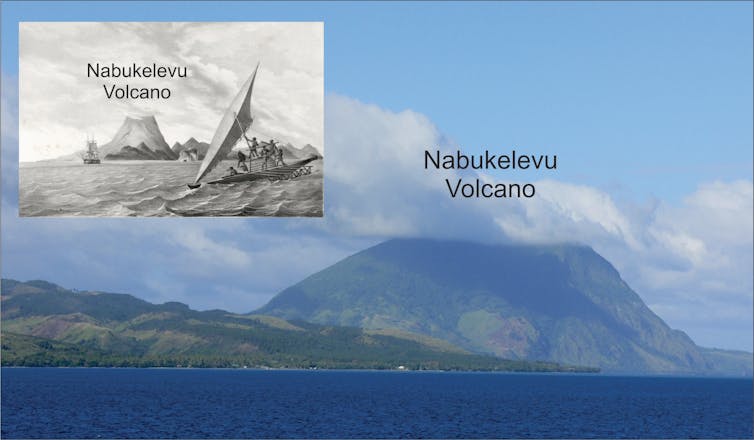
So dramatic, so life-changing were the events associated with this eruption, the people who witnessed it told stories about it. These stories have endured more than two millennia, faithfully passed on across roughly 100 generations to reach us today.
Scientists used to dismiss such stories as fictions, devalue them with labels like “myth” or “legend”. But the situation is changing.
Today, we are starting to recognise that many such “stories” are authentic memories of human pasts, encoded in oral traditions in ways that represent the worldviews of people from long ago.
In other words, these stories served the same purpose as scientific accounts, and the people who told them were trying to understand the natural world, much like scientists do today.
Battle Of The Vu
The most common story about the 2,500-year-old eruption of Nabukelevu is one involving a “god” (vu in Fijian) named Tanovo from the island of Ono, about 56km from the volcano.
Tanovo’s view of the sunset became blocked one day by this huge mountain. Our research identifies this as a volcanic dome that was created during the eruption, raising the height of the mountain several hundred feet.
Enraged, Tanovo flew to Nabukelevu and started to tear down the mountain, a process described by local residents as driva qele (stealing earth). This explains why even today the summit of Nabukelevu has a crater.
But Tanovo was interrupted by the “god” of Nabukelevu, named Tautaumolau. The pair started fighting. A chase ensued through the sky and, as the two twisted and turned, the earth being carried by Tanovo started falling to the ground, where it is said to have “created” islands.
We conclude that the sequence in which these islands are said to have been created is likely to represent the movement of the ash plume from the eruption, as shown on the map below.
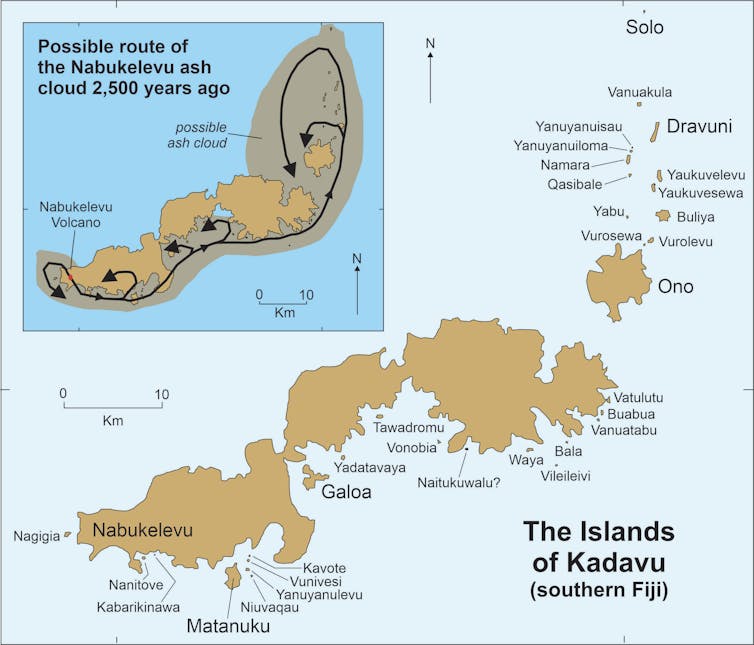
‘Myths’ Based In Fact
Geologists would today find it exceedingly difficult to deduce such details of an ancient eruption. But here, in the oral traditions of Kadavu people, this information is readily available.
Another detail we would never know if we did not have the oral traditions is about the tsunami the eruption caused.
In some versions of the story, one of the “gods” is so frightened, he hides beneath the sea. But his rival comes along and drinks up all the water at that place, a detail our research interprets as a memory of the ocean withdrawing prior to tsunami impact.
Other details in the oral traditions recall how one god threw a massive spear at his rival but missed, leaving behind a huge hole in a rock. This is a good example of how landforms likely predating the eruption can be retrofitted to a narrative.
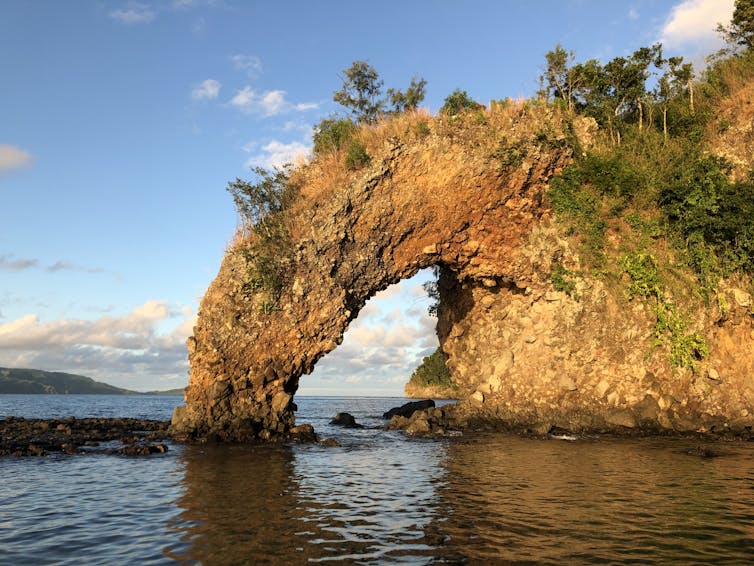
Our study adds to the growing body of scientific research into “myths” and “legends”, showing that many have a basis in fact, and the details they contain add depth and breadth to our understanding of human pasts.
The Kadavu volcano stories discussed here also show ancient societies were no less risk aware and risk averse than ours are today. The imperative was to survive, greatly aided by keeping alive memories of all the hazards that existed in a particular place.
Australian First Peoples’ cultures are replete with similar stories.
Literate people, those who read and write, tend to be impressed by the extraordinary time depth of oral traditions, like those about the 2,500-year old eruption of Nabukelevu. But not everyone is.
In early 2019, I was sitting and chatting to Ratu Petero Uluinaceva in Waisomo Village, after he had finished relating the Ono people’s story of the eruption. I told him this particular story recalled events which occurred more than two millennia ago – and thought he might be impressed. But he wasn’t.
“We know our stories are that old, that they recall our ancient history,” he told me with a grin. “But we are glad you have now learned this too!”
Acknowledgements: The original research was conducted in collaboration with Loredana Lancini and Rita Compatangelo-Soussignan (University of Le Mans), Meli Nanuku and Kaliopate Tavola (Fiji Museum), Taniela Bolea (University of the Sunshine Coast) and Paul Geraghty (University of the South Pacific).![]()
Patrick D. Nunn, Professor of Geography, School of Law and Society, University of the Sunshine Coast
This article is republished from The Conversation under a Creative Commons license. Read the original article.
Arithmetic has a biological origin – it’s an expression in symbols of the ‘deep structure’ of our perception
Randolph Grace, University of CanterburyEveryone knows that arithmetic is true: 2 + 2 = 4.
But surprisingly, we don’t know why it’s true.
By stepping outside the box of our usual way of thinking about numbers, my colleagues and I have recently shown that arithmetic has biological roots and is a natural consequence of how perception of the world around us is organised.
Our results explain why arithmetic is true and suggest that mathematics is a realisation in symbols of the fundamental nature and creativity of the mind.
Thus, the miraculous correspondence between mathematics and physical reality that has been a source of wonder from the ancient Greeks to the present — as explored in astrophysicist Mario Livio’s book Is God a mathematician? — suggests the mind and world are part of a common unity.
Why Is Arithmetic Universally True?
Humans have been making symbols for numbers for more than 5,500 years. More than 100 distinct notation systems are known to have been used by different civilisations, including Babylonian, Egyptian, Etruscan, Mayan and Khmer.

The remarkable fact is that despite the great diversity of symbols and cultures, all are based on addition and multiplication. For example, in our familiar Hindu-Arabic numerals: 1,434 = (1 x 1000) + (4 x 100) + (3 x 10) + (4 x 1).
Why have humans invented the same arithmetic, over and over again? Could arithmetic be a universal truth waiting to be discovered?
To unravel the mystery, we need to ask why addition and multiplication are its fundamental operations. We recently posed this question and found that no satisfactory answer – one that met standards of scientific rigour – was available from philosophy, mathematics or the cognitive sciences.
The fact that we don’t know why arithmetic is true is a critical gap in our knowledge. Arithmetic is the foundation for higher mathematics, which is indispensable for science.
Consider a thought experiment. Physicists in the future have achieved the goal of a “theory of everything” or “God equation”. Even if such a theory could correctly predict all physical phenomena in the universe, it would not be able to explain where arithmetic itself comes from or why it is universally true.
Answering these questions is necessary for us to fully understand the role of mathematics in science.
Bees Provide A Clue
We proposed a new approach based on the assumption that arithmetic has a biological origin.
Many non-human species, including insects, show an ability for spatial navigation which seems to require the equivalent of algebraic computation. For example, bees can take a meandering journey to find nectar but then return by the most direct route, as if they can calculate the direction and distance home.
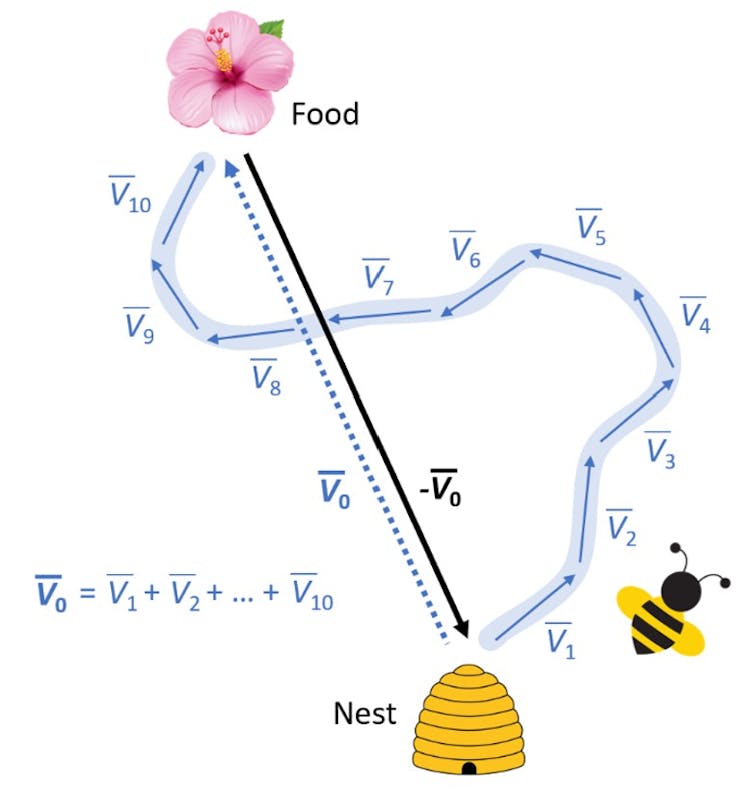
How their miniature brain (about 960,000 neurons) achieves this is unknown. These calculations might be the non-symbolic precursors of addition and multiplication, honed by natural selection as the optimal solution for navigation.
Arithmetic may be based on biology and special in some way because of evolution’s fine-tuning.
Stepping Outside The Box
To probe more deeply into arithmetic, we need to go beyond our habitual, concrete understanding and think in more general and abstract terms. Arithmetic consists of a set of elements and operations that combine two elements to give another element.
In the universe of possibilities, why are the elements represented as numbers and the operations as addition and multiplication? This is a meta-mathematical question – a question about mathematics itself that can be addressed using mathematical methods.
In our research, we proved that four assumptions – monotonicity, convexity, continuity and isomorphism – were sufficient to uniquely identify arithmetic (addition and multiplication over the real numbers) from the universe of possibilities.
Monotonicity is the intuition of “order preserving” and helps us keep track of our place in the world, so that when we approach an object it looms larger but smaller when we move away.
Convexity is grounded in intuitions of “betweenness”. For example, the four corners of a football pitch define the playing field even without boundary lines connecting them.
Continuity describes the smoothness with which objects seem to move in space and time.
Isomorphism is the idea of sameness or analogy. It’s what allows us to recognise that a cat is more similar to a dog than to a rock.
Thus, arithmetic is special because it is a consequence of these purely qualitative conditions. We argue that these conditions are principles of perceptual organisation that shape how we and other animals experience the world – a kind of “deep structure” in perception with roots in evolutionary history.
In our proof, they act as constraints to eliminate all possibilities except arithmetic – a bit like how a sculptor’s work reveals a statue hidden in a block of stone.
What Is Mathematics?
Taken together, these four principles structure our perception of the world so that our experience is ordered and cognitively manageable. They are like coloured spectacles that shape and constrain our experience in particular ways.
When we peer through these spectacles at the abstract universe of possibilities, we “see” numbers and arithmetic.
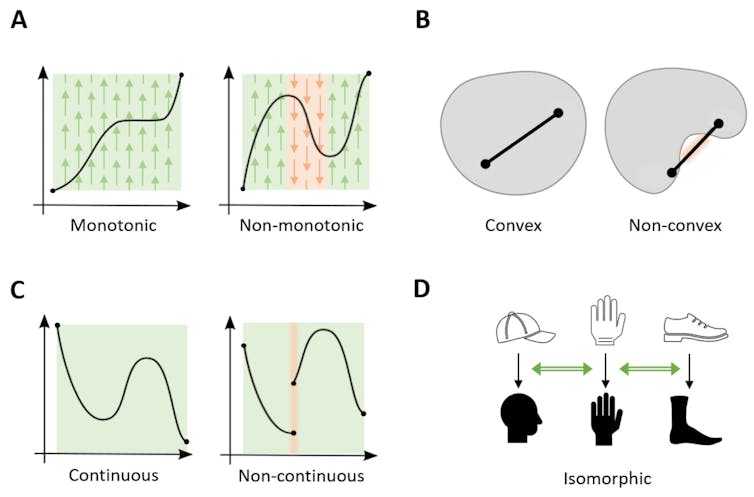
Thus, our results show that arithmetic is biologically-based and a natural consequence of how our perception is structured.
Although this structure is shared with other animals, only humans have invented mathematics. It is humanity’s most intimate creation, a realisation in symbols of the fundamental nature and creativity of the mind.
In this sense, mathematics is both invented (uniquely human) and discovered (biologically-based). The seemingly miraculous success of mathematics in the physical sciences hints that our mind and the world are not separate, but part of a common unity.
The arc of mathematics and science points toward non-dualism, a philosophical concept that describes how the mind and the universe as a whole are connected, and that any sense of separation is an illusion. This is consistent with many spiritual traditions (Taoism, Buddhism) and Indigenous knowledge systems such as mātauranga Māori.![]()
Randolph Grace, Professor of Psychology, University of Canterbury
This article is republished from The Conversation under a Creative Commons license. Read the original article.
Can human moderators ever really rein in harmful online content? New research says yes

Social media platforms have become the “digital town squares” of our time, enabling communication and the exchange of ideas on a global scale. However, the unregulated nature of these platforms has allowed the proliferation of harmful content such as misinformation, disinformation and hate speech.
Regulating the online world has proven difficult, but one promising avenue is suggested by the European Union’s Digital Services Act, passed in November 2022. This legislation mandates “trusted flaggers” to identify certain kinds of problematic content to platforms, who must then remove it within 24 hours.
Will it work, given the fast pace and complex viral dynamics of social media environments? To find out, we modelled the effect of the new rule, in research published in the Proceedings of the National Academy of Sciences.
Our results show this approach can indeed reduce the spread of harmful content. We also suggest some insights into how the rules can be implemented in the most effective way.
Understanding The Spread Of Harmful Content
We used a mathematical model of information spread to analyse how harmful content is disseminated through social networks.
In the model, each harmful post is treated as a “self-exciting point process”. This means it draws more people into the discussion over time and generates further harmful posts, similar to a word-of-mouth process.
The intensity of a post’s self-propagation decreases over time. However, if left unchecked, its “offspring” can generate more offspring, leading to exponential growth.

The Potential For Harm Reduction
In our study, we used two key measures to assess the effectiveness of the kind of moderation set out in the Digital Services Act: potential harm and content half-life.
A post’s potential harm represents the number of harmful offspring it generates. Content half-life denotes the amount of time required for half of all the post’s offspring to be generated.
We found moderation by the rules of the Digital Services Act can effectively reduce harm, even on platforms with short content half-lives, such as X (formerly known as Twitter). While faster moderation is always more effective, we found that moderating even after 24 hours could still reduce the number of harmful offspring by up to 50%.
The Role Of Reaction Time And Harm Reduction
The reaction time required for effective content moderation increases with both the content half-life and potential harm. To put it another way, for content that is longer-lived and generates large numbers of harmful offspring, intervening later can still prevent many harmful subsequent posts.
This suggests the approach of the Digital Services Act can effectively combat harmful content, even on fast-paced platforms like X.
We also found the amount of harm reduction increases for content with greater potential harm. While apparently counterintuitive, this indicates moderation is effective when it targets the offspring of offspring generation – that is, when it breaks the word-of-mouth cycle.
Making The Most Of Moderation Efforts
Prior research has shown tools based on artificial intelligence struggle to detect online harmful content. The authors of such content are aware of the detection tools, and adapt their language to avoid detection.
The Digital Services Act moderation approach relies on manual tagging of posts by “trusted flaggers”, who will have limited time and resources.
To make the most of their efforts, flaggers should focus their efforts on content with high potential harm for which our research shows that moderation is most effective. We estimate the potential harm of a post at its creation by extrapolating its expected number of offspring from previously observed discussions.
Implementing The Digital Services Act
Social media platforms already employ content moderation teams, and our research suggests the major platforms at least already have enough staff to enforce the Digital Services Act legislation. There are, however, questions about the cultural awareness of the existing staff as some of these teams are based in different countries to the majority of content posters they are moderating.
The success of the legislation will lie in appointing trusted flaggers with sufficient cultural and language knowledge, developing practical reporting tools for harmful content, and ensuring timely moderation.
Our study’s framework will provide policymakers with valuable guidance in drafting mechanisms for content moderation that prioritise efforts and reaction times effectively.
A Healthier And Safer Digital Public Square
As social media platforms continue to shape public discourse, addressing the challenges posed by harmful content is crucial. Our research on the effectiveness of moderating harmful online content offers valuable insights for policymakers.
By understanding the dynamics of content spread, optimising moderation efforts, and implementing regulations like the Digital Services Act, we can strive for a healthier and safer digital public square where harmful content is mitigated, and constructive dialogue thrives.![]()
Marian-Andrei Rizoiu, Senior Lecturer in Behavioral Data Science, University of Technology Sydney and Philipp Schneider, Doctoral Student, EPFL – École Polytechnique Fédérale de Lausanne – Swiss Federal Institute of Technology in Lausanne
This article is republished from The Conversation under a Creative Commons license. Read the original article.
Friday essay: what do publishers’ revisions and content warnings say about the moral purpose of literature?

This year, there has been some controversy about the rewriting of passages from authors such as Roald Dahl, Enid Blyton, Ian Fleming and Agatha Christie with the aim of removing potentially offensive material. Some publishers have also adopted the precautionary measure of adding content warnings and disclaimers to books by Ernest Hemingway, Virginia Woolf, Raymond Chandler and P.G. Wodehouse.
Critics of these bowdlerisations and disclaimers have come from across the political spectrum and seem to vastly outnumber those defending the practice. It is some time since I have noticed a literary topic come up as frequently as this one in conversation with those outside the literary culture. And while, as an academic, it is heartening to see people worked up about books and their value, it is disheartening to see books recruited as culture-war fodder.

Conservative publications have tended to frame these developments as evidence of “wokeness” (a word, in this context, vacant of meaning). Others have offered more nuanced, less loaded critiques, arguing that such measures fail to account for our obligation to attend to and preserve history, rather than ignore or erase it. In the case of children’s books, the argument has been made for the role of adults as responsible literary guides.
Much has been said on the issue of rewriting writers that I don’t want to relitigate, but it is worth examining the nature of the debate itself and the fact of its prominence. In an era when literature sits on the cultural margins, why does a story like this break through to the mainstream? What are the stakes that have conjured so much talk?
Moral Questions
A literary story is taken up by the media most enthusiastically, it seems, when it can be connected to moral concerns. Those who would clean up the classics, and their conservative opponents, are entangled in a moral battle which encourages the application of the same ethical criteria to books that might be apply to elected officials or ministers of religion.

Skimming any contemporary writers’ festival program will demonstrate that we struggle to talk about books on any other terms. Yet if book-talk most easily rises to the level of public discussion when it involves a simple moral controversy, then we are inexorably incorporating literature into the sepia mass of monetised cultural gruel of which our society appears increasingly to comprise.
Two questions motivate this latest argument. The first entails uncertainty about what constitutes literary censorship. Is rewriting a sentence to expurgate an offensive term a form of vandalism, or is it no different from (or at least comparable to), say, translation?
The second is a much debated and oft-reformulated inquiry, familiar within and without literary studies: is there a necessary connection between a work’s literary value and its moral quality? When we read a book do we expect a degree of moral instruction, as to how we should or should not live?
These are worthwhile questions, but they are not the only ones. Literature is extraordinary, in part, because it cannot be reduced to such questions.
Moral debates arise easily because they tend to encourage definitive judgements, which are both gratifying and compatible with an increasingly commodified world. In particular, a moral judgement has the power to bestow a final endorsement or condemnation, meaning one can avoid what Keats described as negative capability: “being in uncertainties, mysteries, doubts, without any irritable reaching after fact and reason”.
A capacity to cope with the unpleasantness of irresolution could be taken as a mark of maturity. The desire for certainty, for a world of unambiguously demarcated ethical boundaries of the kind found in much young adult fiction, could be described as a reassuring childish fantasy.
There might be good reasons for removing offensive language from a text, but we should be suspicious of the impulse to polish literature for modern sensibilities, to make writing newly palatable and inoffensive. To treat books as objects that can be modified to suit the mood of the times is to risk ushering them into the category of pure commodity, optimised according to market desires.

The urge to keep Dahl agreeable, for example, is a consequence of a corporation desiring to profit from Roald Dahl the brand. Children’s author Philip Pullman suggested that, rather than revising Dahl, it would be preferable to let him go out of print. This is inconceivable. Dahl’s estate is simply worth too much.
It is in the interest of the Roald Dahl Story Company, purchased by Netflix in 2021, to make Dahl as widely acceptable as possible. Thus the effort to sand off his edges. Brands must be slick, inoffensive, inhuman.
No sensible person would defend Dahl’s character. He was a professed antisemite. In the 1970s, he was forced by the advocacy of the civil rights organisation NAACP to change Charlie and the Chocolate Factory’s Oompa Loompas, who were originally depicted as pygmies brought from Africa to work in the chocolate factory unpaid.
These facts may repulse you to such an extent you can never read Dahl again – or perhaps you might prefer to evaluate his books on their own terms, detaching them from the author’s beliefs. Either response is possible and understandable. But the texts cannot be entirely revalued or made morally sound by meddling with a few sentences or replacing them with clunky alternatives.

Literature has always been influenced by the marketplace. Historically, it has evolved through systems of patronage and copyright, gatekeeping publishers and nepotistic periodicals. But to reduce an author to a brand is to obliterate what makes literature a meaningful category. Art distinguishes itself from commerce by pushing back against these capitalist formations and, consequently, being incompatible with reductive moralism.
This is obvious when we consider how we treat books differently to other purchasable items. If you buy a vacuum cleaner that fails to suck dust from your carpet, you should be able to return it. This is because vacuum cleaners are meant to perform a clearly identifiable, unambiguous function.
If you purchase a book that does not work as expected, it would be perverse to attempt to return it to the bookshop and say:
I found the prose too dense; the characters were meaner than I wanted them to be; I thought I was reading a detective story, but halfway through it became a revenge tragedy.
The nourishment offered by reading depends, in fact, on our not knowing how the experience of a book will unfold until we are reading it. The value is revealed in the act of reading. Even when rereading, we find pleasure in noticing patterns or aspects of a work that did not come into view during the previous encounter. We never quite know what we are in for.
The best literature can be spiky, ambiguous, difficult, cruel, strange, unpredictable, hectoring and unpleasant. It is not the job of a book to ease the life of its reader. Reading a good book might mean having a terrible day, a day in which you are scared, sad, distressed.
It is rare (if not unheard of) that we pay to undergo unpleasant experiences that teach us nothing. But literature does not have an obligation to be useful; we do not have to learn anything from it. It need not produce anything except a readerly response. The alternative is that we are paying to be numbed.
A Reasonable Reaction?
What, then, is a reasonable reaction to a book that offends? And by what mechanisms are thresholds of offence and moral transgression established?
There are social norms arrived at more or less by consensus which few would dispute. There are certainly examples of books that necessitate judicious editing if they are to continue being published. To return to the original title of Agatha Christie’s And Then There Were None, for example, would make the book unsellable. (Conversely, it could be argued that concealing the author’s choice so as to prolong a book’s life unfairly deceives readers.)

In most circumstances, there is nothing wrong with trying to avoid offence. When teaching a text that students may find difficult, I am happy to provide a content warning. It is not obvious to me that forcing a student to encounter shocking material, perhaps material they find personally painful, is necessarily edifying or educational.
In fact, any social interaction requires us to calculate what it is permissible to say, and there are many remarks we refrain from making for fear they might hurt. In the case of this current controversy, however, attention must be paid to how and why the decisions about what constitutes unacceptable material are being made.
In an ordinary setting, a reader who finds a book disagreeable can put that book down, or not pick it up in the first place. An author might also consider such consequences when writing a book.
But if the moral authority to make these decisions on behalf of an audience is sourced from the imperative to keep a property such as James Bond or Willy Wonka marketable, the literature is degraded. While it may be in the interest of art to leave its audience in distress, it will never be in the interest of capital to upset a potential consumer.
To defend literature entirely on moral grounds is to cede important territory. Of course, literature can make you a better person; it can also make you a worse one. It is most likely to do neither. Of course, a reader can find a book morally offensive or morally instructive, but that might be only one thread in a complex array of responses.
Any argument that treats literature as fundamentally therapeutic, self-improving or society-improving, risks reducing literature to self-help – a genre that promises to improve its reader’s character. To approach literature as a machine for self-improvement is to share ground with the bad-faith arguments of those who justify their bigoted moralising by referring to the cultural achievements of Western civilisation.
The shared perspective is that the value of books depends on the readers they produce. To read broadly and deeply is a marvellous thing that can make us alert to the wide-ranging varieties of being. But no book will condemn or redeem us. This is because books do not exist without readers, and each reader is an unpredictable variable. While it is appealing to believe that a person’s aesthetic judgement is a reliable indication of their moral character, these traits are only tenuously connected.
So, if not on moral terms, how might we defend literature? We can liken it to conversation. A conversation can be morally nourishing or deadening. It is neither good nor bad. Conversations are surely responsible for some of history’s worst atrocities, along with its most wondrous achievements. And clearly we cannot stop having conversations, whether we wish to or not.
In this and other ways, reading resembles conversation. It is an ongoing exchange between reader and writer, one that will continue to change with the times, enlivening us for its own sake.![]()
Dan Dixon, Adjunct Lecturer, University of Sydney
This article is republished from The Conversation under a Creative Commons license. Read the original article.
How Joaquín Sorolla’s paintings shed light on social realities

Joaquín Sorolla (1863-1923) is one of the great masters of painting. He has gone down in history for the way he captured the light in his paintings and depicting the differences between Mediterranean and Cantabrian luminosity in moments of everyday life.
There has been much debate as to whether or not he belonged to the impressionist tendency, from which he always wanted to distance himself in order to create his own personal pictorial language. His chromatic richness and luminosity have often blurred his beginnings, when he was trying to make his way at the San Carlos School of Fine Arts in his native Valencia, where he entered in 1878.
And we forget that in his first steps he was a great renovator in his approach to social realism, the prevailing trend at the end of the 19th century.
Eighteenth-century academia was interested, in art, in themes created around heroes. A century later, these gave way to anonymous men and women living simple lives, depicted with great nobility and drama.
Sorolla was not left out of this trend. It was also relevant that these themes gradually became more widely accepted in official competitions, which the painter entered in search of an endorsement at the beginning of his career.
The culmination of these events came in 1895, when Sorolla won the first medal at the Spanish National Exhibition with And They Still Say Fish is Expensive!. Sorolla was convinced that “prizes do not make good painters”. But the fact is that he wrote a letter to his wife Clotilde on 15 June 1895 to inform her that he had won the coveted prize with this work.
The Hardness Of The Sea

Using a palette of earthy colours, the painter places before our eyes the hard life of the fishermen. The idyllic sea to which we are accustomed in his paintings gives way to social realism.
He was probably inspired by the literature of his friend Vicente Blasco Ibañez, who in his novel Flor de Mayo (1895) had recounted the accident of a group of sailors at sea and the death of the youngest, Pascualet, on the Valencian beach of Cabañal.
Sorolla’s brushstrokes also capture with profound humanity the helplessness of two experienced sailors before the figure of the injured young man. This is a theme that explains the expressive intensity of the faces, weathered by the sun, and the gestures of the hands worn by work. Sorolla, with a unique pictorial language, conveys the drama of the moment, exalting the simplicity of the anonymous fishermen. The vibration of his brushstrokes generates a veracity capable of competing with late 19th-century photography.
Before tackling the considerable dimensions of this painting (151.5 x 204 cm), Sorolla carried out two preparatory studies to study its scenography: Bodega de una embarcación. Valencia and Interior of a boat.
These works, painted on canvas and cardboard, recreate the interior of boats with their motifs almost in the manner of still-lifes, with a notable differentiation of textures: the roughness of the rope, the wood of the barrel and the shine of the fish scales, strongly illuminated by the light that enters through the boat’s hatch.
Seafaring Psychology
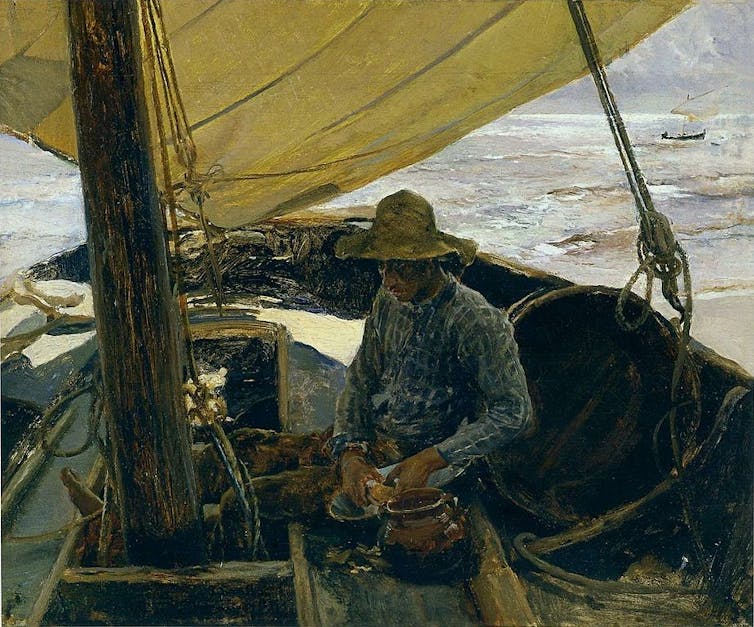
The unity, technical mastery and psychological capture of his characters can be seen in other lesser-known paintings from Sorolla’s early period. In Peeling Potatoes (1891) a solitary fisherman prepares his daily sustenance. And in The Blessing of the Boat on Cabañal Beach (1895), the gaze of a young fisherman invites us to take part in the solemn ceremony.
The sober chromatic palette that colours the clothes in the foreground contrasts with the luminosity of the Mediterranean, where a barely sketched sailboat contrasts the harshness of the fishermen’s work with the joyful image of the sea in leisure time, a perception that would dominate in Sorolla’s later images.
Religious overtones also play a leading role in social realism in The Happy Day (1892). Here, with a gesture of great tenderness, a girl who has received her first communion goes to a fishermen’s hut to receive her blind and sick grandfather’s blessing.
In this case, too, Sorolla prepared his composition with preliminary drawings and sketches to submit it to the National Exhibition of 1892, declaring it to be one of his favourite works. It includes a view of the Mediterranean through the open door of the room. The artist uses the light shed inside the hut to make a study of chiaroscuro in the definition of the space.
Inequalities On Land

The denunciation of social inequalities in this early period of Sorolla’s work goes beyond the maritime sphere. The harsh reality is also present in Another Marguerite! (1892), in which a woman travels from Valencia to Madrid handcuffed and guarded by the Benemérita for having killed her son.
Sorolla was inspired by an image he himself saw on a train journey to evoke the Marguerite of one of the best dramas of the 19th century: Goethe’s Fausto. In it, Marguerite, mad with love for the protagonist, is imprisoned for killing the illegitimate child she has with him.
A poor carriage is repeated as the spatial setting for White Slave Trade (1894), with four young prostitutes accompanied by their procuress, with a look of deep concern on her face.

In these works Sorolla shows himself as a painter of the human being in his essence, and this provokes the special emotion of the spectator, which led to the recognition he enjoyed during his lifetime, becoming a point of reference in the Spanish culture of his time.
This admiration endures to this day, as the exhibitions held on the occasion of his centenary. Sorolla, in his tireless and versatile productivity, is the painter of light and colour, of the innocence of children, the beach, the family, pain, illness…. And he is also the painter of social realism, capturing with his brushes the precariousness of life to the point of “glorifying the pain of living of the most humble”.![]()
María Rodríguez Velasco, Profesora de Historia del Arte, Universidad CEU San Pablo
This article is republished from The Conversation under a Creative Commons license. Read the original article.
Discrimination, internment camps, then deportation: the end of the second world war did not mean peace for Japanese-Australians
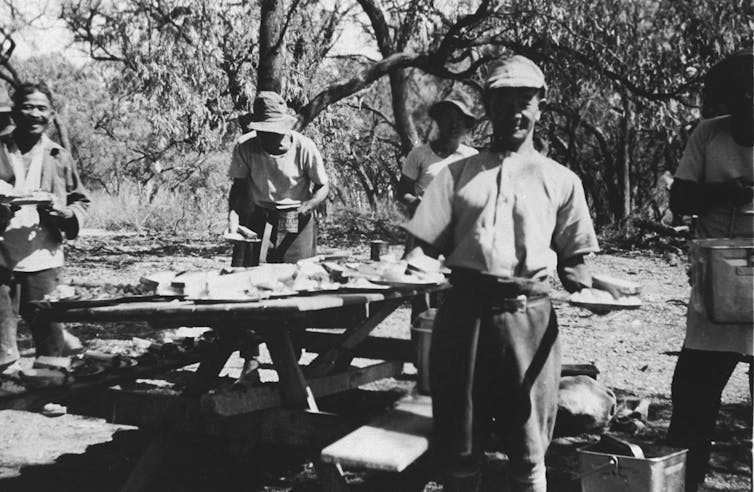
For most of the world’s population, the end of the second world war was a glorious day. This was not necessarily the case for Japanese-Australians, who faced repatriation to Japan after being interned by their home country, Australia.
Shortly after Japan entered the war in December 1941, 1,141 Japanese people living in Australia were seized and transferred to “enemy” camps – accounting for 98% of the total Japanese population in Australia. This was much higher than the proportion of Italians and Germans sent to Australian internment camps.
At the camps, such as those located in Loveday in South Australia, Tatura in Victoria and Hay and Cowra in New South Wales, Japanese internees were treated by Australian guards according to the Geneva Convention. But there was little contemporary Australian press coverage of these camps, and many Australians did not know about them – even if they lived locally.
In my newly published research, I have been exploring the forgotten experiences of Japanese-Australians during the second world war.
The Cowra Breakout

One of the only pieces of contemporary news reporting on the internment of Japanese people followed the Cowra breakout in August 1944, when captured prisoners of war tried to escape. Four Australians and 231 Japanese soldiers were killed.
Even after the war, most of the media coverage focused on these POWs rather than the interred Australian residents.
Japanese POWs followed the Senjinkun military code, by which “a soldier was expected not to survive to suffer the dishonour of capture”.
This was encouraged by cultural critiques, artists and poets, exemplified by a surviving poem by Sonosuke Sato. Japanese soldiers were brainwashed to believe the chance to die was an honour.

Common to Australian media publications on this breakout is a tendency to treat the Japanese as “others”. A clear distinction exists between “us” and “them”. It was difficult for Australians to understand the motives of the fatal military decision to escape the camp where they had been treated humanely.
In contrast, media reports did not mention the experiences of the civilian Japanese living in Australia and therefore free from the Japanese military mindset.
Japanese-Australians
In pre-war Australia, many Japanese-Australians were working as pearl divers. There were also a hundred or so Japanese elites working for banks and trading companies in Sydney and Melbourne.
Many Japanese had departed Australia in the 1930s when an unofficial trade war erupted between Australia and Japan. More left as the threat of war grew and Japanese residents faced increasing discrimination and fewer business opportunities.

Not every Australian with a Japanese background associated themselves with the community, or identified strongly with their heritage. But when Japan joined the war, Australia captured the “Japanese”, even those who had lived in the country for decades or were born in Australia.
They were joined in camps by Japanese people shipped from nearby allied territories such as New Zealand, the Pacific and Indonesia.
One of them was Cairns-born Samuel Nakashiba, raised as an Australian without Japanese language fluency. Nevertheless, he was captured and imprisoned as “Japanese”.
Nakashiba lodged his first application for release in June 1942. He was not released until May 1945, when the relevant authority found a job for him in an isolated place in Queensland.

Yet Nakashiba was still lucky. He was one of only around 200 Japanese permitted to remain in Australia after the war. The rest were deported to Japan, even those with no or few ties to the country.
Repatriation To Japan
Hikotaro Wada, a laundryman, was arrested in Kalgoorlie in December 1941.
Arriving in Australia in 1891 when he was 21, he briefly visited Japan in the 1920s, when he discovered he had no family left there and immediately came back.
He applied for release during the war but was unsuccessful. He was sent back to Japan in 1946 after having lived in Australia for 50 years. His fate after repatriation is unknown.
Shigeru Yamaguchi, born in Broome, was listed as “Australian-born Japanese” in the official camp record. He stayed in the camp until the end of war and was then repatriated to Japan.
Prior to his arrest in January 1942, Yamaguchi had made a life as the owner of a vegetable garden in Geraldton, Western Australia. After the war, a major at Loveday camp “advised” him to leave for Japan, believing his prospects would be better there.
In 1947, while serving as an interpreter for the Allied Forces in Tokyo, Yamaguchi requested a re-entry permit to Australia. He was not granted permission to return. His fate after 1947 is also unknown.
In the 1950s, some Japanese divers who had worked in pre-war Broome returned to Australia. As a farmer, Yamaguchi was unlikely to have been in this party. My research on Yamaguchi ended here; Japan has highly restrictive privacy laws that block access to official individual records by anyone other than direct offspring.
The American Redress Movement
During the United States’ involvement in the war, 112,000 “Japanese” were placed in internment camps. Some chose to move to Japan after the ill treatment by the US government.
Japanese-Americans began the redress movement in the 1960s. President Ronald Reagan signed an act to grant reparations for the internment of Japanese-Americans in 1988. In 1991, President George Bush senior stated: “The internment of Americans of Japanese ancestry was a great injustice, and it will never be repeated.”

By contrast, in Australia no apology has been made to the “Japanese” people who were captured or repatriated, even when Australia was their home.
In the same way stories of diggers and soldiers are Australian stories, experiences of the Japanese-Australians who were unfairly labelled as enemy aliens at our own internment camps should also be regarded as Australian stories.
Have we listened to their stories? And can we say sorry?![]()
Tets Kimura, Adjunct Lecturer, Creative Arts, Flinders University
This article is republished from The Conversation under a Creative Commons license. Read the original article.
Vale Mary-Louise McLaws: Researcher And Global Advocate In Infectious Diseases And Public Health
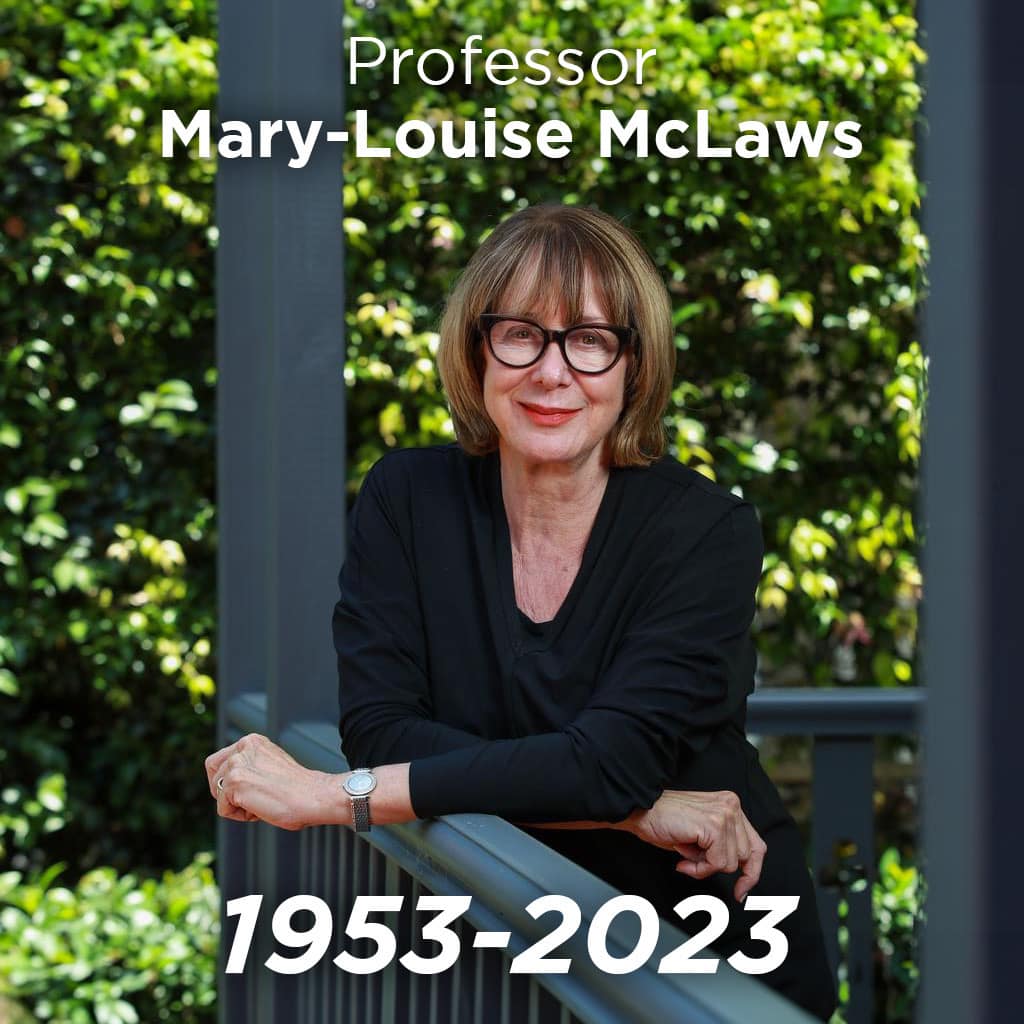
9 signs you have inflammation in your body. Could an anti-inflammatory diet help?

There is a lot of health buzz around the term “inflammation” right now. From new scientific discoveries to celebrities and social media influencers, it seems like everyone is talking about this important bodily process and its potential impact on our health.
“Inflammaging” is a specific term you may also have seen. It’s an age-related increase in persistent, low-grade inflammation in blood and tissue, which is a strong risk factor for many conditions and diseases.
So, can an anti-inflammatory diet help reduce inflammation? Let’s take a look.
What Is Inflammation?
When our body becomes injured or encounters an infection, it activates defence mechanisms to protect itself. It does this by instructing our cells to fight off the invader. This fighting process causes inflammation, which often presents as swelling, redness and pain.
In the short-term, inflammation is a sign your body is healing, whether from a grazed knee or a cold.
If inflammation persists for a longer time it’s called “chronic”. That can indicate a health problem such as arthritis, heart disease, diabetes, dementia or other autoimmune disorders.
The signs and symptoms of chronic inflammation may be present from several months to years and include:
- persistent pain
- chronic fatigue or insomnia
- joint stiffness
- skin problems
- elevated blood markers (such as C-reactive protein)
- gastrointestinal issues (constipation, diarrhoea, acid reflux)
- depression, anxiety and mood disorders
- unintended weight gain or loss
- frequent colds or flu.
What Role Does Diet Play?
The relationship between food and inflammation is well recognised. Overall, some food components may activate the immune system by producing pro-inflammatory cytokines (small proteins important in cell signaling) or reducing the production of anti-inflammatory cytokines.
A “pro-inflammatory diet” may increase inflammation in the body over the long term. Such diets are usually low in fresh produce like fruits, vegetables and wholegrains, and high in commercially baked goods, fried foods, added sugars and red and processed meats.
In contrast, an “anti-inflammatory” diet is associated with less inflammation in the body. There is no single anti-inflammatory diet. Two well-recognised, evidence-backed examples are the Mediterranean diet and the Dietary Approaches to Stop Hypertension (DASH) diet.
Anti-inflammatory diets typically include the following elements:
1. high in antioxidants. These compounds help the body fight free radicals or unstable atoms, that in high quantities are linked to illnesses such as cancer and heart disease. The best way to consume antioxidants is by eating lots of fruits and vegetables. Research shows frozen, dried and canned fruits and vegetables can be just as good as fresh
2. high in “healthy”, unsaturated fatty acids. Monounsaturated fats and omega-3-fatty acids are found in fish (sardines, mackerel, salmon and tuna), seeds, nuts, and plant-based oils (olive oil and flaxseed oil)
3. high in fibre and prebiotics. Carrots, cauliflower, broccoli and leafy greens are good sources of fibre. Prebiotics promote the growth of beneficial microorganisms in our intestines and can come from onions, leeks, asparagus, garlic, bananas, lentils and legumes
4. low in processed foods. These contain refined carbohydrates (pastries, pies, sugar-sweetened beverages, deep-fried foods and processed meats).

Rheumatoid Arthritis, Dementia, Depression
There is mixed evidence for the role of anti-inflammatory diets in rheumatoid arthritis pain management. A recent 2021 systematic review (where researchers carefully group and examine the available evidence on a topic) found eating an anti-inflammatory diet likely leads to significantly lower pain in people with rheumatoid arthritis when compared with other diets.
However, the 12 studies included in the review had a high risk of bias – likely because people knew they were eating healthy foods – so the confidence in the evidence was low.
Inflammation is strongly implicated in the development of neurodegenerative diseases like Alzheimer’s disease and related dementia and evidence suggests anti-inflammatory diets might help to protect the brain.
A 2016 review showed an anti-inflammatory diet may be protective against cognitive impairment and dementia, but that further large randomised controlled trials are needed. A 2021 study followed 1,059 people for three years and observed their diet. They reported those with a greater pro-inflammatory diet had an increased risk of developing dementia.
Inflammation has also been linked with mental health, with people eating a pro-inflammatory diet reporting more symptoms of depression. Diet is the fundamental element of lifestyle approaches to managing anxiety and mental health.
More broadly, a 2021 review paper examined recent research related to anti-inflammatory diets and their effect on reducing inflammation associated with ageing. It found compounds commonly found in anti-inflammatory diets could help alleviate the inflammatory process derived from diseases and unhealthy diets.
What About Turmeric?
A favourite on social media and vitamin shelves, turmeric is promoted as having anti-inflammatory benefits. These are linked to a specific compound called curcumin, which gives turmeric its distinctive yellow colour.

Research suggests curcumin might act as an anti-inflammatory agent in the body but high-quality clinical trials in humans are lacking. Most of the existing studies have been conducted in lab settings using cells or in animals. So it’s unclear how much curcumin is needed to see anti-inflammatory benefits or how well we absorb it.
Overall, adding turmeric to your food may provide your body with some health benefits, but don’t rely on it to prevent or treat disease on its own.
Safe Eating
Inflammation is a major factor in the link between diet and many health conditions.
Eating an anti-inflammatory diet is considered safe, likely to support health and to prevent future chronic conditions. If you are looking for tailored dietary advice or an anti-inflammatory meal plan, it’s best to speak with an accredited practising dietitian.![]()
Lauren Ball, Professor of Community Health and Wellbeing, The University of Queensland and Emily Burch, Dietitian, Researcher & Lecturer, Southern Cross University
This article is republished from The Conversation under a Creative Commons license. Read the original article.
Surf group found safe after days at sea in Indonesia. A sea survival expert on what it takes to survive being lost at sea
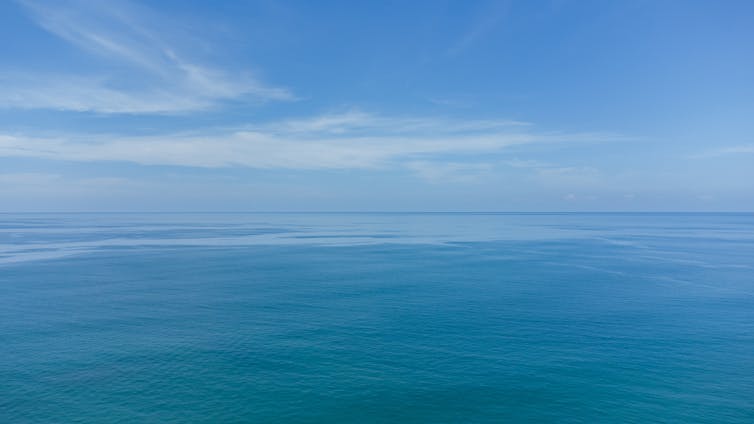
News that four Australians and two Indonesian crew members have been found alive after going missing on Sunday from a boat trip off the coast of Aceh in Indonesia has made headlines around the world.
The group, which was on a surfing trip, was found “bobbing around on their surfboards”, according to media reports quoting the father of one of the Australian surfers.
Our research in the Extreme Environments Laboratory at the University of Portsmouth focuses on how humans survive and respond to adverse environments.
So what does it take to survive such gruelling conditions?
A Hierarchy Of Survival
There is an established hierarchy of survival.
Without air you only survive for a matter of minutes. Without sufficient warmth you only survive hours. Without sufficient drinking water you can survive up to six or seven days in a maritime environment. Without food you can survive 40–60 days.
So, those who survive more than a few hours are almost always in warm air or water.
Because you can eventually cool even in water that is relatively warm, you are better off out of the water than in it. Being on top of a surfboard is a step in the right direction.
Dealing With Dehydration
When the water and air are warm, the primary problem is dehydration.
Death due to dehydration occurs when you lose about 15–20% of your body weight in fluid.
Even at 5% dehydration you can get headaches, become irritable and feel lightheaded. At 10% you may be dizzy, feel faint, have a rapid pulse and rapid shallow breathing. Thereafter, hallucinations and delirium are common.
To survive longer than six or seven days, when dehydration is your major threat, you must do two important things.
First, try to find fresh water. The absolute minimum you need to find is 110–220 millilitres a day, although 400mL per day is safer.
If you were prepared, you may have taken water with you as you embarked on your survival voyage.
If you are lucky, it might rain and you may be able to collect some rainwater in suitable, uncontaminated containers.
Surfers are unlikely to have devices such as a solar still or a reverse osmosis pump available to purify water for safe drinking. But other sources of useful fluids include fish “lymph” squeezed from the flesh of fish. This has about the same salt concentration as human body fluid (0.9%), so is only helpful if you are very dehydrated.
Fish eyes, spinal fluid and turtle blood can also help when desperate.
What you must not do, despite what becomes an overwhelming urge, is drink the seawater that surrounds you.
Seawater has an average salt concentration of 3.5%, so drinking it adds to the salt load of the body.
You should also not drink urine in this situation, because it will also contribute to salt building up in your body.
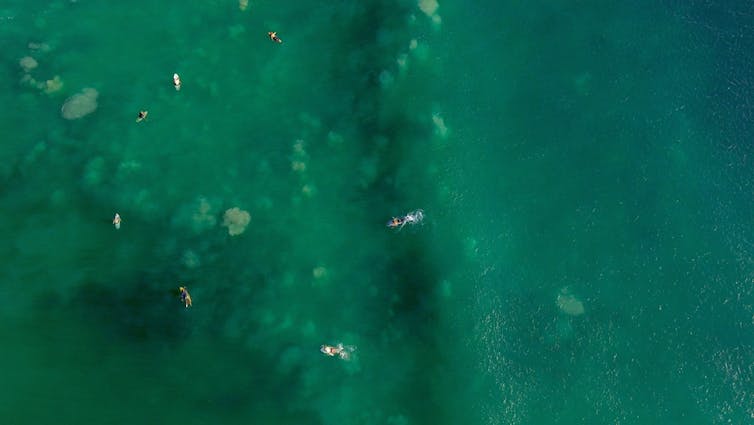
Conserving Fluids
The second important factor is to conserve body fluid.
The body of a 75kg person contains nearly 50 litres of water, and in a survival situation where dehydration is your greatest threat, conserving this water is crucial.
The body helps. With a body fluid loss of 1% of body weight and consequent decrease in blood volume and increase in salt concentration, the body increases the production of the anti-diuretic hormone that lowers urine production by the kidneys.
You can provoke this response by drinking nothing in the first 24 hours of a survival voyage.
At the same time, it is important to do as little as possible. Try to minimise heat production by the body, which will mean less sweating.
So “bobbing around” on a surfboard is better than paddling it and getting hot and sweaty.
Normally, you would seek or make shade on your survival craft and rest during the hottest parts of the day. This is not possible on a surfboard, but periodic wetting from waves may keep you cool and help reduce sunburn (which can impair your ability to control your body temperature) by cooling the skin and covering it periodically.
The longer-term challenge is starvation – but this is a less pressing problem than dehydration.
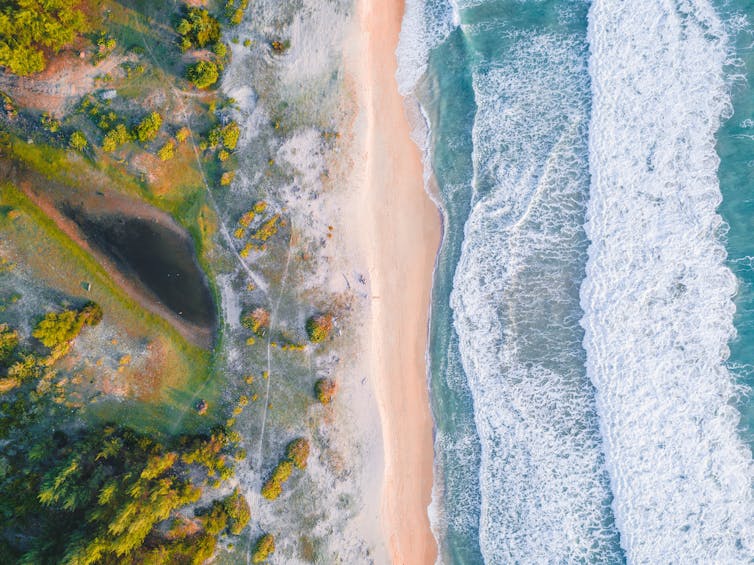
Staying Calm In A Crisis
Survival at sea depends on knowing how your body works and what it needs, and then doing the right things.
Experience helps. Being used to the sea means you remain more relaxed in a crisis and are less likely to become seasick (which can accelerate dehydration, impair body temperature regulation and destroy morale).
Being with others helps morale and decision-making. Young and fit people, such as many surfers, are less likely to have other health-related problems that may compromise their survival prospects. ![]()
Mike Tipton, Professor of Human and Applied Physiology, University of Portsmouth
This article is republished from The Conversation under a Creative Commons license. Read the original article.
1 in 6 women are diagnosed with gestational diabetes. But this diagnosis may not benefit them or their babies

When Sophie was pregnant with her first baby, she had an oral glucose tolerance blood test. A few days later, the hospital phoned telling her she had gestational diabetes.
Despite having only a slightly raised glucose (blood sugar) level, Sophie describes being diagnosed as affecting her pregnancy tremendously. She tested her blood glucose levels four times a day, kept food diaries and had extra appointments with doctors and dietitians.
She was advised to have an induction because of the risk of having a large baby. At 39 weeks her son was born, weighing a very average 3.5kg. But he was separated from Sophie for four hours so his glucose levels could be monitored.
Sophie is not alone. About one in six pregnant women in Australia are now diagnosed with gestational diabetes.
That was not always so. New criteria were developed in 2010 which dropped an initial screening test and lowered the diagnostic set-points. Gestational diabetes diagnoses have since more than doubled.
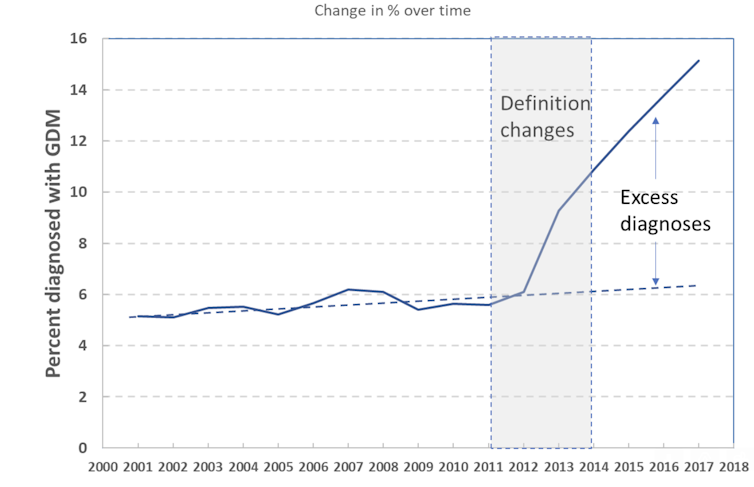
But recent studies cast doubt on the ways we diagnose and manage gestational diabetes, especially for women like Sophie with only mildly elevated glucose. Here’s what’s wrong with gestational diabetes screening.
The Glucose Test Is Unreliable
The test used to diagnose gestational diabetes – the oral glucose tolerance test – has poor reproducibility. This means subsequent tests may give a different result.
In a recent Australian trial of earlier testing in pregnancy, one-third of the women initially classified as having gestational diabetes (but neither told nor treated) did not have gestational diabetes when retested later in pregnancy. That is a problem.
Usually when a test has poor reproducibility – for example, blood pressure or cholesterol – we repeat the test to confirm before making a diagnosis.
Much of the increase in the incidence of gestational diabetes after the introduction of new diagnostic criteria was due to the switch from using two tests to only using a single test for diagnosis.

The Thresholds Are Too Low
Despite little evidence of benefit for either women or babies, the current Australian criteria diagnose women with only mildly abnormal results as having “gestational diabetes”.
Recent studies have shown this doesn’t benefit women and may cause harms. A New Zealand trial of more than 4,000 women randomly assigned women to be assessed based on the current Australian thresholds or to higher threshold levels (similar to the pre-2010 criteria).
The trial found no additional benefit from using the current low threshold levels, with overall no difference in the proportion of infants born large for gestational age.
However, the trial found several harms, including more neonatal hypoglycaemia (low blood sugar in newborns), induction of labour, use of diabetic medications including insulin injections, and use of health services.
The study authors also looked at the subgroup of women who were diagnosed with glucose levels between the higher and lower thresholds. In this subgroup, there was some reduction in large babies, and in shoulder problems at delivery.
But there was also an increase in small babies. This is of concern because being small for gestational age can also have consequences for babies, including long-term health consequences.
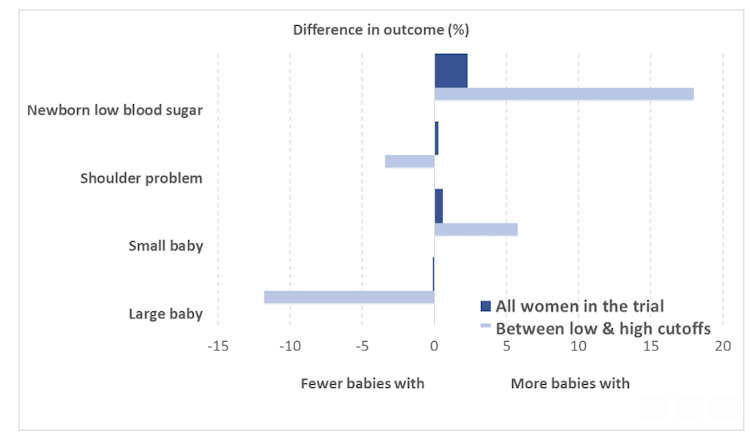
Testing Too Early
Some centres have begun testing women at higher risk of gestational diabetes earlier in the pregnancy (between 12 and 20 weeks).
However, a recent trial showed no clear benefit compared with testing at the usual 24–28 weeks: possibly fewer large babies, but again matched by more small babies.
There was a reduction in transient “respiratory distress” – needing extra oxygen for a few hours – but not in serious clinical events.
Impact On Women With Gestational Diabetes
For women diagnosed using the higher glucose thresholds, dietary advice, glucose monitoring and, where necessary, insulin therapy has been shown to reduce complications during delivery and the post-natal period.
However, current models of care can also cause harm. Women with gestational diabetes are often denied their preferred model of care – for example, midwifery continuity of carer. In rural areas, they may have to transfer to a larger hospital, requiring longer travel to antenatal visits and moving to a larger centre for their birth – away from their families and support networks for several weeks.
Women say the diagnosis often dominates their antenatal care and their whole experience of pregnancy, reducing time for other issues or concerns.
Women from culturally and linguistically diverse communities find it difficult to reconcile the advice given about diet and exercise with their own cultural practices and beliefs about pregnancy.
Some women with gestational diabetes become extremely anxious about their eating and undertake extensive calorie restrictions or disordered eating habits.

Time To Reassess The Advice
Recent evidence from both randomised controlled trials and from qualitative studies with women diagnosed with gestational diabetes suggest we need to reassess how we currently diagnose and manage gestational diabetes, particularly for women with only slightly elevated levels.
It is time for a review to consider all the problems described above. This review should include the views of all those impacted by these decisions: women in childbearing years, and the GPs, dietitians, diabetes educators, midwives and obstetricians who care for them.
This article was co-authored by maternity services consumer advocate Leah Hardiman.![]()
Paul Glasziou, Professor of Medicine, Bond University and Jenny Doust, Clinical Professorial Research Fellow, The University of Queensland
This article is republished from The Conversation under a Creative Commons license. Read the original article.
3D-Printed Vegan Seafood Could Someday Be What's For Dinner

Arterial Stiffness May Cause And Worsen Heart Damage Among Adolescents By Increasing Blood Pressure And Insulin Resistance
China's Oldest Water Pipes Were A Communal Effort
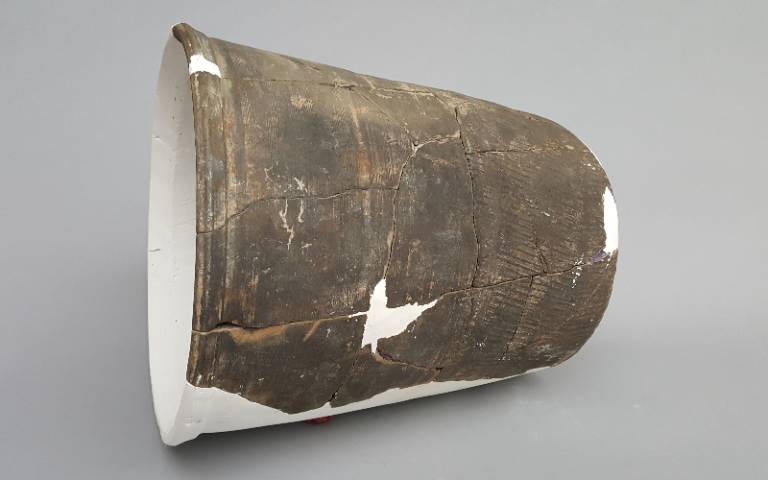
We can and should keep unemployment below 4%, says our survey of top economists

Australia’s leading economists believe Australia can sustain an unemployment rate as low as 3.75% – much lower than the latest Reserve Bank estimate of 4.25% and the Treasury’s latest estimate of 4.5%.
This finding, in an Economic Society of Australia poll of 51 leading economists selected by their peers, comes ahead of next month’s release of a government employment white paper, and an expected direction from Treasurer Jim Chalmers that the Reserve Bank quantify its official employment target.
Asked what unemployment rate was most consistent with “full employment” under present policy settings, the 46 respondents who were prepared to pick a number or range picked an average rate of 3.75%.
The median (middle) response was higher, but still below official estimates – an unemployment rate of 4%.
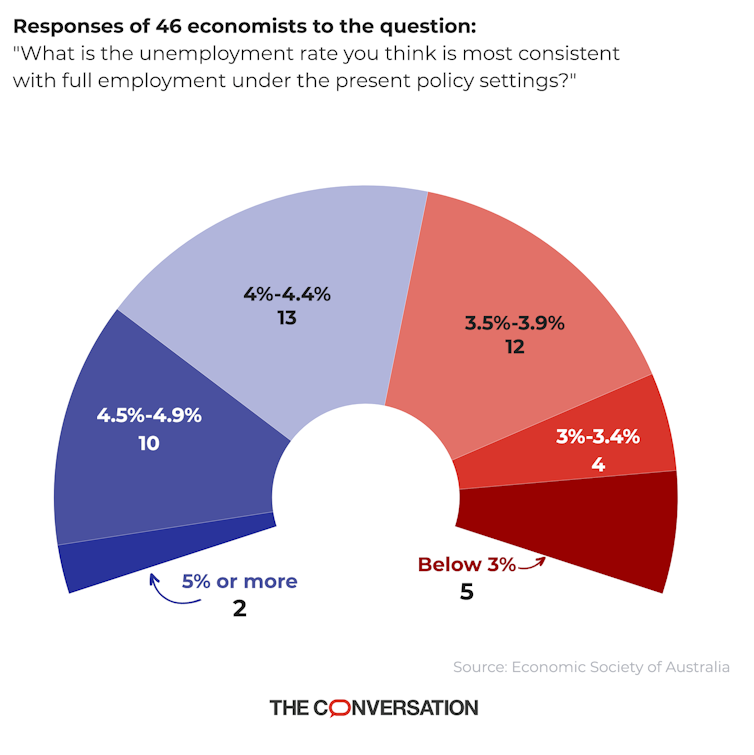
Significantly, only two of the economists surveyed picked an unemployment rate of 5% or higher, which is where Australia’s unemployment rate has been for most of the past five decades.
The 3.75% average implies either that the Reserve Bank and government have lacked ambition on employment for much of the past half-century, or that the sustainable unemployment rate has fallen.
Australia’s unemployment rate dived to 3.5% in mid-2022 and has remained close to that long-term low since.
The survey result suggests the government can lock in the present historic low and need not – and should not – allow unemployment to climb too far from its present rate.
Many of the experts surveyed questioned the idea of a “magic number” or non-accelerating inflation rate of unemployment (NAIRU) used by the Treasury and the Reserve Bank as a guide to how low unemployment can go without feeding inflation.
Former OECD official Adrian Blundell-Wignall said the concept was not helpful “even in the short run, and certainly not the long run” because NAIRU kept changing depending on what else was going on in the domestic and global economy.
Any rate of unemployment would have a different implication for inflation depending on what the government was doing with tax and spending policy.
Geopolitical events and climate change have probably pushed up the rate of inflation to be expected from any given domestic unemployment rate.
3.5% Unemployment, Yet Falling Inflation
Craig Emerson, a former minister in the Rudd and Gillard governments, said NAIRU was best described as the lowest unemployment rate consistent with inflation not taking off. Given Australia’s inflation rate is now coming down, NAIRU is clearly below the present unemployment rate of 3.5%, he argued.
The University of Queensland’s John Quiggin said Australia can be considered to have full employment when the number of job vacancies matches the number of unemployed people. This is the case at present, suggesting “full employment” means an unemployment rate of 3.5%.
Alison Preston from the University of Western Australia said industrial relations changes have given workers much less power to obtain higher wages than before, suggesting the “non-inflation accelerating rate of unemployment” was either lower than before or an irrelevant concept.
Curtin University’s Harry Bloch says there will always be a mismatch between the jobs on offer and the skills available – an academic can’t do the work of a plumber, or vice versa, for instance. But even so, he says it ought to be possible to get unemployment down to the 2% achieved repeatedly during the 1950s and 1960s.
Consulting economist Rana Roy says in normal times “full employment” probably meant an unemployment rate near 1%, but the business cycle meant there would always be brief – “and I stress brief” – periods when governments might have to accept an unemployment rate of nearer 2%.
Fix Education, Job-Matching And Childcare
Asked to select the three measures from a list of 11 that would do the most to bring down the sustainable rate of unemployment, the 51 experts overwhelmingly backed improving the quality of school education (55%), followed by improving employment services (39%) and cutting out-of-pocket childcare costs (39%).
There was also strong support for relaxing industrial relations to give employers greater flexibility (33%) and winding back taxes and regulations facing businesses (24%) as well as boosting enrolments in tertiary education (27%).
There was very little support for cutting immigration or the JobSeeker payment.
Labour market specialist Sue Richardson said a high-quality job-matching service would both reduce unemployment and boost productivity because Australians would be matched to jobs for which they were best suited.
The unemployed who would benefit the most would be those further down the queue who were the least successful in finding jobs.
Industry economist Julie Toth said digital technologies and working from home were already making it easier to match Australians with jobs across a range of industries, and it was important to preserve these recent gains.
One of the panellists, Peter Tulip from the Centre for Independent Studies, rejected all the options offered for lowering the achievable unemployment rate, and said the only one that might have some effect was restraint when increasing minimum wages.
Another, Brian Dollery from the University of New England, said much of Australia’s unemployment had been generated by unemployment benefits that were too high.
Together, the results of the survey call for the government and the Reserve Bank to be ambitious about unemployment, and not to accept a rate above 4%.
The government’s employment white paper is due by the end of September.
Individual responses. Click to open:
![]()
Peter Martin, Visiting Fellow, Crawford School of Public Policy, Australian National University
This article is republished from The Conversation under a Creative Commons license. Read the original article.
Urban sprawl is ‘not a dirty word’? If the priority is to meet all kids’ needs, it should be
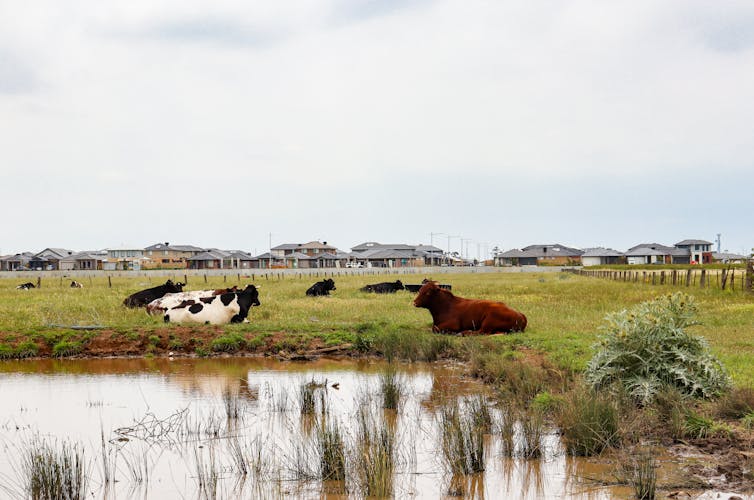
Amid Australia’s housing crisis, land-supply slogans are once again dominating discussions about the solutions. Governments and private developers often blame housing crises on lack of land for new housing. Their solution? Rezone farmland for housing on the suburban fringe.
Earlier this year, the South Australian government announced the state’s largest ever release of land for housing. Some 23,700 houses are to be built on the fringe of Adelaide. SA Premier Peter Malinauskas has even said urban sprawl “is not a dirty word”.
Support for the creation of fringe suburbs, while still business as usual in Australia, reflects outdated views. [Evidence] of the need to halt urban sprawl is now overwhelming. The spruiking of these greenfield developments as affordable and good for young families with children is at odds with their experiences of these developments.
What Life Is Actually Like On The Suburban Fringe
Greenfield developments are often attractive to young families due to the perception of affordable housing and promises of local schools, childcare, shops and public transport. However, these neighbourhoods rarely live up to such expectations. Instead, they often entrench disadvantage due to the neglect of transport costs when assessing how affordable suburban housing is.
Families in Truganina and Tarneit in Melbourne’s west exemplify the daily struggles of outer suburban life. Nearly a decade after moving in, the promises of local schools and public transport had failed to materialise.
Likewise, in the outer suburbs of Western Sydney, Brisbane and Adelaide, families with children struggle to get to the services they need without a car. In South Australia, the Thrive by Five alliance cites transport as the second-biggest barrier (after attendance costs) to early learning.
These suburbs all provide stark reminders to governments of the problems associated with the suburban sprawl they have encouraged.
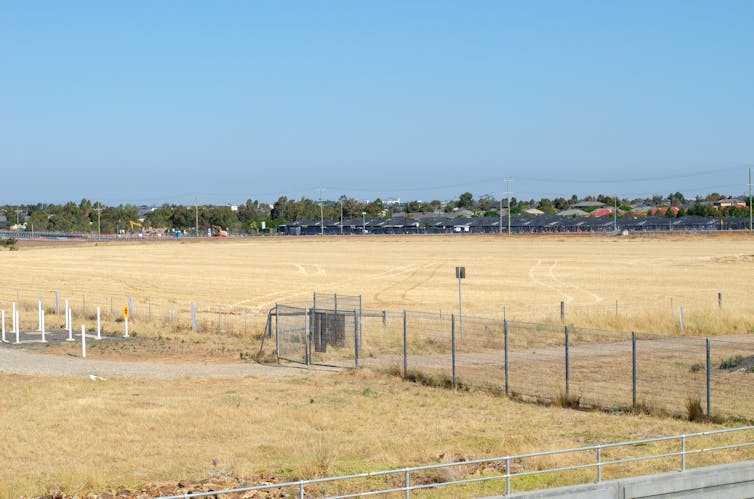
Suburban Sprawl And Car Dependence Go Hand In Hand
The defining feature of suburban sprawl is car dependence. It’s linked with most of the social and economic downsides of sprawl. Continuing with such developments signals an acceptance of car dependence and the growing social and economic burdens it imposes on future generations.
Life on the fringe without a private car is particularly difficult for families with children due to their complex travel patterns. For example, trip chaining between children’s schools, extra-curricular activities and parents’ workplaces is common.
The harmful impacts of these car-centric suburbs disproportionally affect children.
To start with, road deaths are the leading cause of death for children and young adults globally. It’s easily one of the most underestimated issues in our world.
Concerns for children’s safety in car-dominated neighbourhoods and other accessibility issues make the private car “a must use tool” in outer suburbs. We know the rest: the vicious cycle of car dependence and more and more driving.
So suburban sprawl leads to more high-speed roads, longer distances between centres of daily activity and more time in cars. All these factors increase the risk of road deaths and injuries.
Car-dependent neighbourhoods deprive children of opportunities essential for their health and wellbeing. They miss out on physical activity, unstructured play, social interaction and developing social networks. In addition, traffic noise and air pollution expose them to a wide range of environmental and health problems.
Having A Backyard Doesn’t Meet All Children’s Needs
What does a truly child-friendly neighbourhood look like? It allows for safe and convenient active travel – walking, cycling and “wheeling” (using mobility devices) – as well as public transport, to conduct daily activities. Child-friendliness is embedded in the everyday places, in streets, parks, square and public transport.
But all too often children’s play opportunities are reduced to the tiny backyards that are now common in fringe suburbs. These suburban restrictions are at odds with globally recognised principles of child-friendliness. Backyards alone cannot make up for the lack of access to child care, schools, shops, recreation and health services.
How can we develop better planning policies to create neighbourhoods that properly meet families’ needs? Some policies already exist, such as 15-minute or 20-minute neighbourhoods, to reduce private car use for daily activities. But these policies get sidelined when governments promote suburban sprawl and build more freeways.
These governments should not dismiss the suitability of higher-density living in well-serviced neighbourhoods for families with children. Yes, some densification policies have been blind to the needs of children and their families. However, when done well, high-density settings can be wonderful communities for such families.
With careful planning, many more families could be housed in established areas without having to significantly increase building heights.
Car-Centric Planning Has Failed Families
Car-centric planning dates back to the 1950s. Since then, Australian suburban fringe development has largely failed to create child-friendly neighbourhoods. Given the pro-sprawl political advocacy, the prospects of Adelaide’s largest ever greenfield development being good for children are rather poor, despite some encouraging steps by the government to ensure the new suburbs get adequate infrastructure.
Using aspirations of families with children to justify suburban sprawl is exploitative and misleading. It’s an approach that ignores the real-life challenges residents experience and distracts from government’s responsibility for proper planning.
If governments are serious about the needs of families with children, they could start by acknowledging children’s needs and rights to be able to get to their daily destinations without a car. To deliver neighbourhoods that make this possible, governments need to be bold and decisive in their planning.
Suburban sprawl and car dependence go hand in hand. Our politicians must commit to urban planning where cars are no longer privileged. Otherwise we deny our children basic rights to learn, play and socialise safely in their own neighbourhoods. ![]()
Hulya Gilbert, Lecturer in Planning and Human Geography, La Trobe University and Ian Woodcock, Senior Lecturer in Urbanism, University of Sydney
This article is republished from The Conversation under a Creative Commons license. Read the original article.
Source Of Hidden Consciousness In 'Comatose' Brain Injury Patients Found
NSW Government's BASIX Pause To Help Home Buyers And Builders
Disclaimer: These articles are not intended to provide medical advice, diagnosis or treatment. Views expressed here do not necessarily reflect those of Pittwater Online News or its staff.